Broadcom BRCM1030 802.11g WLAN PCI-E Mini Card User Manual Luke user guide
Broadcom Corporation 802.11g WLAN PCI-E Mini Card Luke user guide
Broadcom >
Contents
- 1. Users Manual
- 2. User Manual
- 3. Manual Statement
- 4. User manual 1 of 2
- 5. User manual 2 of 2
- 6. System User manual
- 7. Manual statement
- 8. User Manual Statement
- 9. Regulatory User Guide
- 10. Bear Manual
- 11. BixbyUG Manual
- 12. Welchs Manual
- 13. User Manual I71C
- 14. User Manual legal part
- 15. User Manual Q44C
- 16. OEM ODM Instruction
- 17. Manual 1
- 18. Manual 2
- 19. Manual 3
- 20. OEM installation guide
- 21. Host user manual
Manual 1

HP TouchSmart User Guide
Antenna House XSL Formatter (Evaluation) http://www.antennahouse.com/
TouchSmart tm2

© Copyright 2009 Hewlett-Packard
Development Company, L.P.
Microsoft and Windows are U.S. registered
trademarks of Microsoft Corporation.
Bluetooth is a trademark owned by its
proprietor and used by Hewlett-Packard
Company under license. SD Logo is a
trademark of its proprietor.
The information contained herein is subject
to change without notice. The only
warranties for HP products and services are
set forth in the express warranty statements
accompanying such products and services.
Nothing herein should be construed as
constituting an additional warranty. HP shall
not be liable for technical or editorial errors
or omissions contained herein.
First Edition: January 2010
Document Part Number: 582064-001
Product notice
This user guide describes features that are
common to most models. Some features
may not be available on your computer.
Antenna House XSL Formatter (Evaluation) http://www.antennahouse.com/

Safety warning notice
WARNING! To reduce the possibility of heat-related injuries or of overheating the computer, do not
place the computer directly on your lap or obstruct the computer air vents. Use the computer only on a
hard, flat surface. Do not allow another hard surface, such as an adjoining optional printer, or a soft
surface, such as pillows or rugs or clothing, to block airflow. Also, do not allow the AC adapter to contact
the skin or a soft surface, such as pillows or rugs or clothing, during operation. The computer and the
AC adapter comply with the user-accessible surface temperature limits defined by the International
Standard for Safety of Information Technology Equipment (IEC 60950).
iii
Antenna House XSL Formatter (Evaluation) http://www.antennahouse.com/

iv Safety warning notice
Antenna House XSL Formatter (Evaluation) http://www.antennahouse.com/

Table of contents
1 Getting started
Charging the battery ............................................................................................................................. 1
Identifying the installed hardware and software ................................................................................... 1
Identifying hardware ............................................................................................................ 1
Identifying software .............................................................................................................. 1
Rotating the display .............................................................................................................................. 2
Finding more information ...................................................................................................................... 3
Locating Help and Support .................................................................................................. 3
Locating regulatory, safety, and environmental notices ....................................................... 3
2 What's next
Creating recovery discs ........................................................................................................................ 4
Connecting to the Internet .................................................................................................................... 4
Updating your antivirus software .......................................................................................................... 4
Getting to know the computer .............................................................................................................. 4
3 Using Instant Web
Starting Instant Web ............................................................................................................................. 6
Starting Microsoft Windows .................................................................................................................. 6
Disabling and enabling HP Instant Web ............................................................................................... 7
4 Features
Components ......................................................................................................................................... 8
Top components .................................................................................................................. 8
TouchPad ............................................................................................................ 8
Lights ................................................................................................................... 9
Keys .................................................................................................................. 10
Front components .............................................................................................................. 10
Right-side components ...................................................................................................... 11
Left-side components ........................................................................................................ 12
Display components .......................................................................................................... 13
Bottom components ........................................................................................................... 14
5 Networking
Choosing an ISP ................................................................................................................................ 15
Using Internet Services & Offers ....................................................................................... 15
Using ISP-provided icons .................................................................................................. 15
v
Antenna House XSL Formatter (Evaluation) http://www.antennahouse.com/

Using the Windows Connect to the Internet Wizard .......................................................... 16
Creating a wireless connection .......................................................................................................... 16
Identifying wireless icons and controls .............................................................................. 16
Identifying wireless and network status icons ................................................... 16
Using the wireless key ...................................................................................... 17
Using Wireless Assistant software .................................................................... 18
Using operating system controls ....................................................................... 18
Connecting to a WLAN ...................................................................................................... 18
Connecting to an existing wireless network ...................................................... 19
Setting up a wireless network ........................................................................... 19
Step 1: Purchase high-speed Internet service .................................. 20
Step 2: Purchase and install a wireless router ................................. 20
Step 3: Configure the computer to connect to the wireless
network ............................................................................................. 20
Protecting your WLAN ....................................................................................... 21
Roaming to another network ............................................................................. 21
Using HP Mobile Broadband ............................................................................................. 21
Inserting a SIM .................................................................................................. 22
Removing a SIM ................................................................................................ 23
Using Bluetooth wireless devices ...................................................................................... 24
Bluetooth and Internet Connection Sharing (ICS) ............................................. 24
Connecting to a wired network ........................................................................................................... 25
6 Pointing devices and keyboard
Using pointing devices ....................................................................................................................... 26
Setting pointing device preferences ................................................................................... 26
Using the TouchPad .......................................................................................................... 26
Using TouchPad gestures ................................................................................. 26
Scrolling ............................................................................................ 26
Pinching ............................................................................................ 27
Rotating ............................................................................................ 27
Using the digitizer pen ........................................................................................................................ 28
Identifying the pen components ......................................................................................... 28
Holding the pen .................................................................................................................. 28
Storing the pen .................................................................................................................. 28
Using the touch screen ...................................................................................................................... 29
Tapping (or clicking) .......................................................................................................... 29
Flicking ............................................................................................................................... 29
Dragging ............................................................................................................................ 30
Scrolling ............................................................................................................................. 30
Rotating ............................................................................................................................. 30
Pinching ............................................................................................................................. 31
Setting touch screen preferences ...................................................................................... 32
Using the action keys ......................................................................................................................... 32
vi
Antenna House XSL Formatter (Evaluation) http://www.antennahouse.com/

Using the hotkeys ............................................................................................................................... 33
7 Multimedia
Using the media activity keys ............................................................................................................. 35
Multimedia software ........................................................................................................................... 36
Using HP TouchSmart software or HP MediaSmart software ........................................... 36
Using multimedia software ................................................................................................. 36
Installing multimedia software from a disc ......................................................................... 37
Audio .................................................................................................................................................. 37
Adjusting the volume ......................................................................................................... 37
Connecting external audio devices .................................................................................... 38
Webcam ............................................................................................................................................. 38
Adjusting webcam properties ............................................................................................. 39
Video .................................................................................................................................................. 40
Using the external monitor port .......................................................................................... 40
Connecting an HDMI device .............................................................................................. 40
Configuring audio for HDMI ............................................................................... 41
8 Power management
Shutting down the computer ............................................................................................................... 42
Setting power devices ........................................................................................................................ 42
Using power-saving states ................................................................................................. 42
Initiating and exiting Sleep ................................................................................ 43
Initiating and exiting Hibernation ....................................................................... 43
Conserving power .............................................................................................................. 44
Using the battery meter ..................................................................................................... 44
Using power plans ............................................................................................................. 44
Viewing the current power plan ......................................................................... 44
Selecting a different power plan ........................................................................ 44
Customizing power plans .................................................................................. 45
Setting password protection on wakeup ............................................................................ 45
Using battery power ........................................................................................................................... 45
Finding battery information in Help and Support ............................................................... 46
Using Battery Check .......................................................................................................... 46
Displaying the remaining battery charge ........................................................................... 46
Removing or inserting the battery ...................................................................................... 46
Charging a battery ............................................................................................................. 47
Maximizing battery discharge time .................................................................................... 48
Managing low battery levels .............................................................................................. 48
Identifying low battery levels ............................................................................. 48
Resolving a low battery level ............................................................................. 49
Resolving a low battery level when external power is available ....... 49
vii
Antenna House XSL Formatter (Evaluation) http://www.antennahouse.com/

Resolving a low battery level when a charged battery is
available ........................................................................................... 49
Resolving a low battery level when no power source is
available ........................................................................................... 49
Resolving a low battery level when the computer cannot exit
Hibernation ....................................................................................... 49
Calibrating a battery ........................................................................................................... 49
Storing a battery ................................................................................................................ 49
Disposing of a used battery ............................................................................................... 50
Replacing the battery ......................................................................................................... 50
Using external AC power .................................................................................................................... 50
Connecting AC power ........................................................................................................ 50
Testing an AC adapter ....................................................................................................... 51
9 External devices
Using Digital Media Slot cards ........................................................................................................... 52
Inserting a digital card ........................................................................................................ 52
Removing a digital card ..................................................................................................... 53
Using a USB device ........................................................................................................................... 53
Connecting a USB device .................................................................................................. 53
Removing a USB device .................................................................................................... 54
10 Drives
Handling drives ................................................................................................................................... 55
Improving hard drive performance ..................................................................................................... 55
Using Disk Defragmenter ................................................................................................... 55
Using Disk Cleanup ........................................................................................................... 56
Using HP ProtectSmart Hard Drive Protection .................................................................................. 56
Identifying HP ProtectSmart Hard Drive Protection status ................................................ 56
Managing power with a parked hard drive ......................................................................... 57
Using HP ProtectSmart Hard Drive Protection software .................................................... 57
Inserting and removing a hard drive ................................................................................................... 58
Using external drives .......................................................................................................................... 60
Connecting optional external drives ................................................................................... 60
Using an external optical drive ........................................................................................... 60
Removing an optical disc when the disc tray will not open ............................... 61
Sharing an optical drive ...................................................................................................................... 61
11 Memory modules
12 Security
Protecting the computer ..................................................................................................................... 66
Using passwords ................................................................................................................................ 66
viii
Antenna House XSL Formatter (Evaluation) http://www.antennahouse.com/

Setting passwords in Windows .......................................................................................... 67
Setting passwords in Setup Utility ..................................................................................... 67
Administrator password ..................................................................................... 68
Managing an administrator password ............................................... 68
Entering an administrator password ................................................. 68
Power-on password .......................................................................................... 68
Managing a power-on password ...................................................... 69
Entering a power-on password ......................................................... 69
Using antivirus software ..................................................................................................................... 69
Using firewall software ....................................................................................................................... 69
Installing critical security updates ....................................................................................................... 70
Installing an optional security cable .................................................................................................... 70
Using the fingerprint reader (select models only) ............................................................................... 71
Registering fingerprints ...................................................................................................... 71
Using your registered fingerprint to log on to Windows ..................................................... 72
13 Backup and recovery
Creating recovery discs ...................................................................................................................... 73
Backing up your information ............................................................................................................... 74
Using Windows Backup and Restore ................................................................................ 75
Using system restore points .............................................................................................. 75
When to create restore points ........................................................................... 75
Create a system restore point ........................................................................... 75
Restore to a previous date and time ................................................................. 75
Performing a recovery ........................................................................................................................ 76
Recovering from the recovery discs .................................................................................. 76
Recovering from the dedicated recovery partition (select models only) ............................ 76
14 Setup Utility (BIOS)
Starting Setup Utility ........................................................................................................................... 77
Using Setup Utility .............................................................................................................................. 77
Changing the language of Setup Utility ............................................................................. 77
Navigating and selecting in Setup Utility ............................................................................ 78
Displaying system information ........................................................................................... 78
Restoring default settings in Setup Utility .......................................................................... 78
Exiting Setup Utility ............................................................................................................ 79
Setup Utility Menus ............................................................................................................................ 79
Main menu ......................................................................................................................... 79
Security menu .................................................................................................................... 79
System Configuration menu .............................................................................................. 79
Diagnostics menu .............................................................................................................. 80
Updating the BIOS ............................................................................................................................. 80
Updating the BIOS ............................................................................................................. 80
ix
Antenna House XSL Formatter (Evaluation) http://www.antennahouse.com/

Determining the BIOS version ........................................................................... 80
Downloading a BIOS update ............................................................................. 81
Appendix A Product information
Input power ......................................................................................................................................... 83
Operating environment ....................................................................................................................... 83
Traveling with the computer ............................................................................................................... 84
Routine care ....................................................................................................................................... 84
Cleaning the display .......................................................................................................... 84
Cleaning the TouchPad and keyboard .............................................................................. 85
Labels ................................................................................................................................................. 85
Appendix B Troubleshooting
Quick troubleshooting ......................................................................................................................... 87
The computer is unable to start up .................................................................................... 87
The TouchPad is behaving erratically ................................................................................ 87
The computer screen is blank ............................................................................................ 87
Software is functioning abnormally .................................................................................... 88
The computer is on but is not responding .......................................................................... 88
The computer is unusually warm ....................................................................................... 88
Checking your audio functions ........................................................................................... 88
An external device is not working ...................................................................................... 89
The wireless network connection is not working ................................................................ 89
Cannot connect to a preferred network ............................................................................. 90
Network icon for WLAN is not displayed ............................................................................ 90
Current WLAN network security codes are unavailable .................................................... 90
WLAN connection is very weak ......................................................................................... 91
Cannot connect to the wireless router ............................................................................... 91
Contacting customer support ............................................................................................................. 91
Index ................................................................................................................................................................... 92
x
Antenna House XSL Formatter (Evaluation) http://www.antennahouse.com/
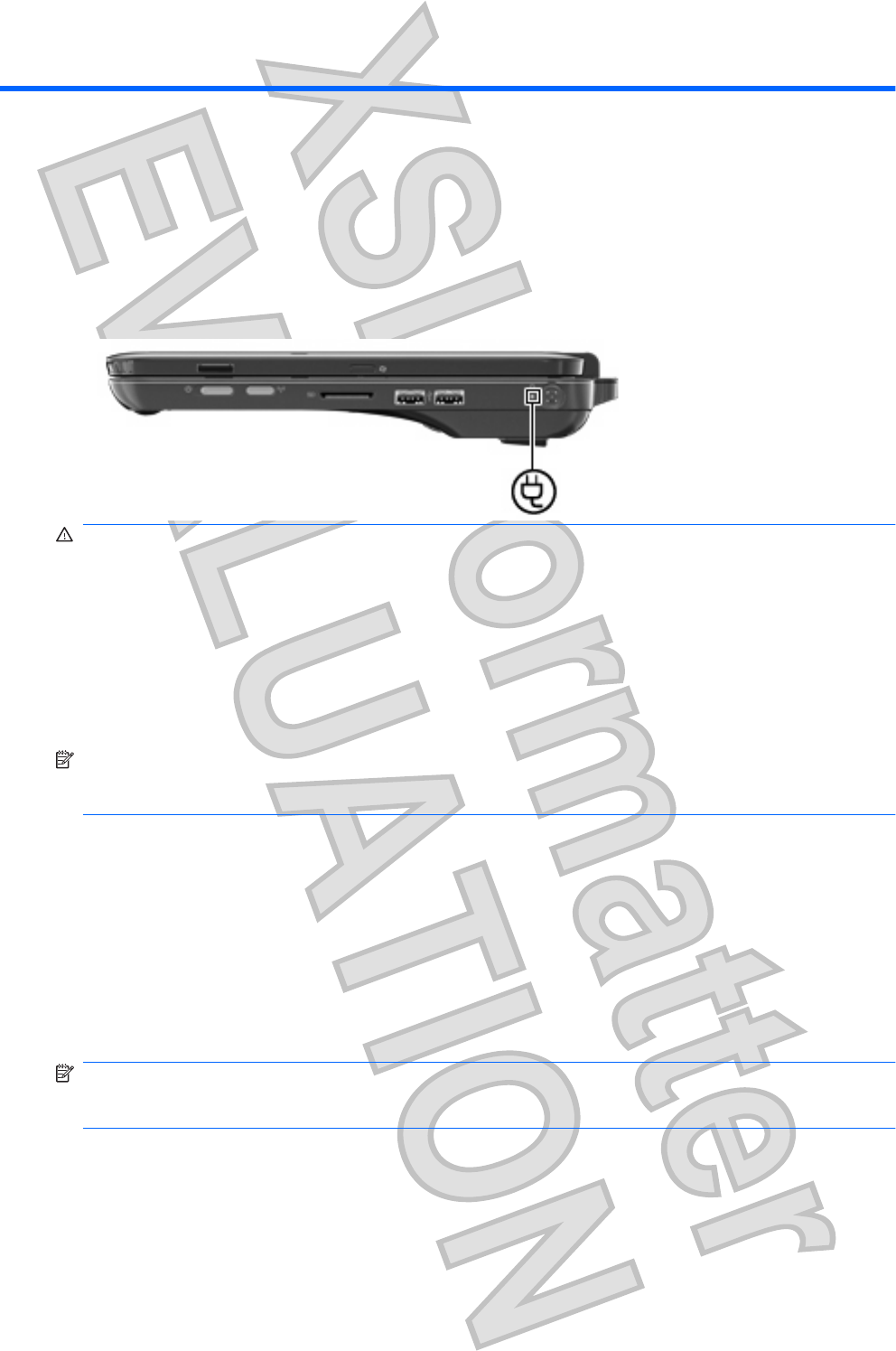
1 Getting started
Charging the battery
To fully charge the battery, leave the computer plugged into external power until the battery light on the
computer turns white.
WARNING! To reduce the risk of electric shock or damage to your equipment, observe these
guidelines:
Plug the power cord into an AC outlet that is easily accessible at all times.
Disconnect power from the computer by unplugging the power cord from the AC outlet (not by
unplugging the power cord from the computer).
If provided with a 3-pin attachment plug on your power cord, plug the cord into a grounded (earthed) 3-
pin outlet. Do not disable the power cord grounding pin, for example, by attaching a 2-pin adapter. The
grounding pin is an important safety feature.
NOTE: A partially charged new battery can run the computer after software setup is complete, but
battery charge displays will not be accurate until the new battery has been fully charged. The battery
light turns white when the battery is fully charged.
Identifying the installed hardware and software
Identifying hardware
To see a list of hardware installed in the computer:
Select Start > Control Panel > System and Security. Then in the System area, click Device
Manager.
You can also add hardware or modify device configurations using Device Manager.
NOTE: Windows® includes the User Account Control feature to improve the security of your computer.
You may be prompted for your permission or password for tasks such as installing applications, running
utilities, or changing Windows settings. Refer to Help and Support for more information.
Identifying software
To see a list of the software installed on the computer:
Select Start > All Programs.
Charging the battery 1
Antenna House XSL Formatter (Evaluation) http://www.antennahouse.com/
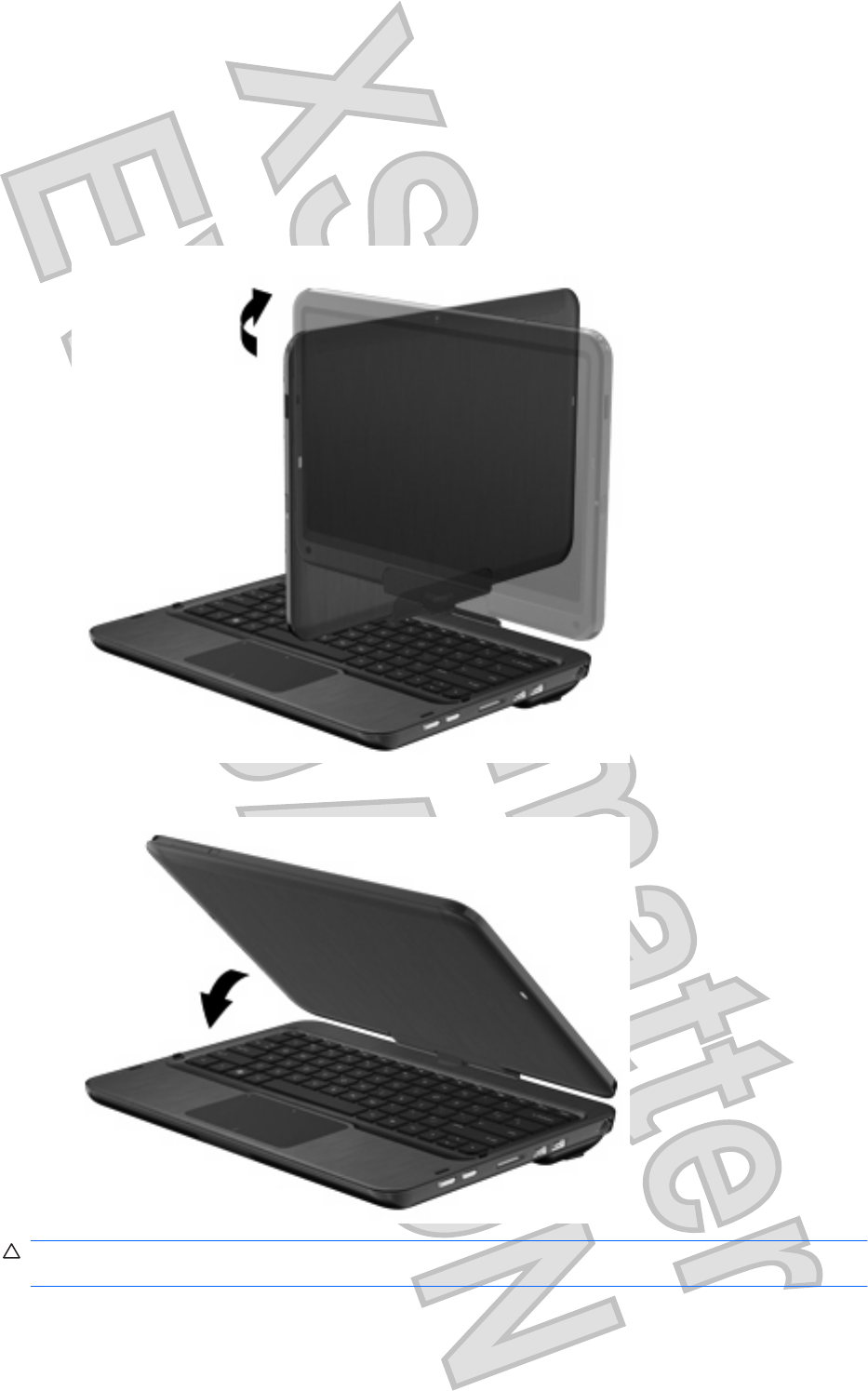
Rotating the display
To use the computer in slate mode:
1. Open the display.
2. Rotate the display clockwise 180 degrees.
3. Lower the display over the keyboard.
CAUTION: To reduce the risk of damage to your computer, do not force the display past 180 degrees,
and do not transport the computer while it is in slate mode.
2 Chapter 1 Getting started
Antenna House XSL Formatter (Evaluation) http://www.antennahouse.com/
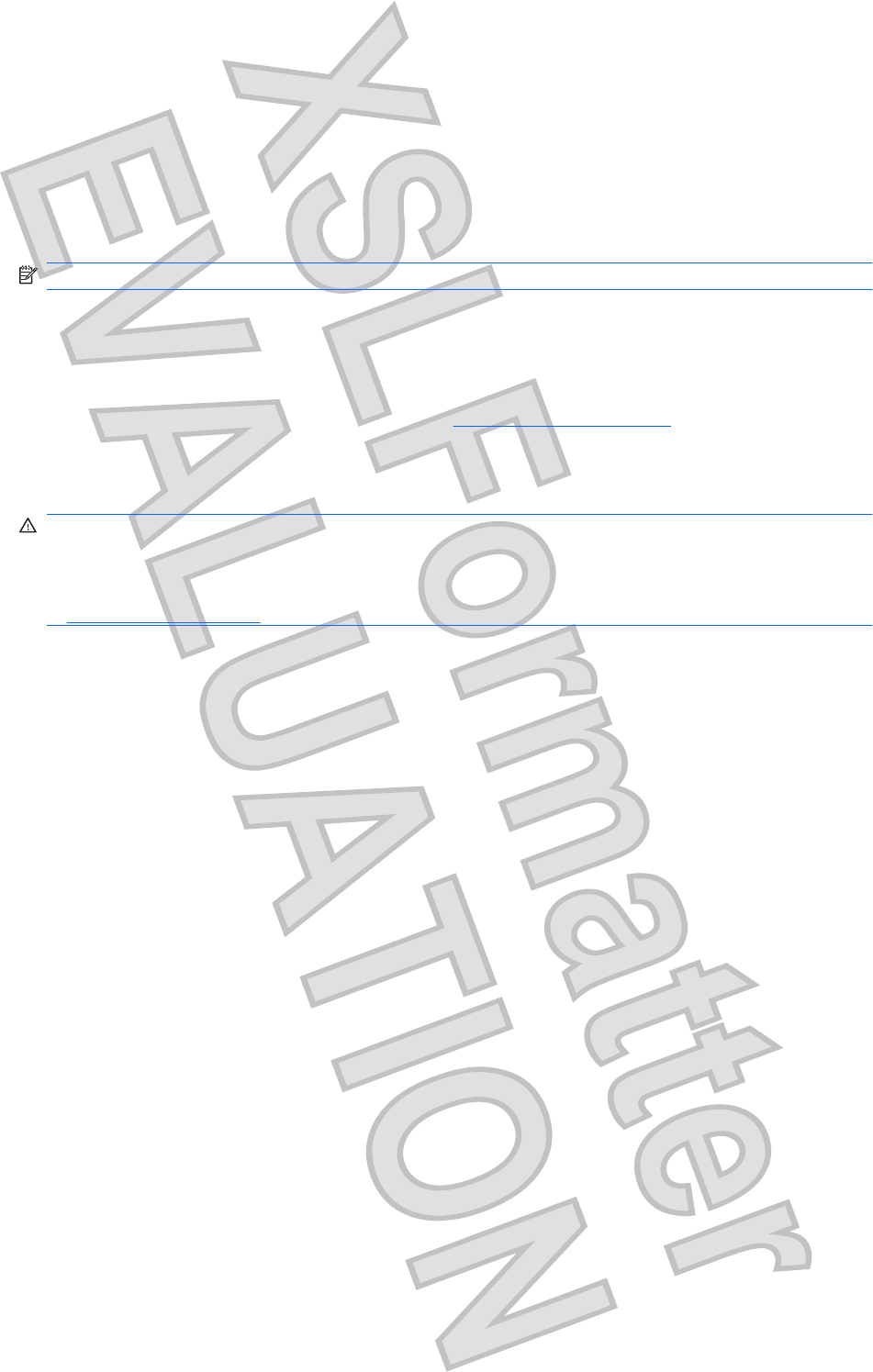
Finding more information
Locating Help and Support
In addition to the user guides, Help and Support provides information about the operating system, power
management, software updates, networking, drivers, troubleshooting tools, and accessing technical
support.
NOTE: You do not need to connect to the Internet to access the user guides in Help and Support.
To access Help and Support:
Select Start > Help and Support.
– or –
For country- or region-specific support, go to http://www.hp.com/support, select your country or
region, and follow the on-screen instructions.
Locating regulatory, safety, and environmental notices
WARNING! To reduce the risk of serious injury, read the Safety & Comfort Guide. It describes proper
workstation setup and proper posture, health, and work habits for computer users. The Safety & Comfort
Guide also provides important electrical and mechanical safety information. To access this guide, select
Start > Help and Support > User Guides. The Safety & Comfort Guide is also available on the Web
at http://www.hp.com/ergo.
For more safety and regulatory information, and for battery disposal information, refer to the Regulatory,
Safety and Environmental Notices.
To access the notices:
Select Start > Help and Support > User Guides.
Finding more information 3
Antenna House XSL Formatter (Evaluation) http://www.antennahouse.com/
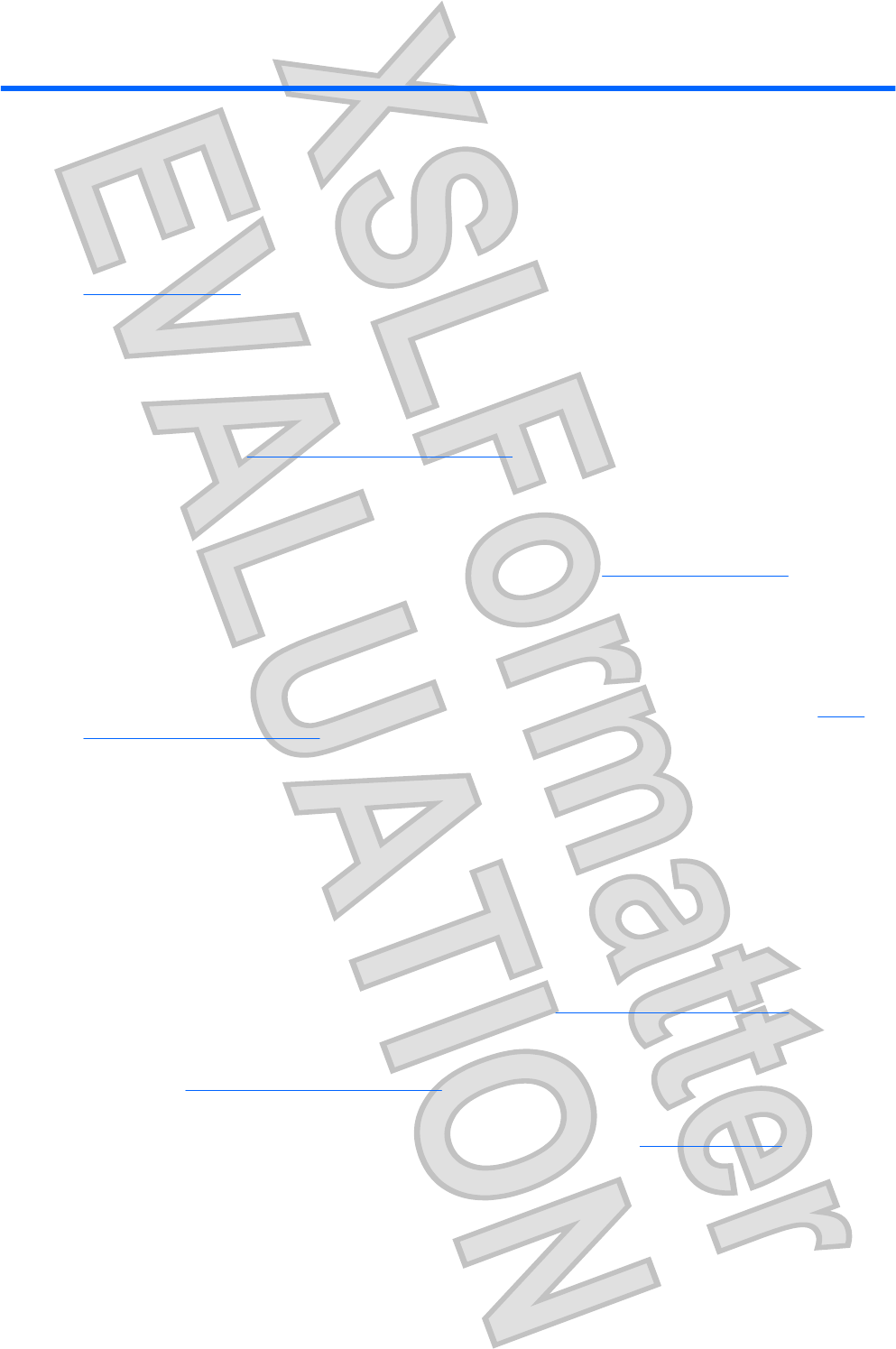
2What's next
After you set up and register the computer, it is important to take the next steps in this chapter before
you begin using the computer. For help in identifying specific components of the computer, refer to
Features on page 8.
Creating recovery discs
After setting up the computer, one of the first and most important steps to take is to create a set of
recovery discs of the full factory image. The recovery discs are essential in case of system instability or
failure, when they are used to recover the operating system and software to factory settings. For
instructions, refer to Backup and recovery on page 73.
Connecting to the Internet
After creating the recovery discs, set up your wired or wireless network so that you can send and receive
e-mail and connect to the Internet. For more information, refer to Networking on page 15.
Updating your antivirus software
After you have connected to the Internet, be sure to update your antivirus software. The software is
preinstalled on the computer and includes a limited subscription for free updates. Antivirus software
helps protect your computer from damage caused by viruses. For more information, refer to Using
antivirus software on page 69.
Getting to know the computer
When you have completed the preceding steps, familiarize yourself with the features of the computer
and set up any additional components, such as optional external audio devices.
The following list highlights the entertainment features of the computer and explains where to get
additional information for each feature.
łHP Instant Web—You can perform many of your favorite activities without the need to start the
main operating system. If you like to browse the Internet, view digital photos, listen to music, or
keep in touch through e-mail, instant messages, or Skype (select models only), you will enjoy the
many features of HP Instant Web. For details, refer to Using Instant Web on page 6.
łMultimedia software—The computer comes with preinstalled multimedia software, including HP
TouchSmart software, which turns the computer into a mobile entertainment center. For details,
refer to Multimedia software on page 36.
łAudio—The computer includes integrated speakers. For more information on using the integrated
speakers and setting up optional external audio devices, refer to Audio on page 37.
4 Chapter 2 What's next
Antenna House XSL Formatter (Evaluation) http://www.antennahouse.com/

łVideo—You can connect an optional display device or an HDMI (High Definition Multimedia
Interface) device to the computer. You can also connect an optional optical drive. For more
information about the video features, refer to Video on page 40.
łWebcam—Adjustable, with low-light image technology and built-in microphones, the webcam is a
perfect companion to your instant messaging program. For more information on the webcam, refer
to Webcam on page 38.
Getting to know the computer 5
Antenna House XSL Formatter (Evaluation) http://www.antennahouse.com/
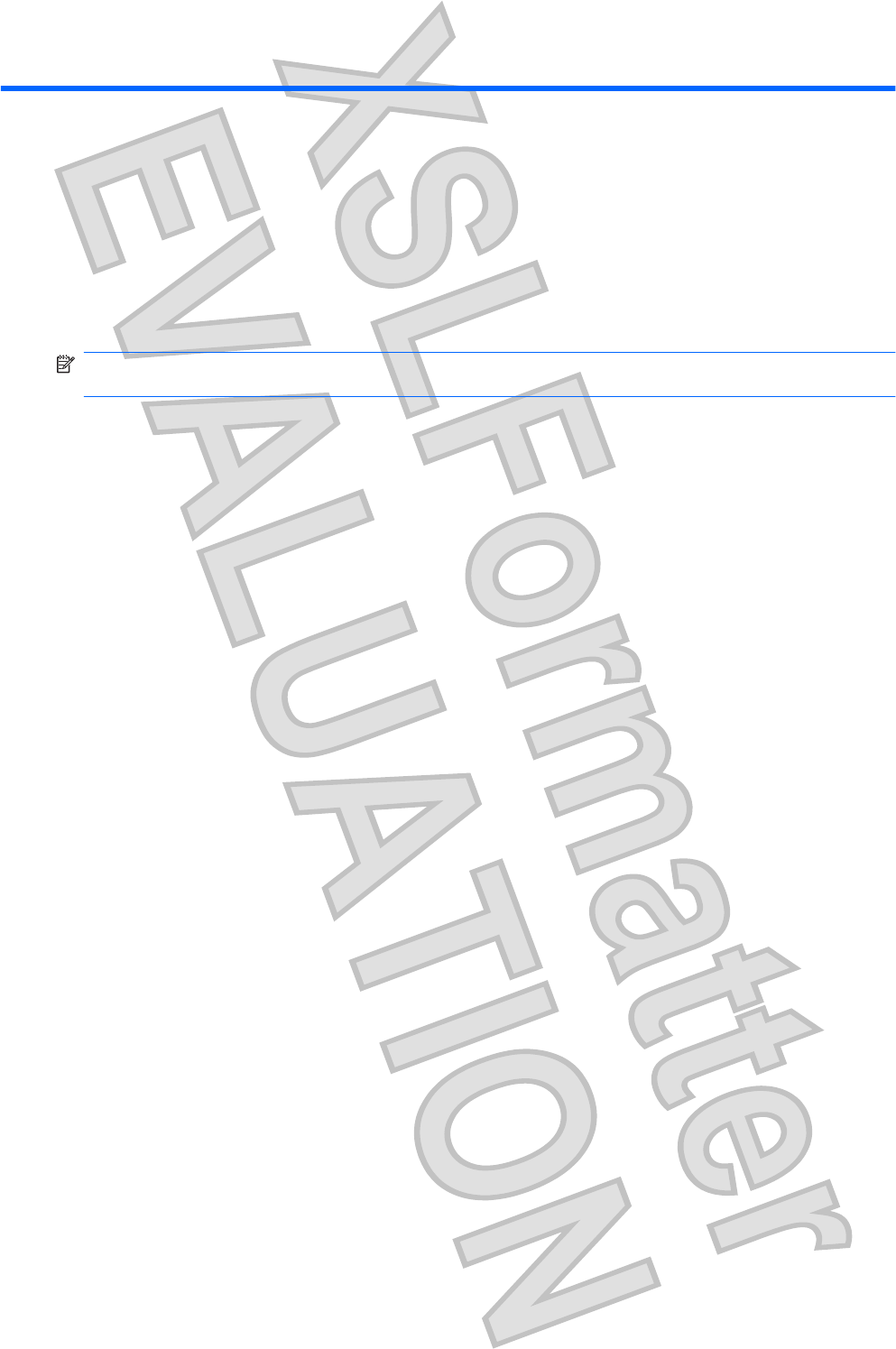
3 Using Instant Web
HP Instant Web provides a fun and engaging way to perform many of your favorite activities. Your
computer is ready to go within seconds of sliding the power switch and you can rapidly access several
applications without the need to start the main operating system. If you like to browse the Internet, view
digital photos, listen to music, or keep in touch through e-mail, instant messages, or Skype (select
models only), you will enjoy the many features of HP Instant Web.
NOTE: Instant Web is an optional, instant-on environment that is separate from your Windows
operating system.
Instant Web includes the following features:
łWeb browser—Browsing the Internet has never been faster or easier. Web browser is optimized
to give you a great Internet experience instantly. Enjoy surfing the Web and bookmarking your
favorite sites at your convenience.
łChat—Access popular Instant Messaging programs such as Google Talk, Windows Live
Messenger, or Yahoo! Messenger to chat with friends.
łSkype (select models only)—Skype is a voice over Internet protocol (VoIP) that lets you
communicate free of charge with other Skype users. Skype permits long-distance phone calls to
land lines and also offers video chat capability.
łWeb e-mail—View your Web-based e-mail using Gmail, Hotmail, Yahoo, and other webmail
providers.
łWeb calendar—Schedule and manage your activities using your favorite online calendar
application.
łMusic Player—Listen to your favorite music files with Music Player. When you are suddenly in the
mood, your favorite tunes are only moments away.
łPhoto Viewer—Browse through photos, create albums, take pictures, and view slide shows using
Photo Viewer. If a picture is worth a thousand words, it is worth even more to view your pictures
when you want to.
For detailed information on Instant Web, refer to the software Help.
Starting Instant Web
To start Instant Web when the computer is powered off:
1. Turn on your computer. The Instant Web Home screen appears.
2. Click an icon on the Instant Web Home screen to launch a program.
Starting Microsoft Windows
To start the main operating system:
1. Click the Windows Start button on the far left of the Instant Web Home screen.
2. A dialog box appears, asking if you are sure you want to start Windows. Click Yes.
6 Chapter 3 Using Instant Web
Antenna House XSL Formatter (Evaluation) http://www.antennahouse.com/
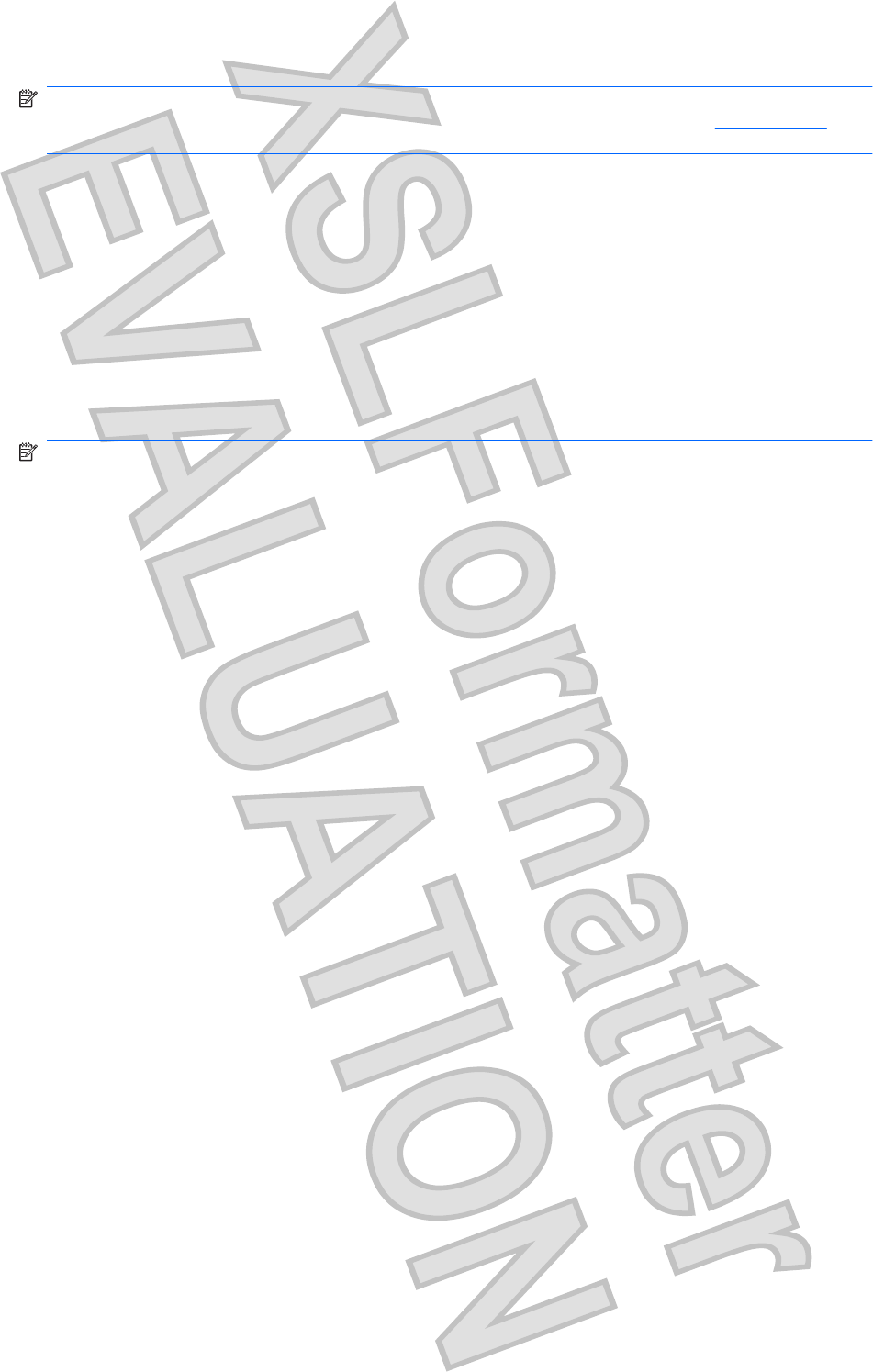
NOTE: Clicking on the Make Windows your default Power On experience in this dialog box disables
Instant Web. For more information on disabling and enabling Instant Web, refer to Disabling and
enabling HP Instant Web on page 7.
Disabling and enabling HP Instant Web
You can disable or reenable Instant Web in two ways.
To disable or reenable Instant Web from the Windows operating system:
1. Click Start > All Programs > HP Instant Web. The HP Instant Web Installer folder displays.
2. Click HP Instant Web Configuration Tool.
3. Select the Enable HP Instant Web check box.
4. Click OK.
NOTE: The HP Instant Web Configuration Tool can also accessed by clicking Start > Control
Panel.
To disable or reenable Instant Web from within Setup Utility:
1. Open Setup Utility by turning on or restarting the computer. Immediately press f10 repeatedly to
enter Setup Utility.
2. Use the arrow keys to select System Configuration.
3. Use the down arrow key to select HP Instant Web Support, and then press enter.
4. Use the arrow key to select Enable or Disable, and then press enter.
5. Press enter to confirm your change.
6. To save your change and exit Setup Utility, use the arrow keys to select Exit, select Exit Saving
Changes, and then press enter.
Disabling and enabling HP Instant Web 7
Antenna House XSL Formatter (Evaluation) http://www.antennahouse.com/
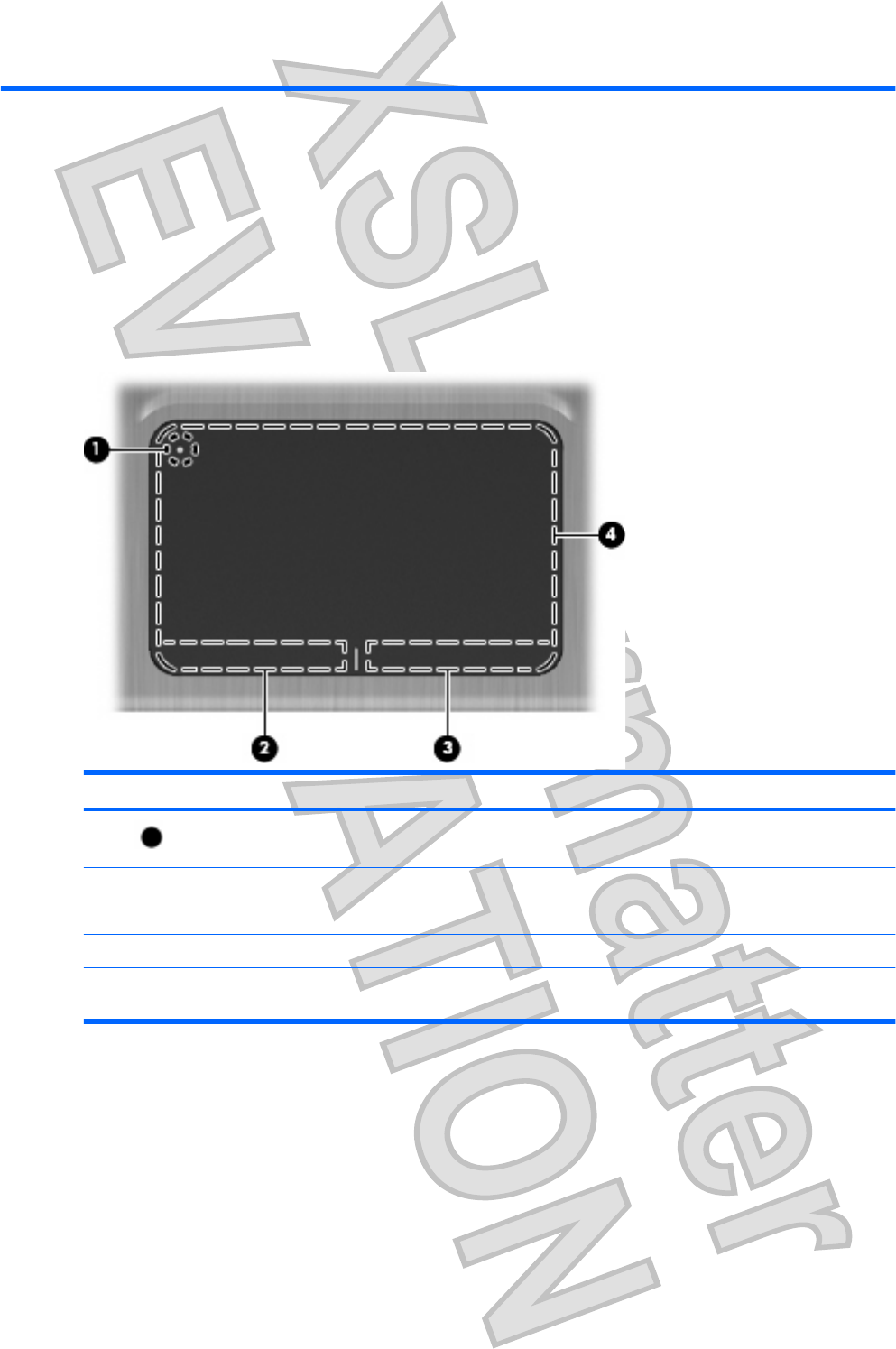
4Features
Components
Top components
TouchPad
Component Description
(1) TouchPad on/off button Turns the TouchPad on and off. Lightly press the button and hold
for 3 seconds to turn the TouchPad on and off.
(2) Left TouchPad button* Functions like the left button on an external mouse.
(3) Right TouchPad button* Functions like the right button on an external mouse.
(4) TouchPad* Moves the pointer and selects or activates items on the screen.
*This table describes factory settings. To view and change pointing device preferences, select Start > Devices and Printers.
Then, right-click the device representing your computer, and select Mouse settings.
8 Chapter 4 Features
Antenna House XSL Formatter (Evaluation) http://www.antennahouse.com/


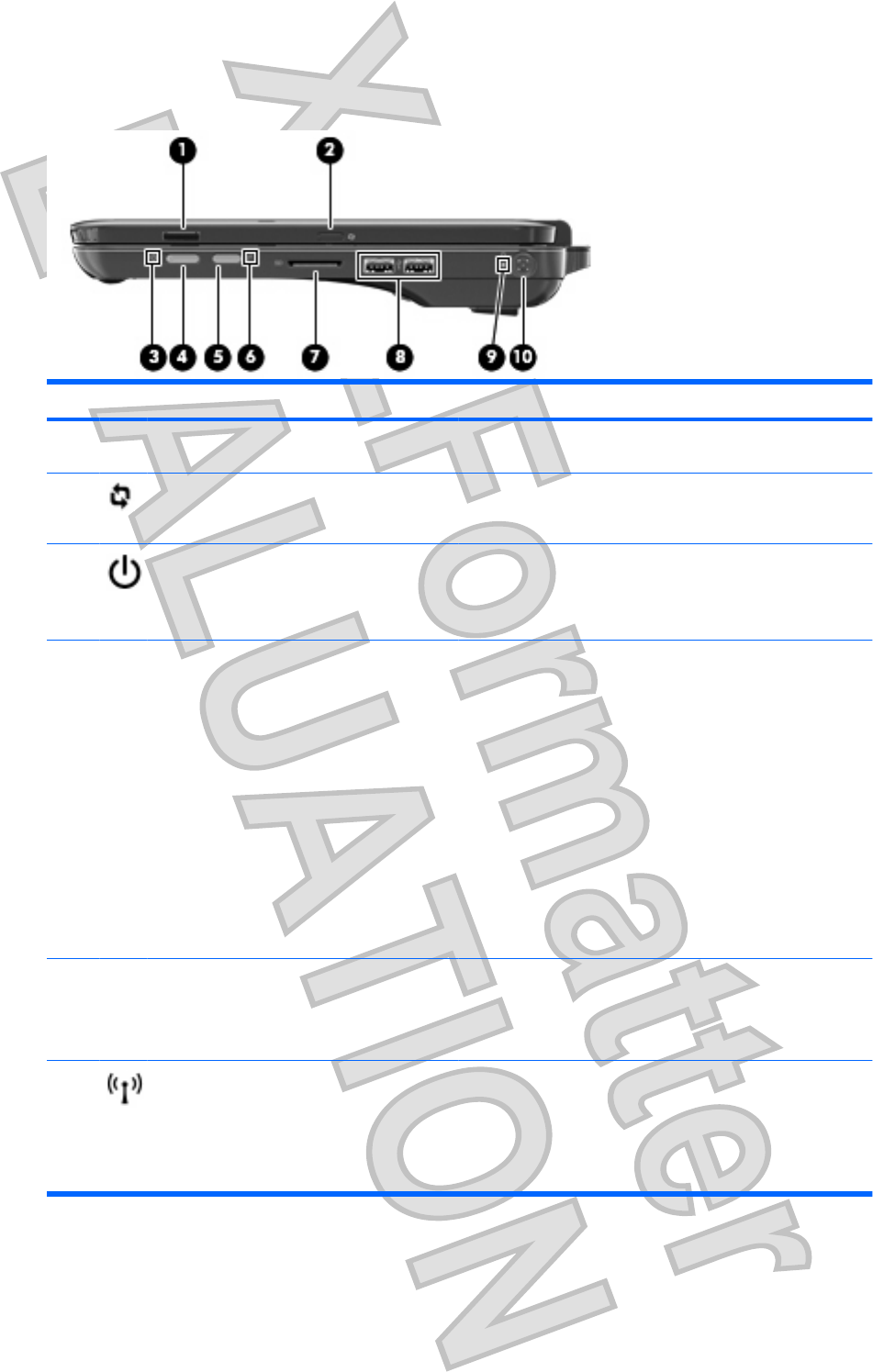
Right-side components
Component Description
(1) Fingerprint reader Allows a fingerprint logon to Windows instead of a password
logon.
(2) Rotate button Rotates the screen image counter-clockwise into 4
orientations: landscape primary, portrait primary, landscape
secondary, and portrait secondary.
(3) Power light łWhite: The computer is on.
łBlinking white: The computer is in the Sleep state.
łOff: The computer is off or in Hibernation.
(4) Power switch łWhen the computer is off, slide the power switch to turn
on the computer.
łWhen the computer is on, briefly slide the power switch
to exit Sleep.
łWhen the computer is in the Sleep state, briefly slide the
power switch to exit Sleep.
łWhen the computer is in Hibernation, briefly slide the
power switch to exit Hibernation.
If the computer has stopped responding and Windows®
shutdown procedures are ineffective, slide and hold the power
switch for at least 5 seconds to turn off the computer.
To learn more about your power settings, select Start >
Control Panel > System and Security > Power Options.
(5) Wireless button Turns the wireless feature on or off, but does not establish a
wireless connection.
NOTE: A wireless network must be set up in order to
establish a wireless connection.
(6) Wireless light łOff: An integrated wireless device, such as a wireless
local area network (WLAN) device and/or a Bluetooth®
device, is on.
NOTE: Wireless devices are enabled at the factory.
łAmber: All wireless devices are off.
Components 11
Antenna House XSL Formatter (Evaluation) http://www.antennahouse.com/
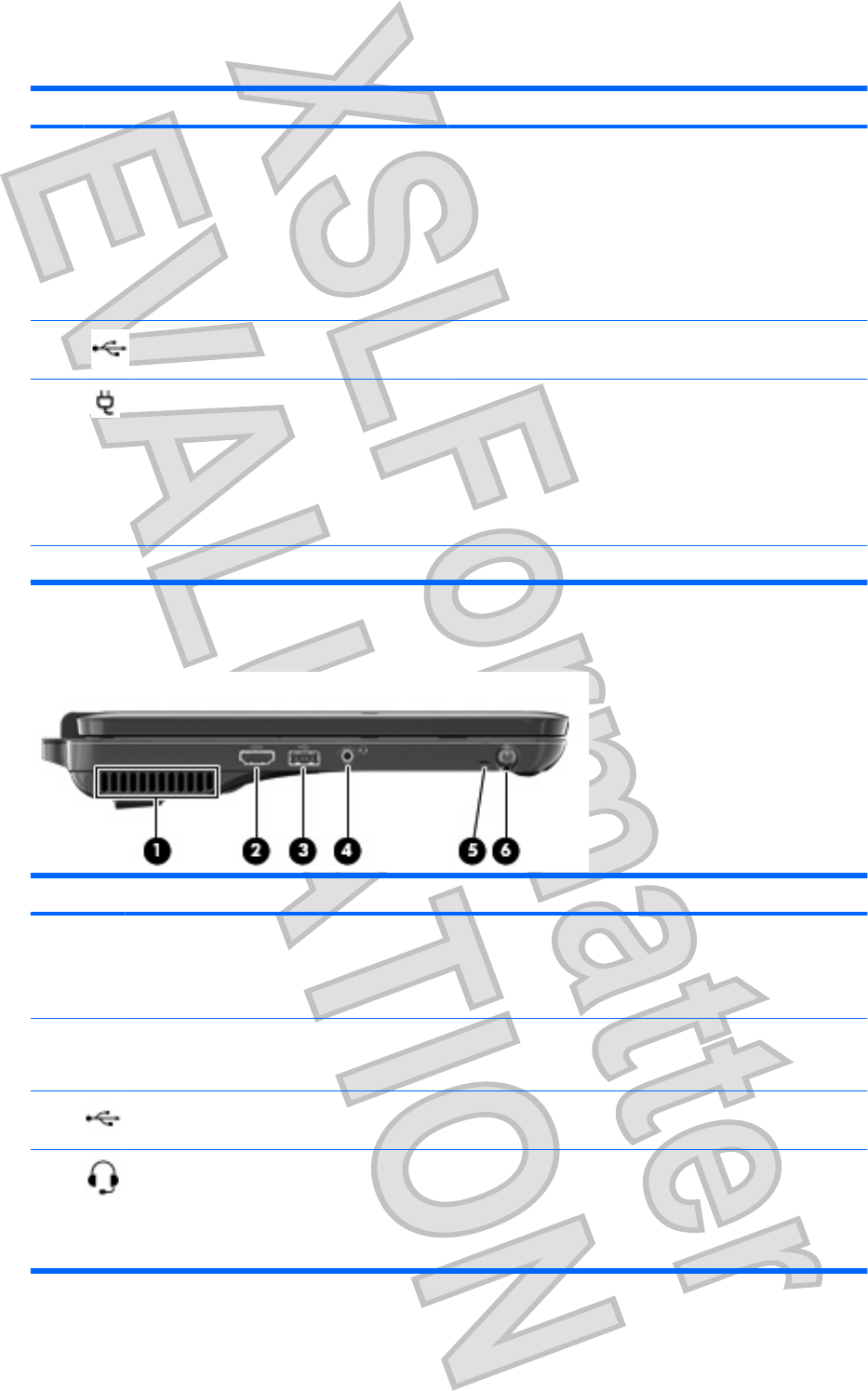
Component Description
(7) Digital Media Slot Supports the following digital card formats:
łMemory Stick
łMemory Stick Pro
łMultiMediaCard
łSecure Digital Memory Card
łxD-Picture Card
(8) USB ports (2) Connect optional USB devices.
(9) Battery light łOff: The computer is running on battery power.
łBlinking amber: The battery has reached a low battery
level, a critical battery level, or there is a battery error.
łAmber: A battery is charging.
łWhite: The computer is connected to external power and
the battery is fully charged.
(10) Power connector Connects an AC adapter.
Left-side components
Component Description
(1) Vent Enables airflow to cool internal components.
NOTE: The computer fan starts up automatically to cool
internal components and prevent overheating. It is normal for
the internal fan to cycle on and off during routine operation.
(2) HDMI port Connects an optional video or audio device, such as a high-
definition television, or any compatible digital or audio
component.
(3) USB port Connects an optional USB device.
(4) Audio-out (headphone) jack/Audio-in
(microphone) jack
Produces sound when connected to optional powered stereo
speakers, headphones, earbuds, a headset, or television audio.
Also connects an optional headset microphone.
NOTE: When a device is connected to the jack, the device
speakers are disabled.
12 Chapter 4 Features
Antenna House XSL Formatter (Evaluation) http://www.antennahouse.com/
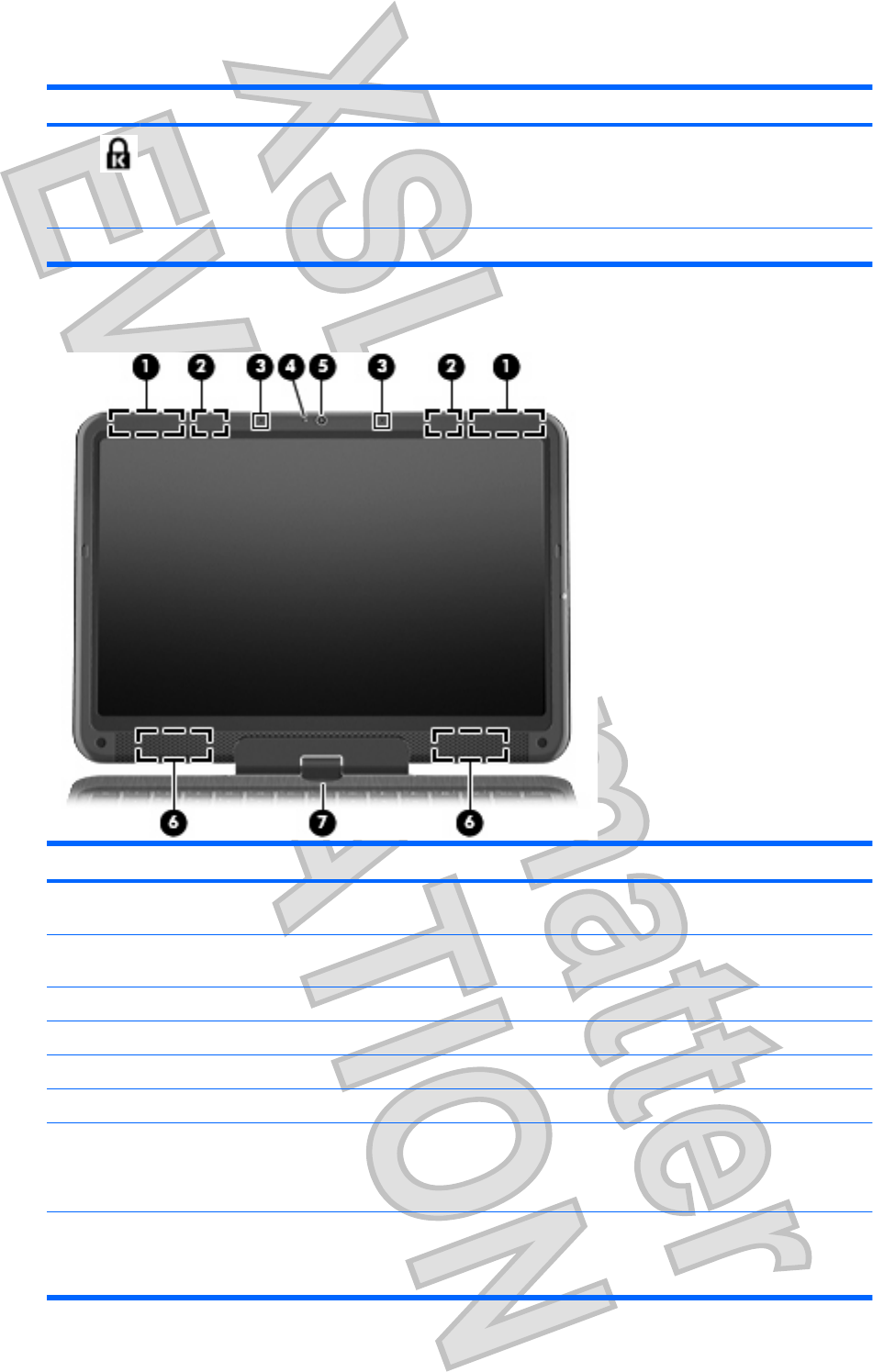
Component Description
(5) Security cable slot Attaches an optional security cable to the computer.
NOTE: The security cable is designed to act as a deterrent,
but it may not prevent the computer from being mishandled or
stolen.
(6) Pen holder Holds the pen.
Display components
Component Description
(1) WWAN antennas (2)* Send and receive wireless signals to communicate with wireless
wide-area networks (WWAN).
(2) WLAN antennas (2)* Send and receive wireless signals to communicate with wireless
local area networks (WLAN).
(3) Internal microphones (2) Record sound.
(4) Webcam light On: The webcam is in use.
(5) Webcam Records video and captures still photographs.
(6) Speakers (2) Produce sound.
(7) Convertible hinge Swivels the display and converts the computer from traditional
notebook mode into slate mode or vice versa. In slate mode, the
display is rotated and folded flat, so that you can view content while
carrying the computer.
*The antennas are not visible from the outside of the computer. For optimal transmission, keep the areas immediately around
the antennas free from obstructions. To see wireless regulatory notices, refer to the section of the Regulatory, Safety and
Environmental Notices that applies to your country or region. These notices are located in Help and Support.
Components 13
Antenna House XSL Formatter (Evaluation) http://www.antennahouse.com/
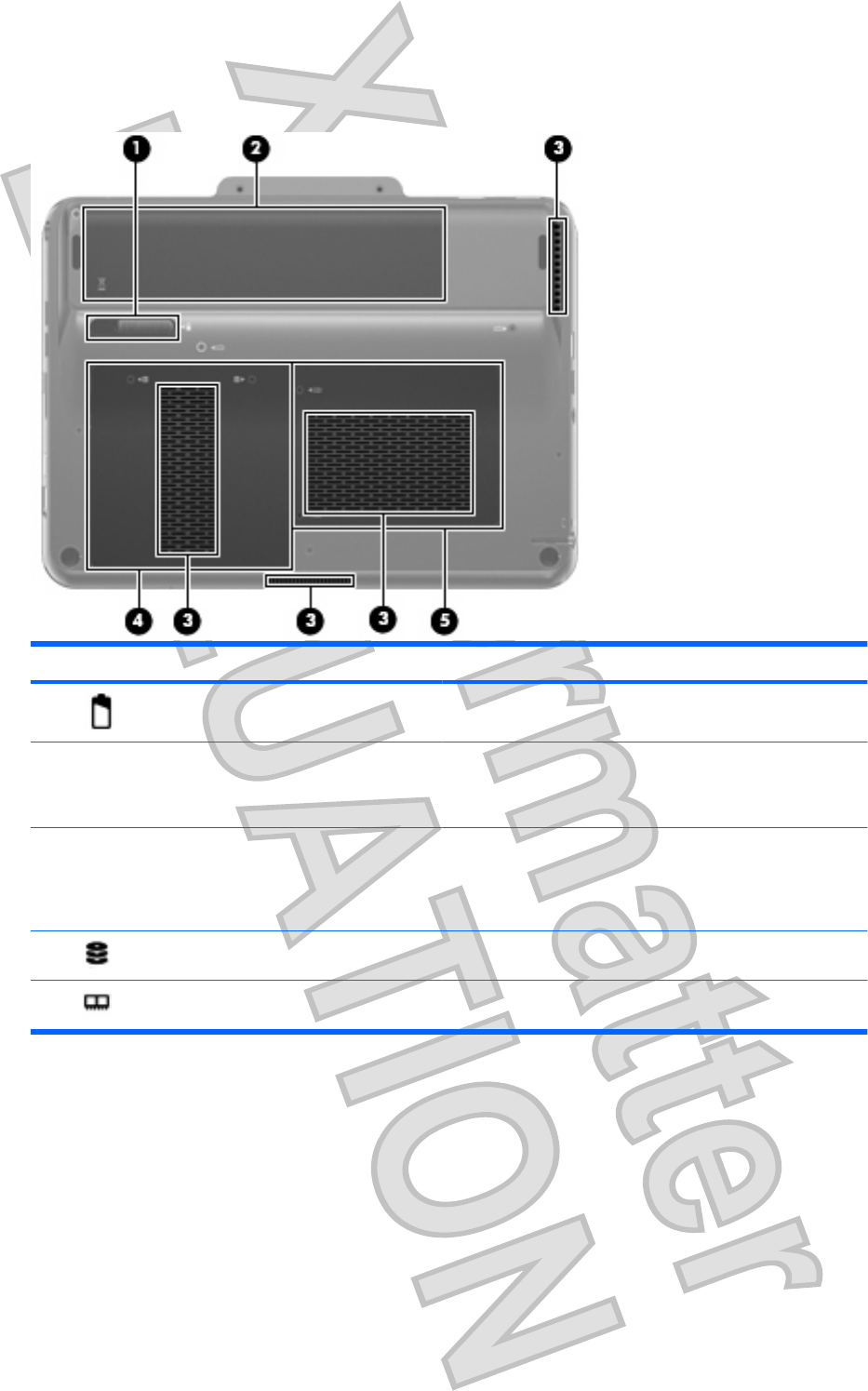
Bottom components
Component Description
(1) Battery release latch Releases the battery from the battery bay.
(2) Battery bay Holds the battery.
NOTE: The battery is preinstalled in the battery bay at the
factory.
(3) Vents (4) Enable airflow to cool internal components.
NOTE: The computer fan starts up automatically to cool
internal components and prevent overheating. It is normal for
the internal fan to cycle on and off during routine operation.
(4) Hard drive bay Holds the hard drive.
(5) Memory module compartment Contains the memory module slots.
14 Chapter 4 Features
Antenna House XSL Formatter (Evaluation) http://www.antennahouse.com/

5Networking
The computer supports 2 types of Internet access:
łWireless—For mobile Internet access, you can use a wireless connection. To learn about adding
the computer to an existing network or setting up a wireless network, refer to Creating a wireless
connection on page 16.
łWired—You can access the Internet by connecting to a broadband network using the RJ-45
(network) jack. To learn about connecting using the RJ-45 jack, refer to Connecting to a wired
network on page 25.
Choosing an ISP
You must set up Internet service before you can connect to the Internet. The computer includes the
following software features to help you set up a new Internet account or configure the computer to use
an existing account:
łInternet Services & Offers (available in some locations)
łISP-provided icons (available in some locations)
łWindows Connect to the Internet Wizard (available in all locations)
Using Internet Services & Offers
If the Internet Service & Offers utility is supported in the country or region in which you purchased the
computer, you can access the utility by using the following method:
Select Start > All Programs > Online Services > Get Online.
The Internet Services & Offers utility assists with these tasks:
łSigning up for a new Internet account
łConfiguring the computer to use an existing account
Using ISP-provided icons
If ISP-provided icons are supported in the country or region in which you purchased the computer, the
icons may be displayed either individually on the Windows desktop or grouped in a desktop folder named
Online Services.
To set up a new Internet account or configure the computer to use an existing account, double-
click an icon, and then follow the instructions on the screen.
Choosing an ISP 15
Antenna House XSL Formatter (Evaluation) http://www.antennahouse.com/
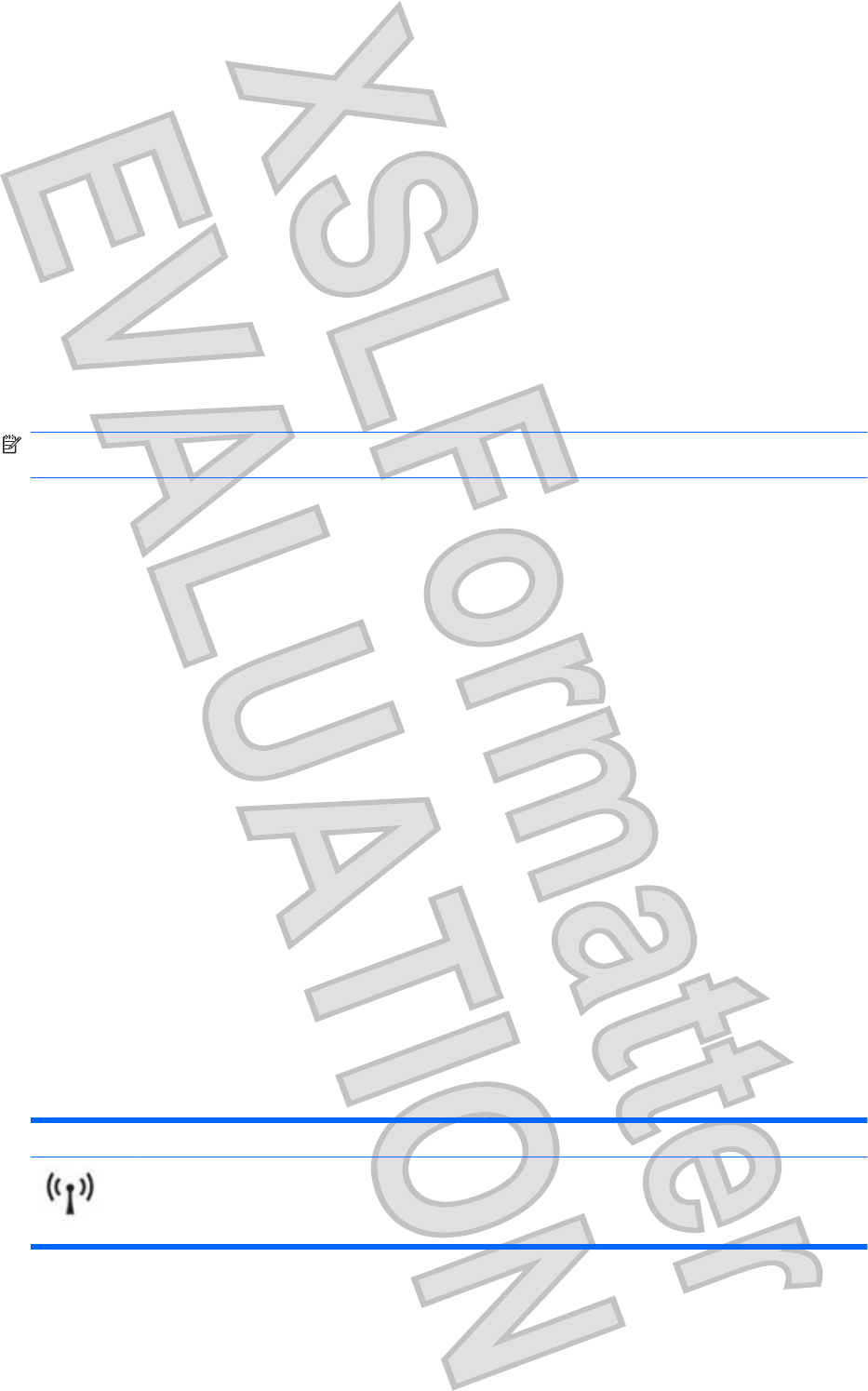
Using the Windows Connect to the Internet Wizard
You can use the Windows Connect to the Internet Wizard to connect to the Internet in any of these
situations:
łIf you already have an account with an ISP.
łIf you have a disc from an ISP.
łIf you do not have an Internet account and would like to select an ISP from the list provided within
the wizard. (The list of ISP providers is not available in all regions.)
łIf you have selected an unlisted ISP and the ISP has provided you with such information as a
specific IP address and POP3 and SMTP settings.
To access the Windows Connect To The Internet Wizard and instructions for using the wizard, click
Start, and then click Help and Support.
NOTE: If you are prompted within the wizard to choose between enabling or disabling Windows
Firewall, choose to enable the firewall.
Creating a wireless connection
Wireless technology transfers data across radio waves instead of wires. Your computer may be
equipped with one or more of the following wireless devices:
łWireless local area network (WLAN) device—Connects the computer to wireless local area
networks (commonly referred to as Wi-Fi networks, wireless LANs, or WLANs) in corporate offices,
your home, and public places such as airports, restaurants, coffee shops, hotels, and universities.
In a WLAN, each mobile wireless device communicates with a wireless router or a wireless access
point.
łHP Mobile Broadband Module—A wireless wide area network (WWAN) device that provides
access to information wherever mobile network operator service is available. In a WWAN, each
mobile device communicates to a mobile network operator’s base station. Mobile network operators
install networks of base stations (similar to cell phone towers) throughout large geographic areas,
effectively providing coverage across entire states, regions, or even countries.
łBluetooth® device—Creates a personal area network (PAN) to connect to other Bluetooth-enabled
devices such as computers, phones, printers, headsets, speakers, and cameras. In a PAN, each
device communicates directly with other devices, and devices must be relatively close together—
typically within 10 meters (approximately 33 feet) of each other.
For more information on wireless technology, refer to the information and Web site links provided in
Help and Support.
Identifying wireless icons and controls
Identifying wireless and network status icons
Icon Name Description
Wireless (connected) Identifies the location of the wireless light and the wireless
key on the computer. Also identifies the Wireless Assistant
software on the computer and indicates that one or more of
the wireless devices are on.
16 Chapter 5 Networking
Antenna House XSL Formatter (Evaluation) http://www.antennahouse.com/
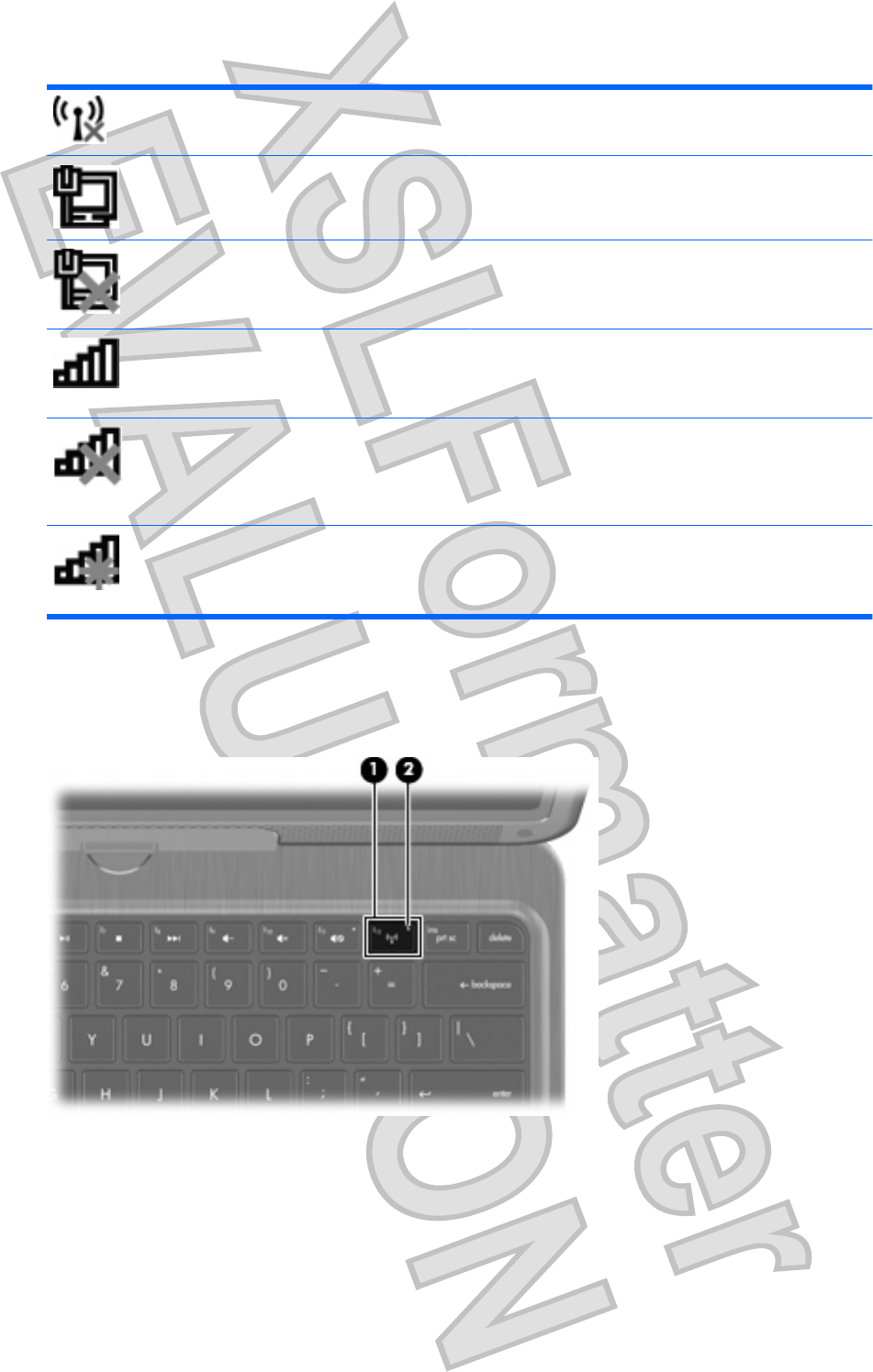
Wireless (disconnected) Identifies the Wireless Assistant software on the computer
and indicates that all of the wireless devices are off.
Wired network (connected) Indicates that one or more network drivers on your computer
are installed and one or more network devices are connected
to the network.
Wired network (disabled/disconnected) Indicates that one or more of your network drivers are
installed, all network devices or all wireless devices are
disabled in Windows Control Panel, and no network devices
are connected to a wired network.
Network (connected) Indicates that one or more of your network drivers are
installed, one or more network devices are connected to a
wireless network, and one or more network devices may be
connected to a wired network.
Network (disabled/disconnected) Indicates that one or more of your network drivers are
installed, no wireless connections are available or all wireless
network devices are disabled by the wireless button or
Wireless Assistant, and no network devices are connected
to a wired network.
Network (disconnected) Indicates that one or more of your network drivers are
installed and wireless connections are available, but no
network devices are connected to a wired or wireless
network.
Using the wireless key
The computer has a wireless key (1), one or more wireless devices, and one wireless light (2). All of the
wireless devices on your computer are enabled at the factory.
If the wireless light is amber, one or more wireless devices are off. If the wireless light is off, an integrated
wireless device, such as a wireless local area network (WLAN) device and/or a Bluetooth® device, is
on.
The wireless light indicates the overall power state of your wireless devices, not the status of individual
devices. Press the wireless key to turn the wireless devices off or on.
Creating a wireless connection 17
Antenna House XSL Formatter (Evaluation) http://www.antennahouse.com/
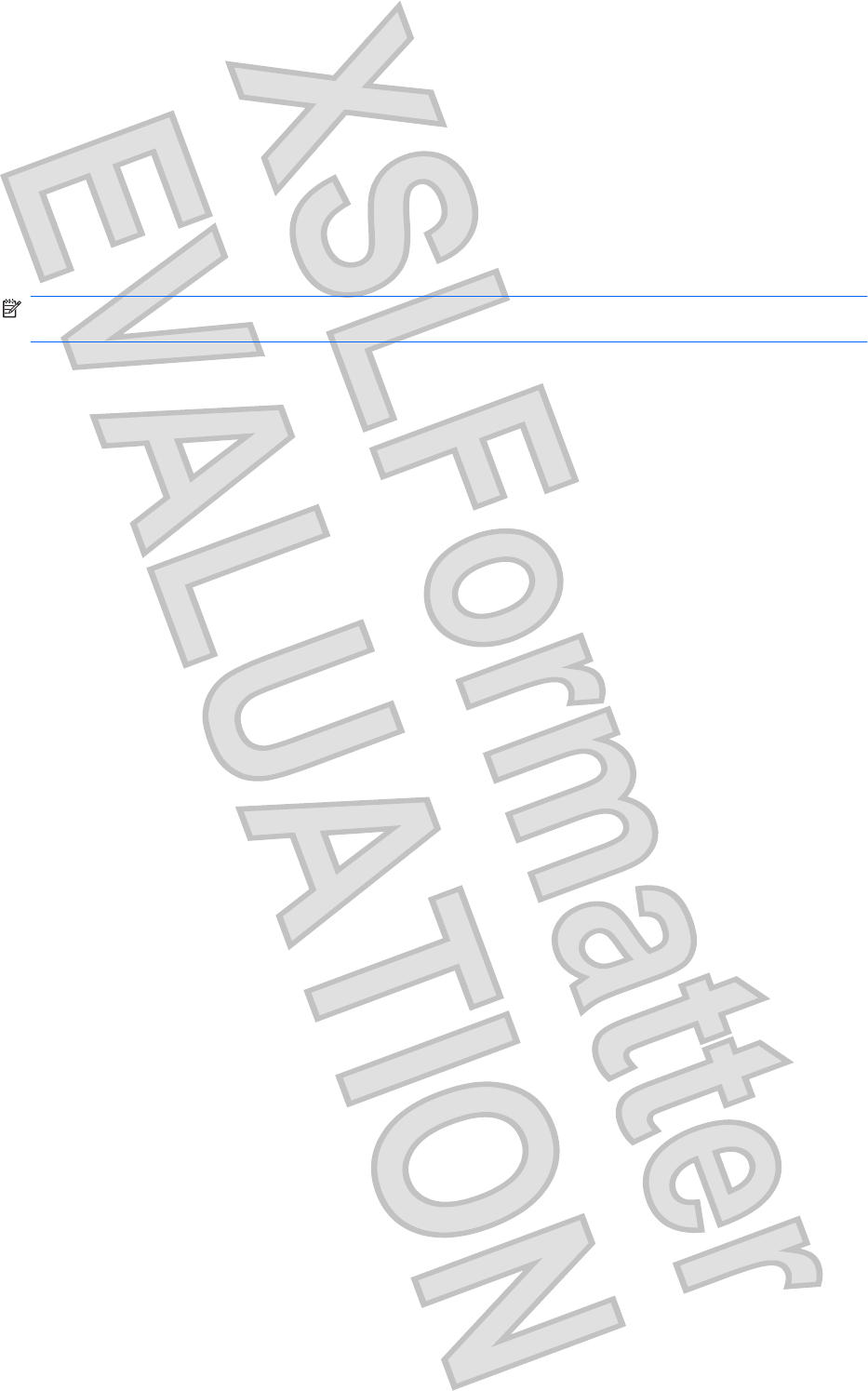
Because the wireless devices are enabled at the factory, you can use the wireless key to turn on or turn
off the wireless devices simultaneously. Individual wireless devices can be controlled through Wireless
Assistant software.
Using Wireless Assistant software
A wireless device can be turned on or off using the Wireless Assistant software. If a wireless device is
disabled in Setup Utility, it must be reenabled in Setup Utility before it can be turned on or off using
Wireless Assistant.
NOTE: Enabling or turning on a wireless device does not automatically connect the computer to a
network or a Bluetooth-enabled device.
To view the state of the wireless devices, click the Show hidden icons icon, the arrow at the left of the
notification area, and position the mouse pointer over the wireless icon.
If the wireless icon is not displayed in the notification area, complete the following steps to change
Wireless Assistant properties:
1. Select Start > Control Panel > Hardware and Sound > Windows Mobility Center.
2. Click the wireless icon in the Wireless Assistant tile, which is located in the bottom row of Windows®
Mobility Center.
3. Click Properties.
4. Select the check box next to HP Wireless Assistant icon in notification area.
5. Click Apply.
6. Click Close.
For more information, refer to the Wireless Assistant software Help:
1. Open Wireless Assistant by clicking the wireless icon in Windows Mobility Center.
2. Click the Help button.
Using operating system controls
Some operating systems also offer a way to manage integrated wireless devices and the wireless
connection. For example, Windows provides the Network and Sharing Center that allows you to set up
a connection or network, connect to a network, manage wireless networks, and diagnose and repair
network problems.
To access the Network and Sharing Center, select Start > Control Panel > Network and Internet >
Network and Sharing Center.
For more information, select Start > Help and Support.
Connecting to a WLAN
With a WLAN device, you can access a wireless local area network (WLAN), which is composed of other
computers and accessories that are linked by a wireless router or a wireless access point.
18 Chapter 5 Networking
Antenna House XSL Formatter (Evaluation) http://www.antennahouse.com/
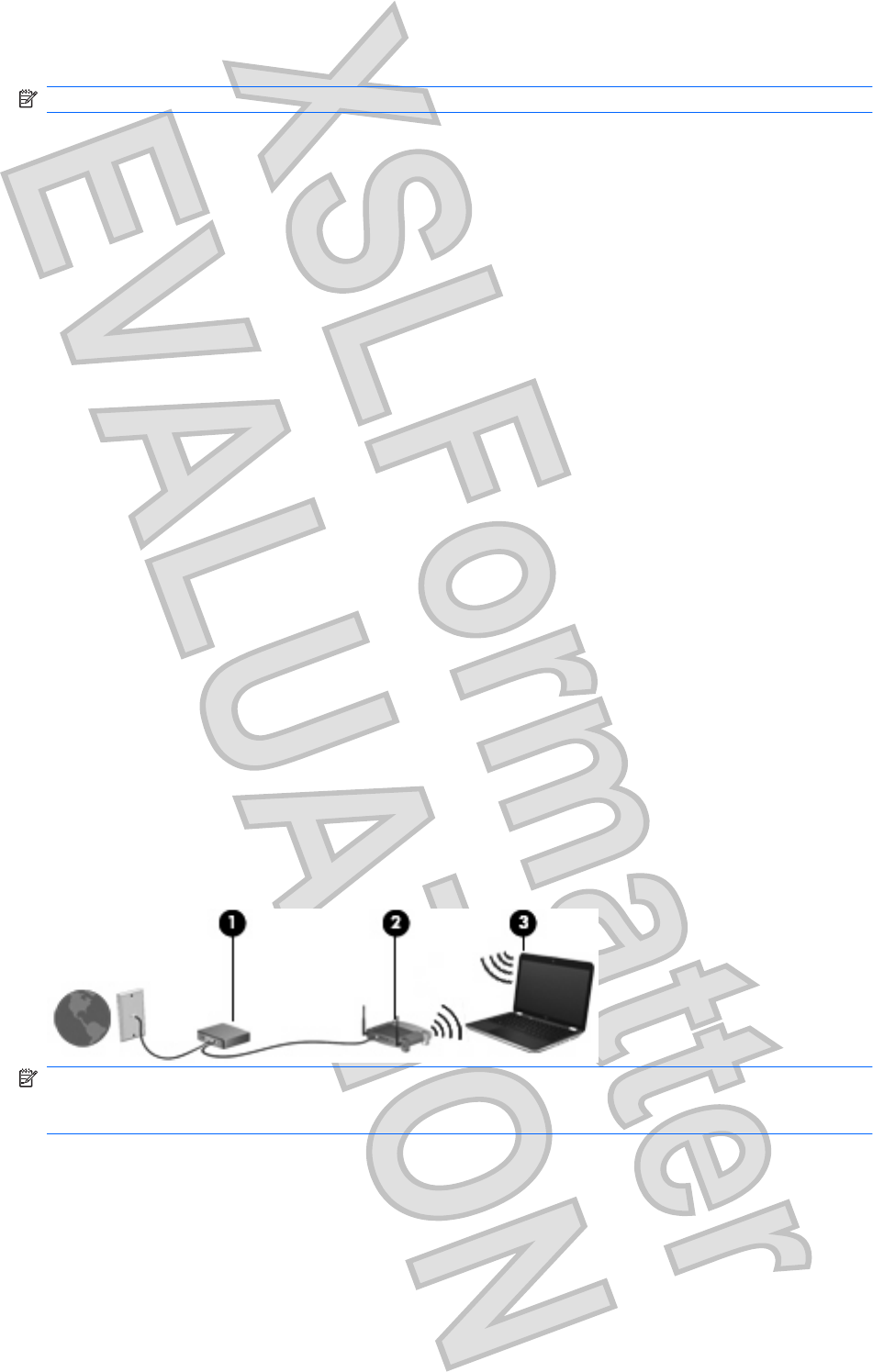
NOTE: The terms wireless router and wireless access point are often used interchangeably.
łA large-scale WLAN, such as a corporate or public WLAN, typically uses wireless access points
that can accommodate a large number of computers and accessories and can separate critical
network functions.
łA home or small office WLAN typically uses a wireless router, which allows several wireless and
wired computers to share an Internet connection, a printer, and files without requiring additional
pieces of hardware or software.
To use the WLAN device in your computer, you must connect to a WLAN infrastructure (provided through
a service provider or a public or corporate network).
Connecting to an existing wireless network
To connect the computer to an existing wireless network, follow these steps:
1. Be sure that the wireless device is on (wireless light is off). If the wireless light is amber, press the
wireless key.
2. Click the network icon in the notification area, at the far right of the taskbar.
3. Select a network to connect to.
4. Click Connect.
5. If the network is a security-enabled WLAN, you are prompted to enter a network security key, which
is a security code. Type the code, and then click OK to complete the connection.
Setting up a wireless network
To set up a WLAN and connect to the Internet, you need the following equipment:
łA broadband modem (either DSL or cable) (1) and high-speed Internet service purchased from an
Internet service provider (ISP)
łA wireless router (purchased separately) (2)
łThe wireless computer (3)
The illustration below shows an example of a wireless network installation that is connected to the
Internet.
NOTE: When setting up a wireless connection, be sure that your computer and wireless router are
synchronized. To synchronize your computer and wireless router, turn your computer and wireless
router off and then back on.
As your network grows, additional wireless and wired computers can be connected to the network to
access the Internet.
For additional help in setting up your WLAN, refer to the information provided by your router
manufacturer or your ISP.
Creating a wireless connection 19
Antenna House XSL Formatter (Evaluation) http://www.antennahouse.com/
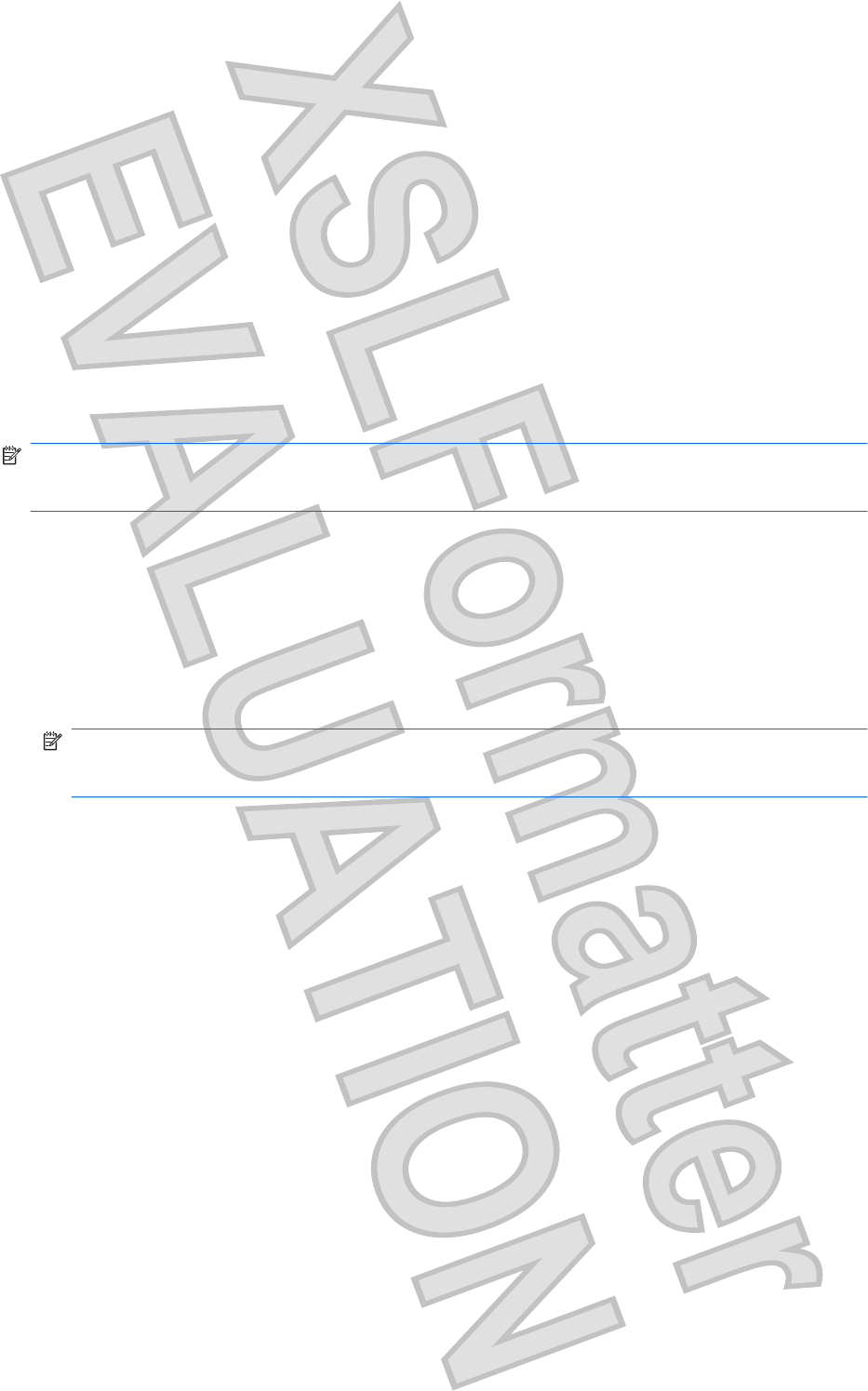
Step 1: Purchase high-speed Internet service
If you already have high-speed Internet service (DSL, cable, or satellite), begin with . If you do not have
high-speed Internet service, follow these steps:
1. Contact a local ISP to purchase high-speed Internet service and a DSL or cable modem. The ISP
will help set up the modem, install a network cable to connect your wireless computer to the modem,
and test the Internet service.
2. Your ISP will give you a User ID and password to access the Internet. Record this information and
store it in a safe place.
Step 2: Purchase and install a wireless router
Read this section carefully before you install the wireless router using the router manufacturer's
instructions and your wireless computer. If you need technical assistance during the router installation,
contact the router manufacturer.
NOTE: It is recommended that you temporarily connect your new wireless computer to the router by
using the network cable provided with the router. This will ensure that the computer can access the
Internet.
1. Be sure that the wireless light on the computer is off. If the wireless light is on, turn it off by pressing
the wireless key.
2. During the router installation, the router manufacturer's software allows you to change the network
name (SSID) and enable security to protect the privacy of your wireless network. Many routers are
shipped with a default network name and with security disabled. If you change the default network
name or enable security during the router setup, record the information and store it in a safe place.
You will need this information when you configure the computer and any other existing computers
to access the router.
NOTE: If you do not enable security, an unauthorized wireless user can access the data on the
computer and use your Internet connection without your knowledge. For more information on
securing your wireless network, refer to the Wireless guide in Help and Support.
The Windows operating system also provides tools to help you set up your wireless network for the first
time. To use the Windows tools to set up your network:
Click Start > Network > Network and Sharing Center > Set up a connection or network > Set
up a wireless router or access point. Then follow the on-screen instructions.
Step 3: Configure the computer to connect to the wireless network
1. Be sure that the wireless device is on (wireless light is off). If the wireless light is amber, press the
wireless key.
2. Click the network icon in the notification area, at the far right of the taskbar.
3. Select a network to connect to.
4. Click Connect.
5. If the network is a security-enabled WLAN, you are prompted to enter a network security key, which
is a security code. Type the code, and then click OK to complete the connection.
6. Test the wireless network by opening your Web browser and accessing a Web site.
20 Chapter 5 Networking
Antenna House XSL Formatter (Evaluation) http://www.antennahouse.com/

Protecting your WLAN
Because the WLAN standard was designed with only limited security capabilities—basically to foil casual
eavesdropping rather than more powerful forms of attack—it is essential to understand that WLANs are
vulnerable to well-known and well-documented security weaknesses.
WLANs in public areas, or “hotspots,” like coffee shops and airports may not provide any security. New
technologies are being developed by wireless manufacturers and hotspot service providers that make
the public environment more secure and anonymous. If you are concerned about the security of your
computer in a hotspot, limit your network activities to noncritical e-mail and basic Internet surfing.
When you set up a WLAN or access an existing WLAN, always enable security features to protect your
network from unauthorized access. The common security levels are Wi-Fi Protected Access (WPA)-
Personal and Wired Equivalent Privacy (WEP). Because wireless radio signals travel outside the
network, other WLAN devices can pick up unprotected signals and either connect to your network
(uninvited) or capture information being sent across it. However, you can take precautions to protect
your WLAN:
łUse a wireless transmitter with built-in security
Many wireless base stations, gateways, or routers provide built-in security features such as
wireless security protocols and firewalls. With the correct wireless transmitter, you can protect your
network from the most common wireless security risks.
łWork behind a firewall
A firewall is a barrier that checks both data and requests for data that are sent to your network,
and discards any suspicious items. Firewalls are available in many varieties, both software and
hardware. Some networks use a combination of both types.
łUse wireless encryption
A variety of sophisticated encryption protocols is available for your WLAN. Find the solution that
works best for your network security:
ŃWired Equivalent Privacy (WEP) is a wireless security protocol that encodes or encrypts all
network data before it is transmitted using a WEP key. Usually, you can allow the network to
assign the WEP key. Alternatively, you can set up your own key, generate a different key, or
choose other advanced options. Without the correct key, others will not be able to use the
WLAN.
ŃWPA (Wi-Fi Protected Access), like WEP, uses security settings to encrypt and decrypt data
that is transmitted over the network. However, instead of using one static security key for
encryptions as WEP does, WPA uses “temporal key integrity protocol” (TKIP) to dynamically
generate a new key for every packet. It also generates different sets of keys for each computer
on the network.
Roaming to another network
When you move your computer within range of another WLAN, Windows attempts to connect to that
network. If the attempt is successful, your computer is automatically connected to the new network. If
Windows does not recognize the new network, follow the same procedure you used initially to connect
to your WLAN.
Using HP Mobile Broadband
HP Mobile Broadband enables your computer to use wireless wide area networks (WWANs) to access
the Internet from more places and over larger areas than it can by using WLANs. Using HP Mobile
Broadband requires a network service provider (called a mobile network operator), which in most cases
Creating a wireless connection 21
Antenna House XSL Formatter (Evaluation) http://www.antennahouse.com/
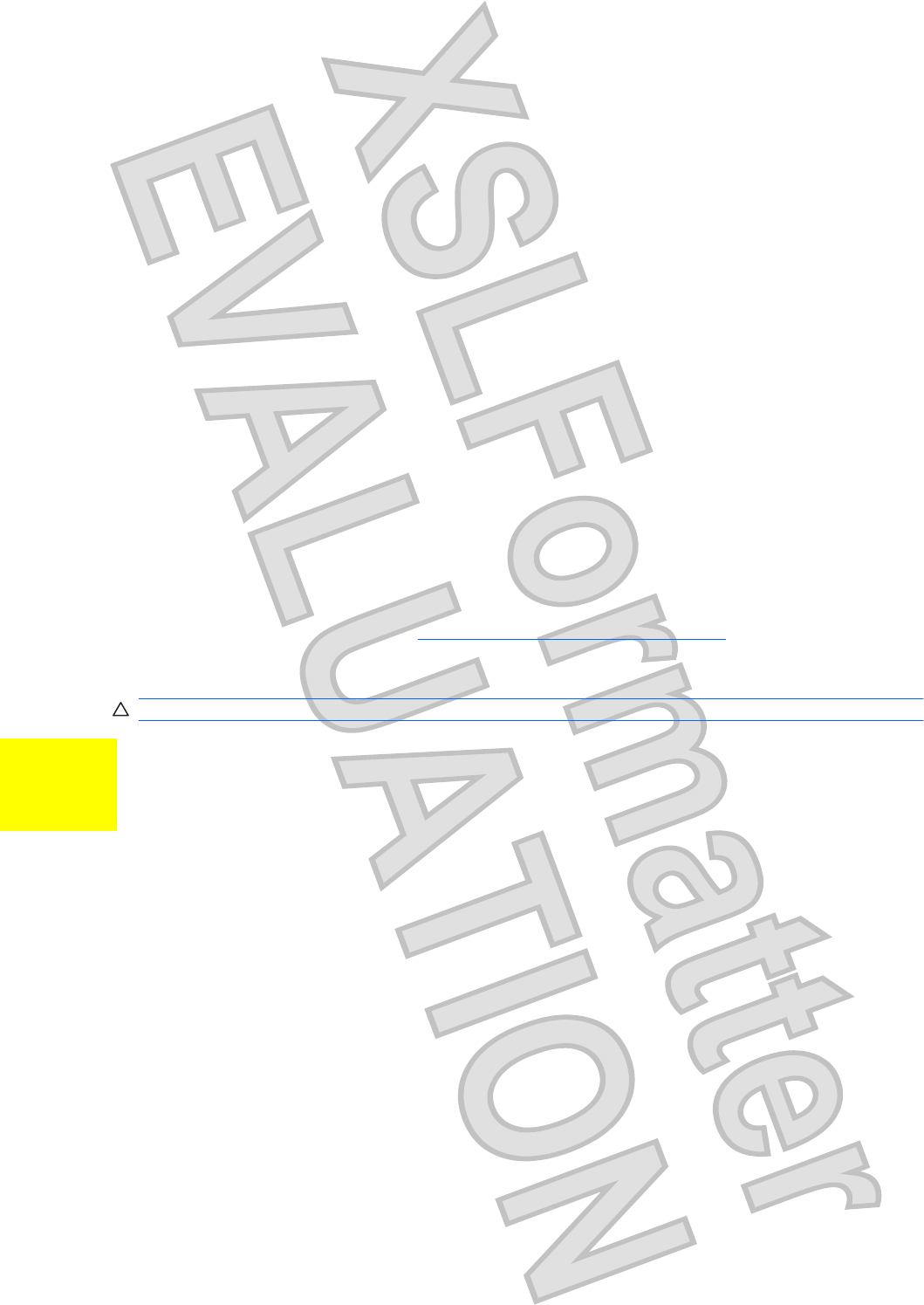
is a mobile phone network operator. Coverage for HP Mobile Broadband is similar to mobile phone voice
coverage.
When used with mobile network operator service, HP Mobile Broadband gives you the freedom to stay
connected to the Internet, send e-mail, or connect to your corporate network whether you are on the
road or outside the range of Wi-Fi hotspots.
HP Mobile Broadband supports the following technologies:
łHSPA (High Speed Packet Access), which provides access to networks based on the Global
System for Mobile Communications (GSM) telecommunications standard.
łEV-DO (Evolution Data Optimized), which provides access to networks based on the code division
multiple access (CDMA) telecommunications standard.
You may need the HP Mobile Broadband Module serial number to activate mobile broadband service.
The serial number is printed on a label inside the battery bay of your computer.
Some mobile network operators require the use of a subscriber identity module (SIM). A SIM contains
basic information about you, such as a personal identification number (PIN), as well as network
information. Some computers include a SIM that is preinstalled in the battery bay. If the SIM is not
preinstalled, it may be provided in the HP Mobile Broadband information provided with your computer,
or the mobile network operator may provide it separately from the computer.
For information on inserting and removing the SIM, refer to the “Inserting a SIM” and “Removing a SIM”
sections in this chapter.
For information on HP Mobile Broadband and how to activate service with a preferred mobile network
operator, refer to the HP Mobile Broadband information included with your computer. For additional
information, see the HP Web site at http://www.hp.com/go/mobilebroadband (US only).
Inserting a SIM
CAUTION: To prevent damage to the connectors, use minimal force when inserting a SIM.
To insert a SIM:
1. Shut down the computer. If you are not sure whether the computer is off or in Hibernation, turn the
computer on by sliding the power switch. Then shut down the computer through the operating
system.
2. Close the display.
3. Disconnect all external devices connected to the computer.
4. Unplug the power cord from the AC outlet.
5. Turn the computer upside down on a flat surface, with the battery bay toward you.
6. Remove the battery.
22 Chapter 5 Networking
Antenna House XSL Formatter (Evaluation) http://www.antennahouse.com/
Verify that the SIM
inserting and
removal
procedures are
correct for Luke
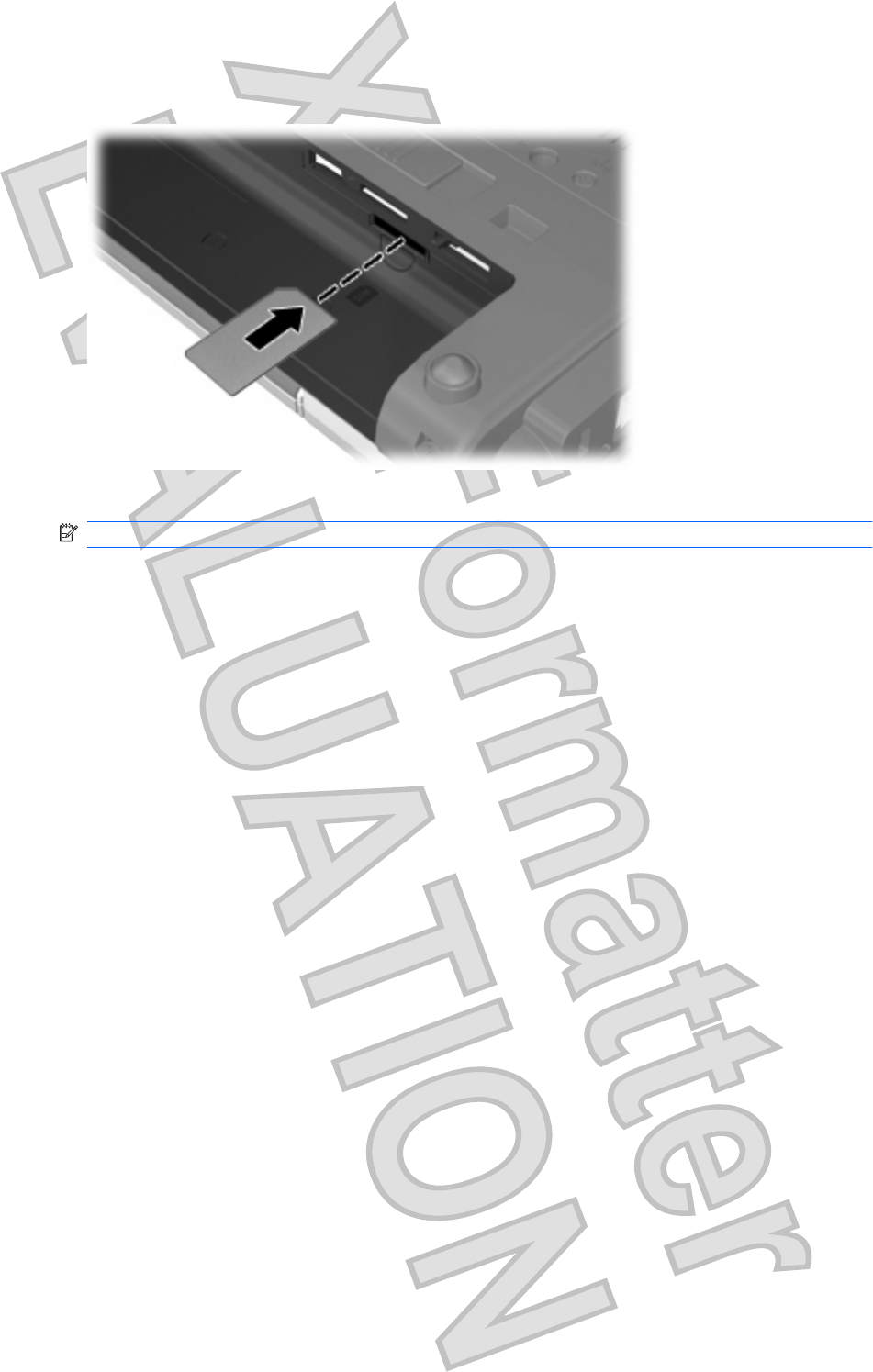
7. Insert the SIM into the SIM slot, and gently push the SIM into the slot until it is firmly seated.
8. Replace the battery.
NOTE: HP Mobile Broadband will be disabled if the battery is not replaced.
9. Reconnect external power.
10. Reconnect external devices.
11. Turn on the computer.
Removing a SIM
To remove a SIM:
1. Shut down the computer. If you are not sure whether the computer is off or in Hibernation, turn the
computer on by sliding the power switch. Then shut down the computer through the operating
system.
2. Close the display.
3. Disconnect all external devices connected to the computer.
4. Unplug the power cord from the AC outlet.
5. Turn the computer upside down on a flat surface, with the battery bay toward you.
6. Remove the battery.
Creating a wireless connection 23
Antenna House XSL Formatter (Evaluation) http://www.antennahouse.com/
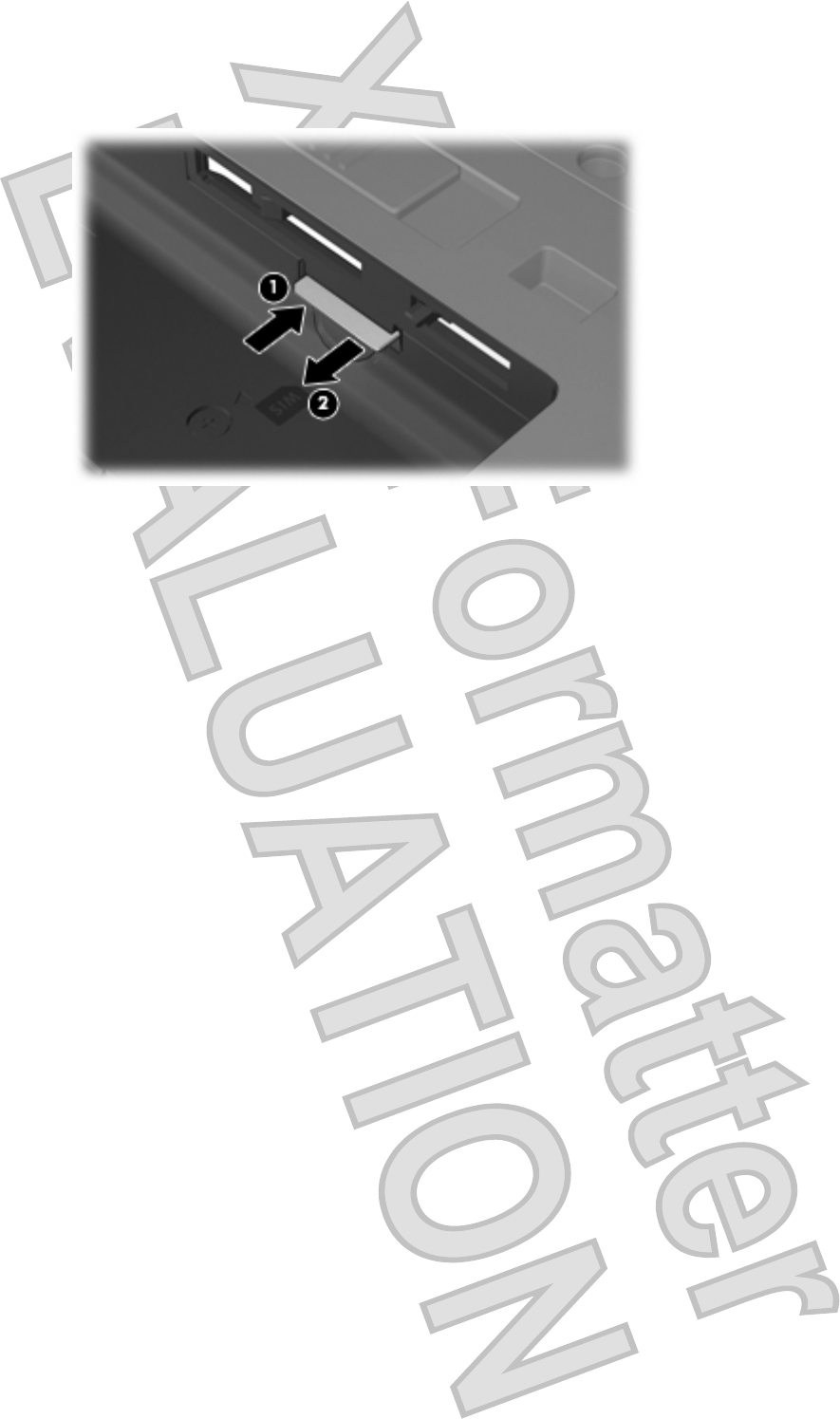
7. Press in on the SIM (1), and then remove it from the slot (2).
8. Replace the battery.
9. Reconnect external power.
10. Reconnect external devices.
11. Turn on the computer.
Using Bluetooth wireless devices
A Bluetooth device provides short-range wireless communications that replace the physical cable
connections that traditionally link electronic devices such as the following:
łComputers (desktop, notebook, PDA)
łPhones (cellular, cordless, smart phone)
łImaging devices (printer, camera)
łAudio devices (headset, speakers)
Bluetooth devices provide peer-to-peer capability that allows you to set up a personal area network
(PAN) of Bluetooth devices. For information on configuring and using Bluetooth devices, refer to the
Bluetooth software Help.
Bluetooth and Internet Connection Sharing (ICS)
HP does not recommend setting up one computer with Bluetooth as a host and using it as a gateway
through which other computers may connect to the Internet. When two or more computers are connected
using Bluetooth, and Internet Connection Sharing (ICS) is enabled on one of the computers, the other
computers may not be able to connect to the Internet using the Bluetooth network.
The strength of Bluetooth is in synchronizing information transfers between your computer and wireless
devices including cellular phones, printers, cameras, and PDAs. The inability to consistently connect
two or more computers to share the Internet through Bluetooth is a limitation of Bluetooth and the
Windows operating system.
24 Chapter 5 Networking
Antenna House XSL Formatter (Evaluation) http://www.antennahouse.com/
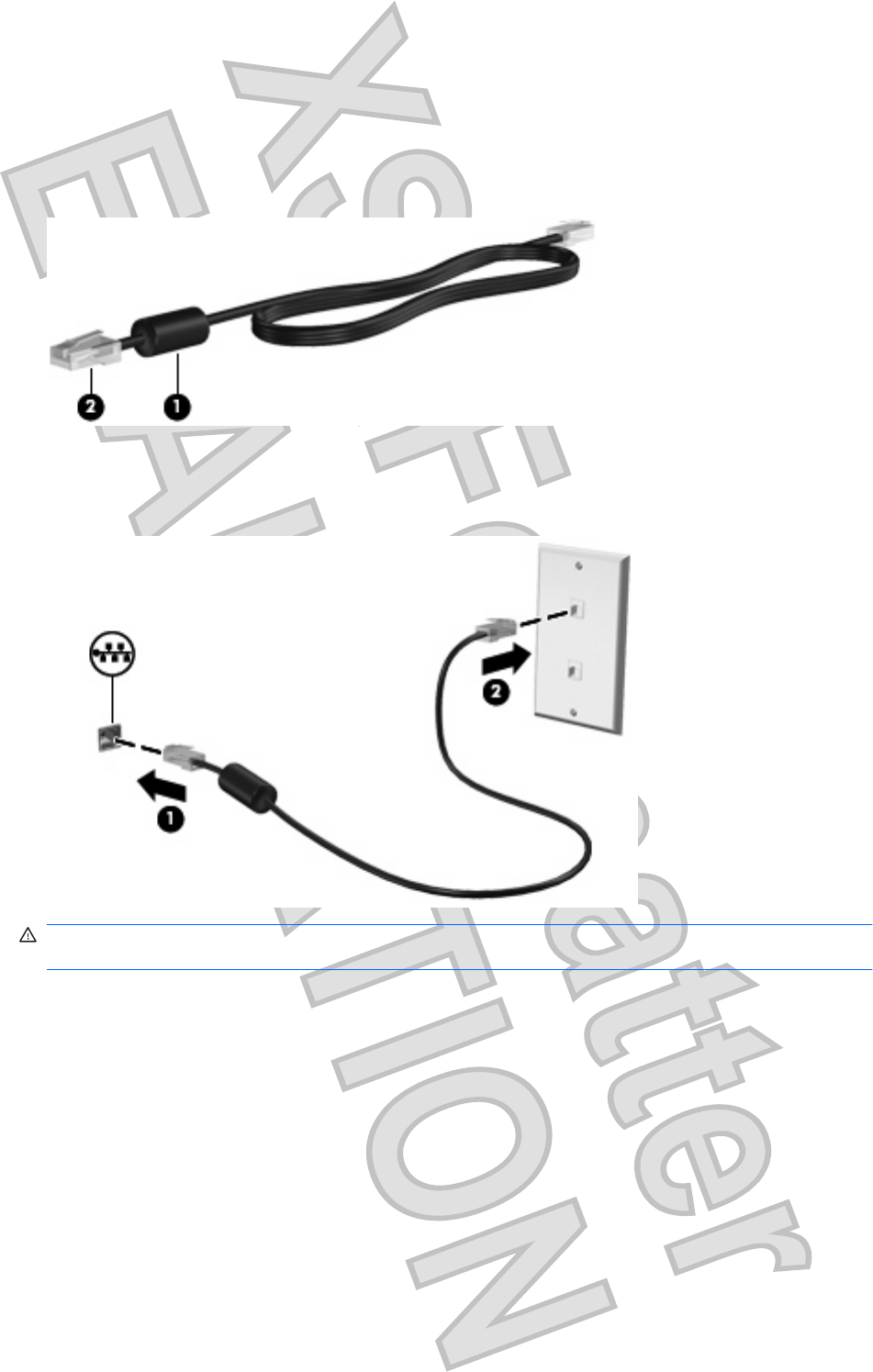
Connecting to a wired network
Connecting to a local area network (LAN) requires an 8-pin, RJ-45 network cable (purchased
separately). If the network cable contains noise suppression circuitry (1), which prevents interference
from TV and radio reception, orient the circuitry end of the cable (2) toward the computer.
To connect to a LAN:
1. Plug the network cable into the network jack (1) on the computer.
2. Plug the other end of the network cable into a network wall jack (2).
WARNING! To reduce the risk of electric shock, fire, or damage to the equipment, do not plug a modem
cable or telephone cable into an RJ-45 (network) jack.
Connecting to a wired network 25
Antenna House XSL Formatter (Evaluation) http://www.antennahouse.com/

6 Pointing devices and keyboard
Using pointing devices
NOTE: In addition to the TouchPad, you can also connect an external USB mouse to one of the USB
ports on the computer.
Setting pointing device preferences
Use Mouse Properties in Windows® to customize settings for pointing devices, such as button
configuration, click speed, and pointer options.
To access Mouse Properties, select Start > Devices and Printers. Then, right-click the device
representing your computer, and select Mouse settings.
Using the TouchPad
To move the pointer, touch and slide one finger across the TouchPad surface in the direction you want
the pointer to go. Use the left and right TouchPad buttons like the corresponding buttons on an external
mouse.
NOTE: For information on identifying the TouchPad components, refer to TouchPad on page 8.
Using TouchPad gestures
The TouchPad supports a variety of TouchPad gestures. To activate the TouchPad gestures, place two
fingers on the TouchPad at the same time as described in the following sections.
The TouchPad gestures described in this section are enabled at the factory. To disable or reenable
these gestures:
1. Double-click on the Synaptics icon in the notification area, at the far right of the taskbar, and then
click the Device Settings tab.
2. Select the device, and then click Settings.
3. Select the checkbox to disable or reenable the TouchPad gesture.
4. Click Apply, and then click OK.
NOTE: Your computer also supports additional TouchPad features that are disabled at the factory. To
view and enable these features, click the Synaptics icon in the notification area, at the far right of the
taskbar, and then click the Device Settings tab. Select the device, and then click Settings.
Scrolling
Scrolling is useful for moving up or down on a page or image. To scroll, place two fingers slightly apart
on the TouchPad and drag them across the TouchPad in an up, down, left, or right motion.
NOTE: Scrolling speed is controlled by finger speed.
26 Chapter 6 Pointing devices and keyboard
Antenna House XSL Formatter (Evaluation) http://www.antennahouse.com/
Review to ensure that the TouchPad gesture text and illustrations are correct for Luke
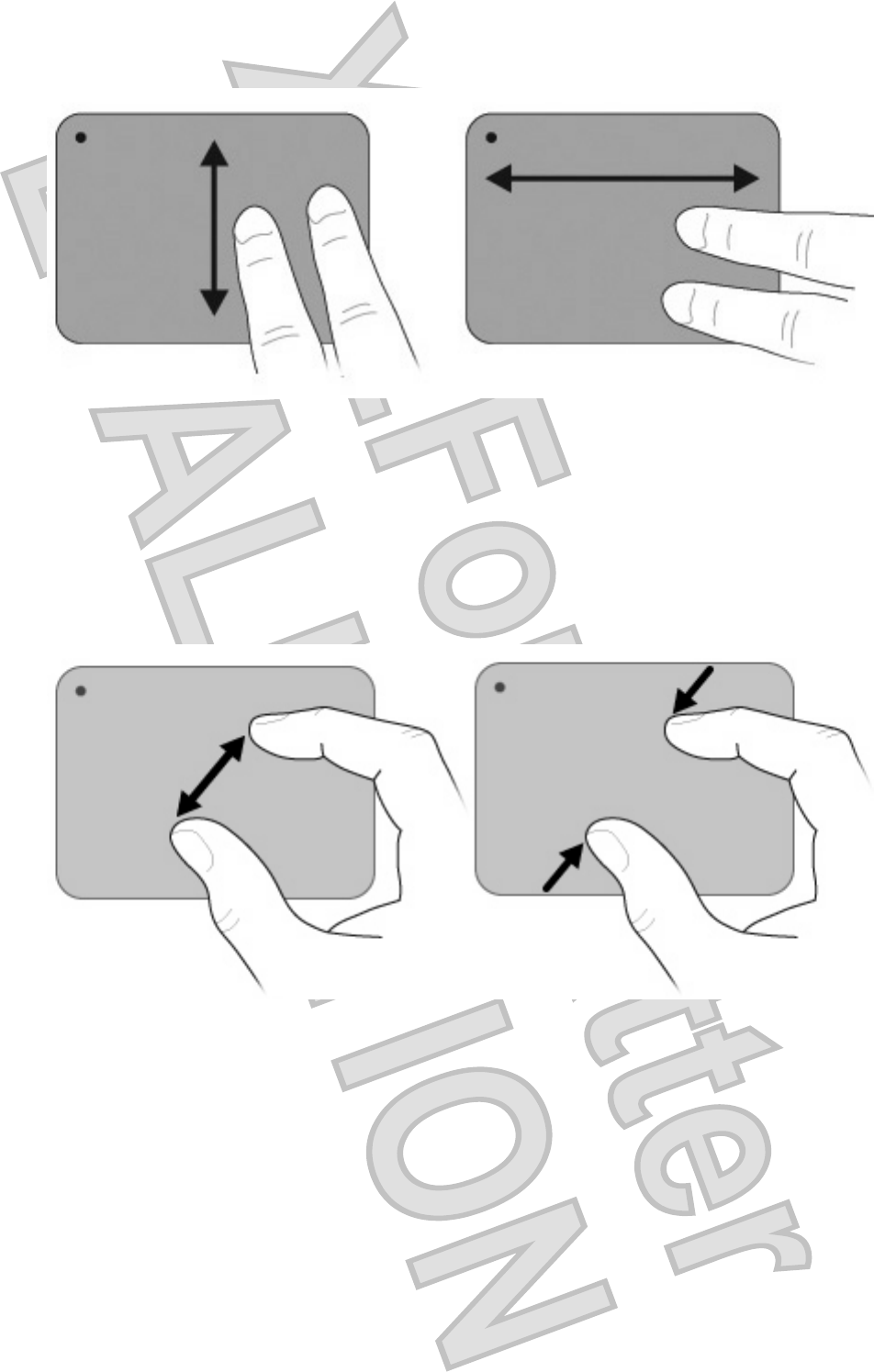
Pinching
Pinching allows you to zoom in or out on items such as PDFs, images, and photos.
To pinch:
łZoom in by holding two fingers together on the TouchPad, and then pull the fingers apart to increase
an object's size.
łZoom out by holding two fingers apart on the TouchPad, and then pull the fingers together to
decrease an object's size.
Rotating
Rotating allows you rotate items such as photos and pages. To rotate, move your thumb and forefinger
in a circular motion on the TouchPad.
Using pointing devices 27
Antenna House XSL Formatter (Evaluation) http://www.antennahouse.com/
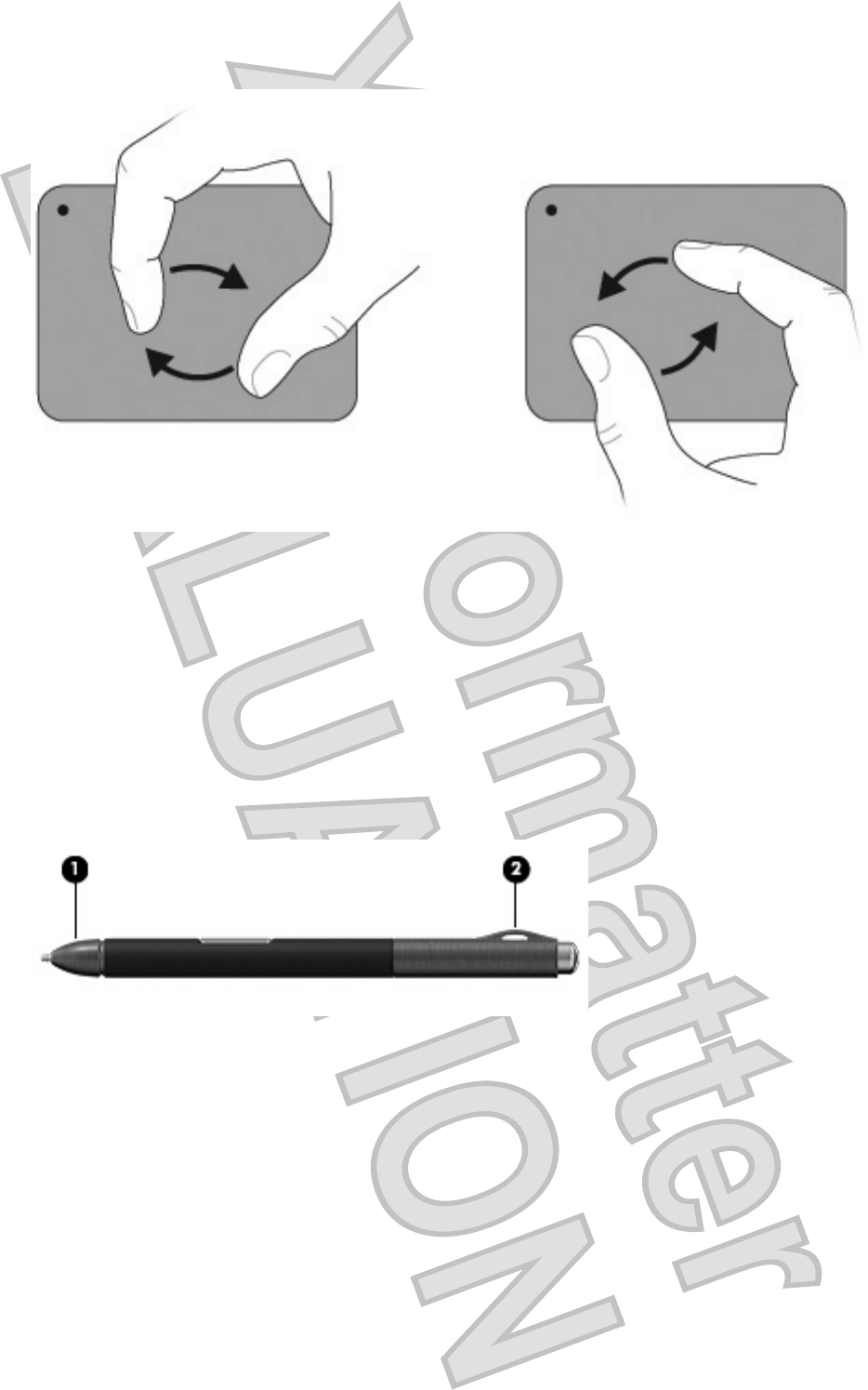
Using the digitizer pen
You can write with the pen in pen-specific programs such as Tablet PC Input Panel, in all Microsoft®
Office applications, and in most other Windows programs and utilities. The information you write on the
screen with the pen can be filed, searched, and shared among most Windows programs.
Identifying the pen components
The pen interacts with the computer whenever the tip (1) of the pen is pressed against the screen.
The pen tether eyelet (2) allows you to connect a tether from the pen to the pen tether hole on the
computer.
Holding the pen
Hold the pen as if you were writing with a standard pen or pencil.
Storing the pen
To store the pen when you are not using it, insert the pen, tip first, into the pen holder on the computer.
28 Chapter 6 Pointing devices and keyboard
Antenna House XSL Formatter (Evaluation) http://www.antennahouse.com/
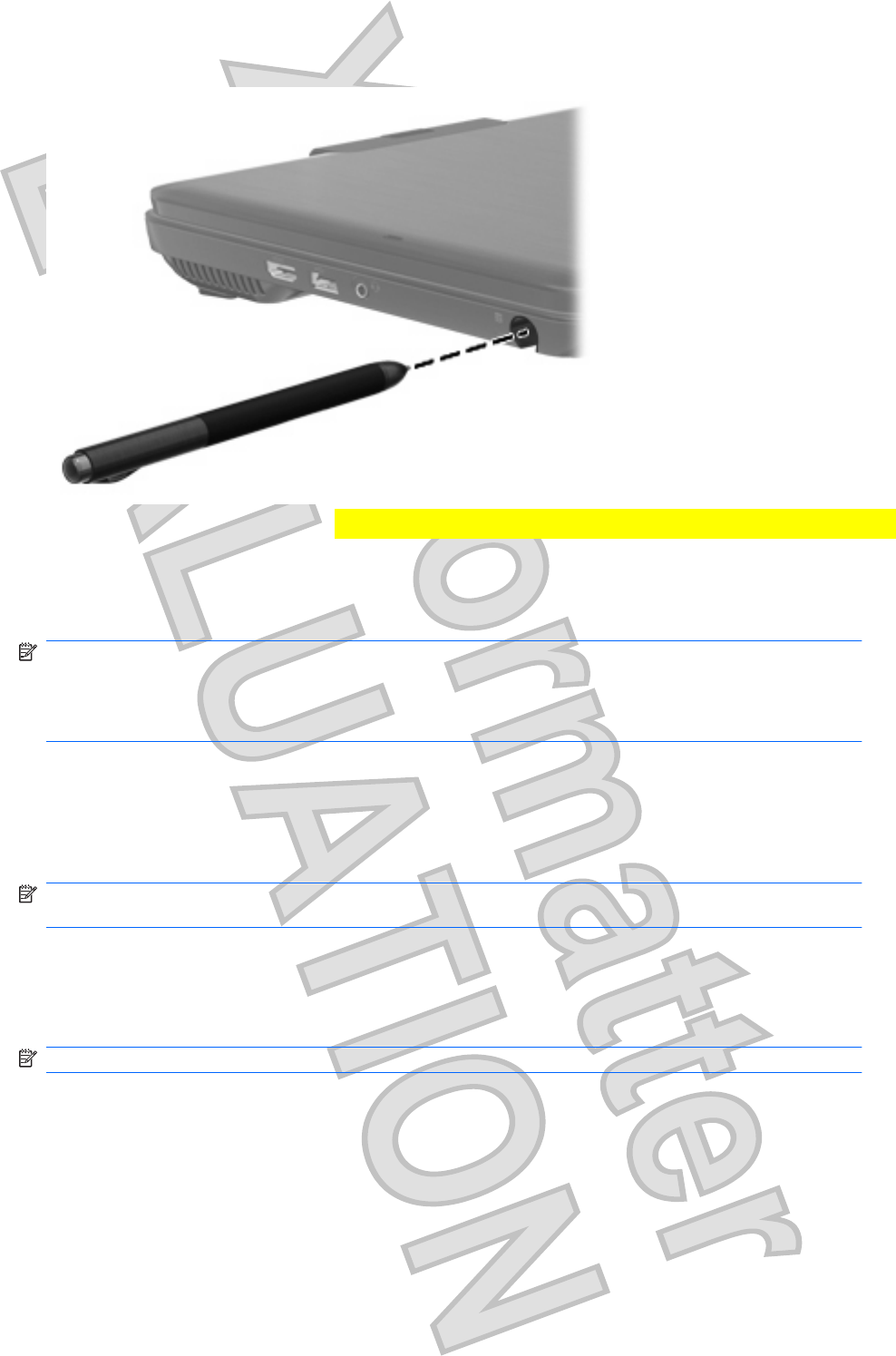
Using the touch screen
The computer allows you to use your fingers or the digitizer pen to perform certain actions on the touch
screen.
NOTE: The instructions in this section are based on the preferences set at the factory. To modify
settings for recognized clicks and flicks, select Start > Control Panel > Hardware and Sound > Pen
and Touch.
NOTE: All movements may not be supported in all programs.
Tapping (or clicking)
Tap or double-tap an item on the screen as you would click or double-click with the TouchPad or an
external mouse. Tap and hold an item to see the context menu as you would with the right TouchPad
button.
NOTE: You must tap and hold your finger until the operating system draws a circle around the area
you are touching, and then the context menu appears.
Flicking
Touch the screen in a light, quick flicking motion up, down, left, or right to navigate through screens or
quickly scroll through documents.
NOTE: For the flick movement to work, a scrollbar must be present and in the active window.
Using the touch screen 29
Antenna House XSL Formatter (Evaluation) http://www.antennahouse.com/
Review to ensure the touch screen text and illustrations are correct for Luke
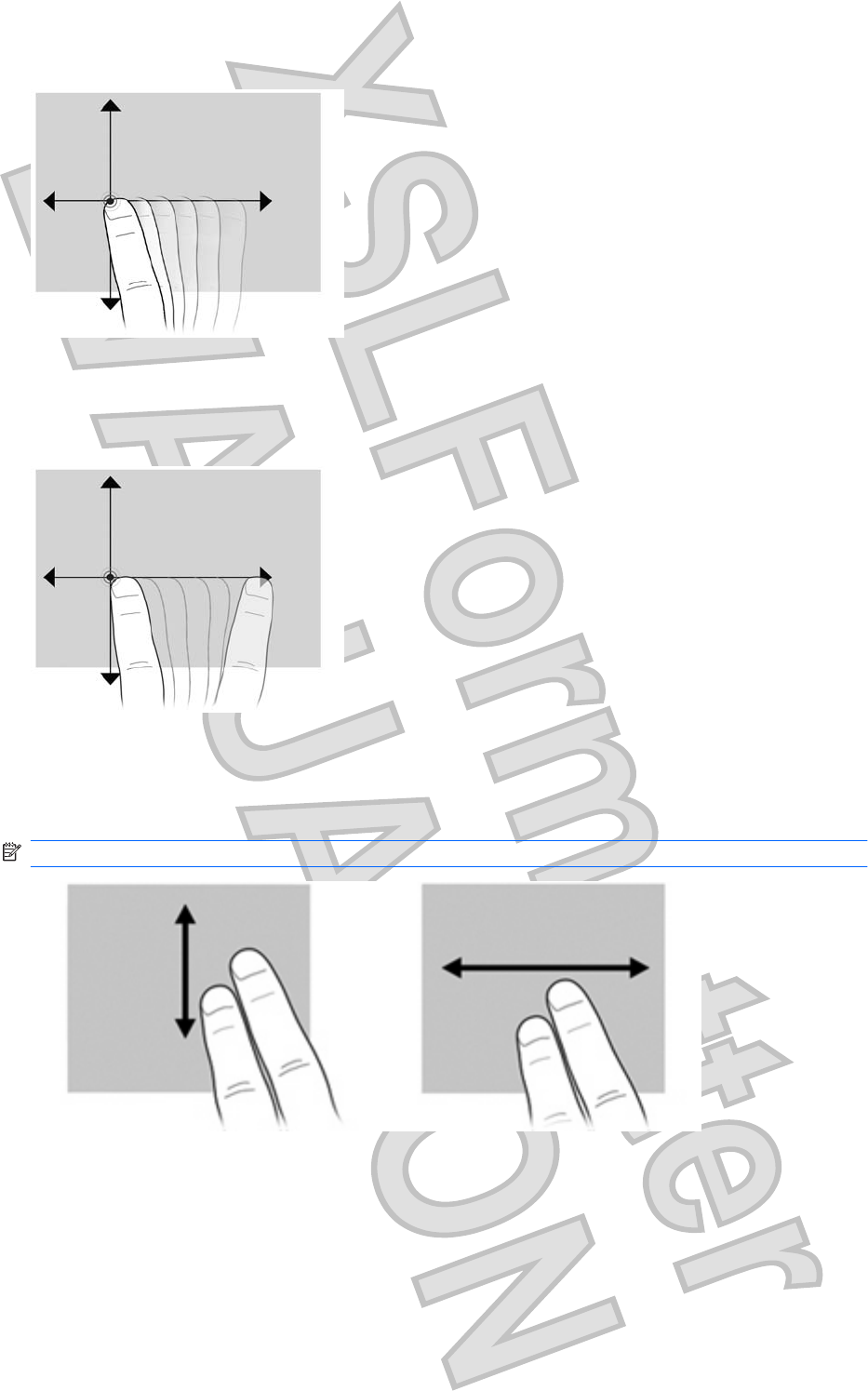
Dragging
Press your finger on an item on the screen and then move your finger to drag an item to a new location.
You can also use this motion to slowly scroll through documents.
Scrolling
Scrolling is useful for moving up or down on a page or image. To scroll, place two fingers on the screen,
and then drag them across the screen in an up, down, left, or right motion.
NOTE: Scrolling speed is controlled by finger speed.
Rotating
Rotating allows you rotate items such as photos and pages. To rotate, anchor your thumb on the screen,
and then move your forefinger in a semicircular motion around your thumb.
30 Chapter 6 Pointing devices and keyboard
Antenna House XSL Formatter (Evaluation) http://www.antennahouse.com/
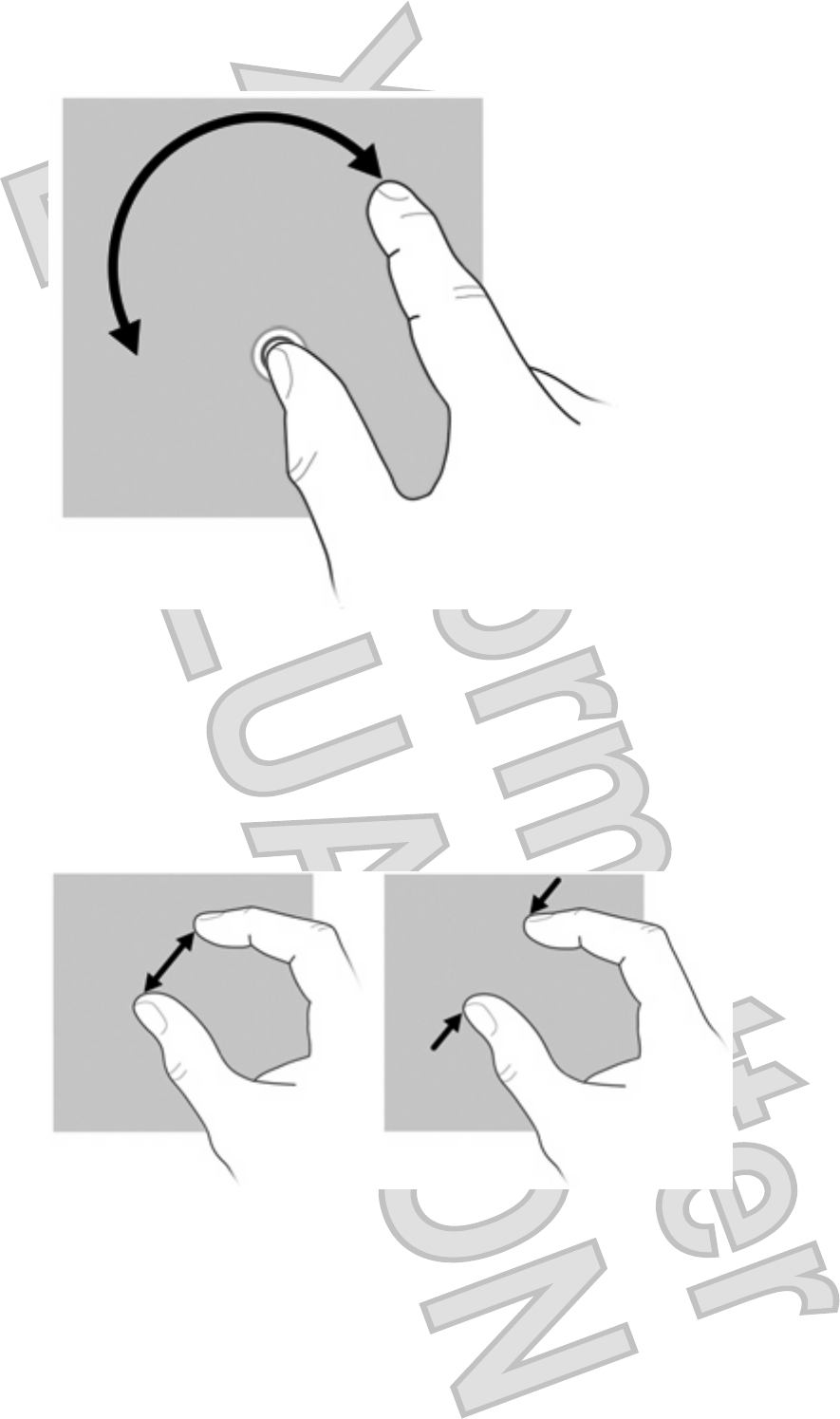
Pinching
Pinching allows you to zoom in or out on items such as PDFs, images, and photos.
To pinch:
łZoom out by holding two fingers apart on the screen, and then pull the fingers together to decrease
an object's size.
łZoom in by holding two fingers together on the screen, and then pull the fingers apart to increase
an object's size.
Using the touch screen 31
Antenna House XSL Formatter (Evaluation) http://www.antennahouse.com/
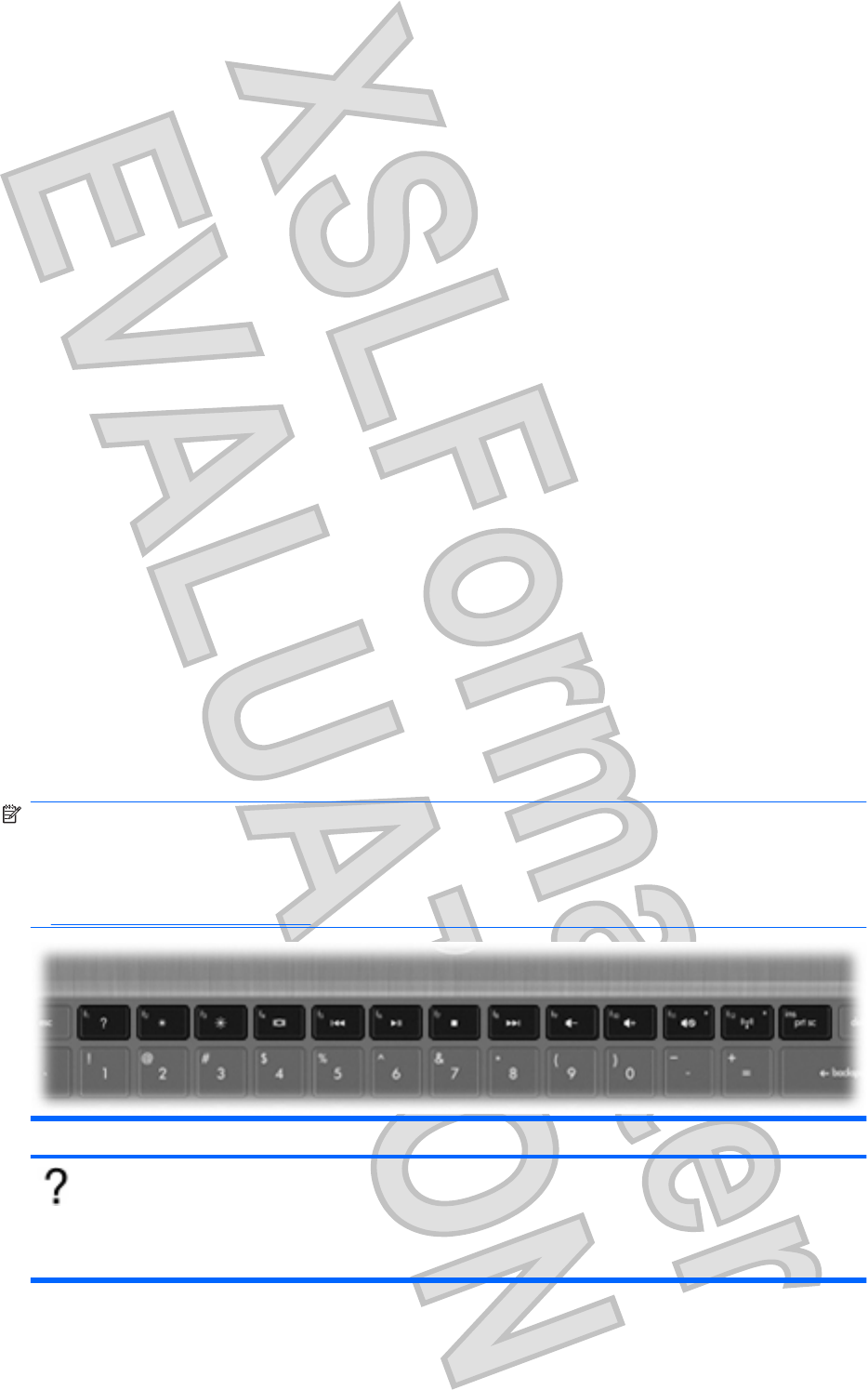
Setting touch screen preferences
To set preferences for visual feedback, select Start > Control Panel > Hardware and Sound >
Pen and Touch. These preferences are specific to the touch screen and the computer.
To set preferences for left-handed or right-handed users, select Start > Control Panel > Hardware
and Sound > Tablet PC Settings > Other tab. These preferences are specific to the touch screen
and the computer.
To set pointing device preferences such as pointer speed, click speed, and mouse trails, select
Start > Devices and Printers. Then, right-click the device representing your computer, and select
Mouse settings. These preferences apply to any pointing device in the system.
To change or test click settings:
1. Select Start > Control Panel > Hardware and Sound> Pen and Touch > Pen Options tab.
2. Under Pen Actions, select the action, and then click Settings.
3. After making any changes or testing the settings, click OK.
To change or create flick assignments:
1. Select Start > Control Panel > Hardware and Sound> Pen and Touch > Flicks tab.
2. Click Navigational flicks and editing flicks, and then click Customize.
3. Follow the on-screen instructions to change or create a flick assignment.
4. Click OK.
Using the action keys
Action keys are customized actions that are assigned to specific keys at the top of the keyboard.
To use an action key, press and hold this key to activate the assigned .
NOTE: Depending on the application you are using, pressing fn and one of the action keys will open
a specific shortcut menu within that application.
NOTE: The action key feature is enabled at the factory. You can disable this feature in Setup Utility
(BIOS) and revert back to pressing the fn key and one of the action keys to activate the assigned . Refer
to Setup Utility (BIOS) on page 77 for additional information.
Icon Action Description
Help and Support Opens Help and Support, which provides information about your Windows operating
system and computer, answers to questions and tutorials, and updates to your
computer.
Help and Support also provides automated troubleshooting and links to support
specialists.
32 Chapter 6 Pointing devices and keyboard
Antenna House XSL Formatter (Evaluation) http://www.antennahouse.com/
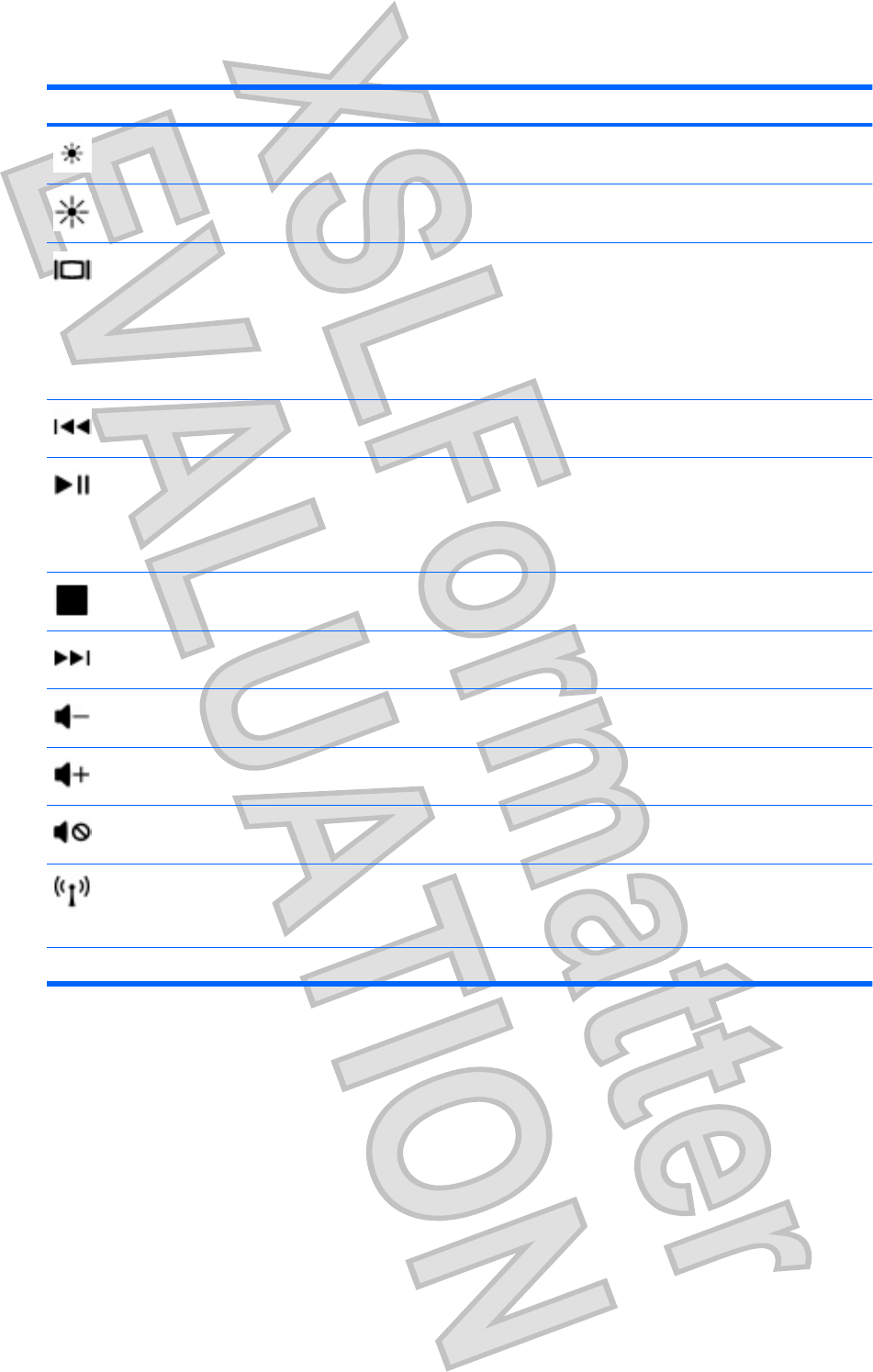
Icon Action Description
Screen brightness down Decreases the screen brightness level incrementally when you hold down this key.
Screen brightness up Increases the screen brightness level incrementally when you hold down this key.
Switch screen image Switches the screen image among display devices connected to the system. For
example, if a monitor is connected to the computer, pressing this key alternates the
screen image from computer display to monitor display to simultaneous display on both
the computer and the monitor.
Most external monitors receive video information from the computer using the external
VGA video standard. The switch screen image key can also alternate images among
other devices that are receiving video information from the computer.
Previous track Plays the previous track of an audio CD or the previous section of a DVD or a BD.
Play/Pause Plays, pauses, or resumes an audio CD, a DVD, or a BD.
łIf an audio CD, a DVD, or a BD is not playing, press this key to begin or resume
the play.
łIf an audio CD, a DVD, or a BD is playing, press this key to pause the play.
Stop Stops audio or video playback of a CD, a DVD, or a BD.
Next track Plays the next track of an audio CD or the next section of a DVD or a BD.
Volume down Decreases speaker sound incrementally when you hold down this key.
Volume up Increases speaker sound incrementally when you hold down this key.
Mute Mutes or restores speaker sound.
Wireless Turns the wireless feature on or off.
NOTE: This key does not establish a wireless connection. To establish a wireless
connection, a wireless network must be set up.
prt sc Print screen Takes a snapshot or picture of your computer screen and copies it to the clipboard.
Using the hotkeys
Hotkeys are combinations of the fn key (1) and either the esc key (3) or one of the arrow keys (4).
Using the hotkeys 33
Antenna House XSL Formatter (Evaluation) http://www.antennahouse.com/
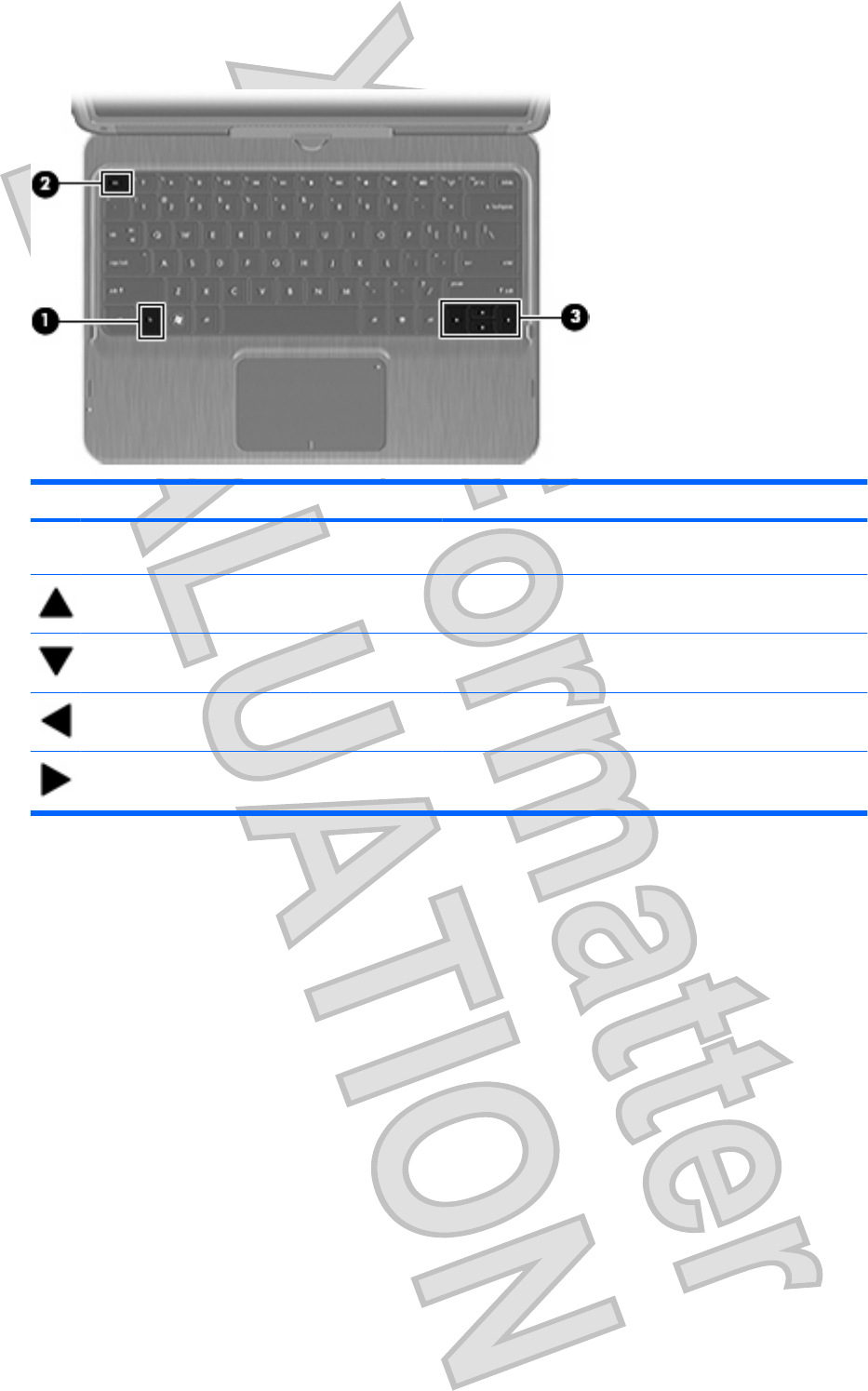
Hotkey Description
Display system information. fn+esc Displays information about system hardware components and
the system BIOS version number.
Scroll up. fn+up arrow Scrolls the page up.
Scroll down. fn+down arrow Scrolls the page down.
Go home. fn+left arrow Returns the cursor to the beginning of the line where the cursor
is located or returns to the beginning of the document.
Go to the end. fn+right arrow Places the cursor at the end of the line or scrolls to the end of
the document.
To use a hotkey command, follow either of these steps:
łBriefly press the fn key, and then briefly press the second key of the hotkey command.
– or –
łPress and hold down the fn key, briefly press the second key of the hotkey command, and then
release both keys at the same time.
34 Chapter 6 Pointing devices and keyboard
Antenna House XSL Formatter (Evaluation) http://www.antennahouse.com/
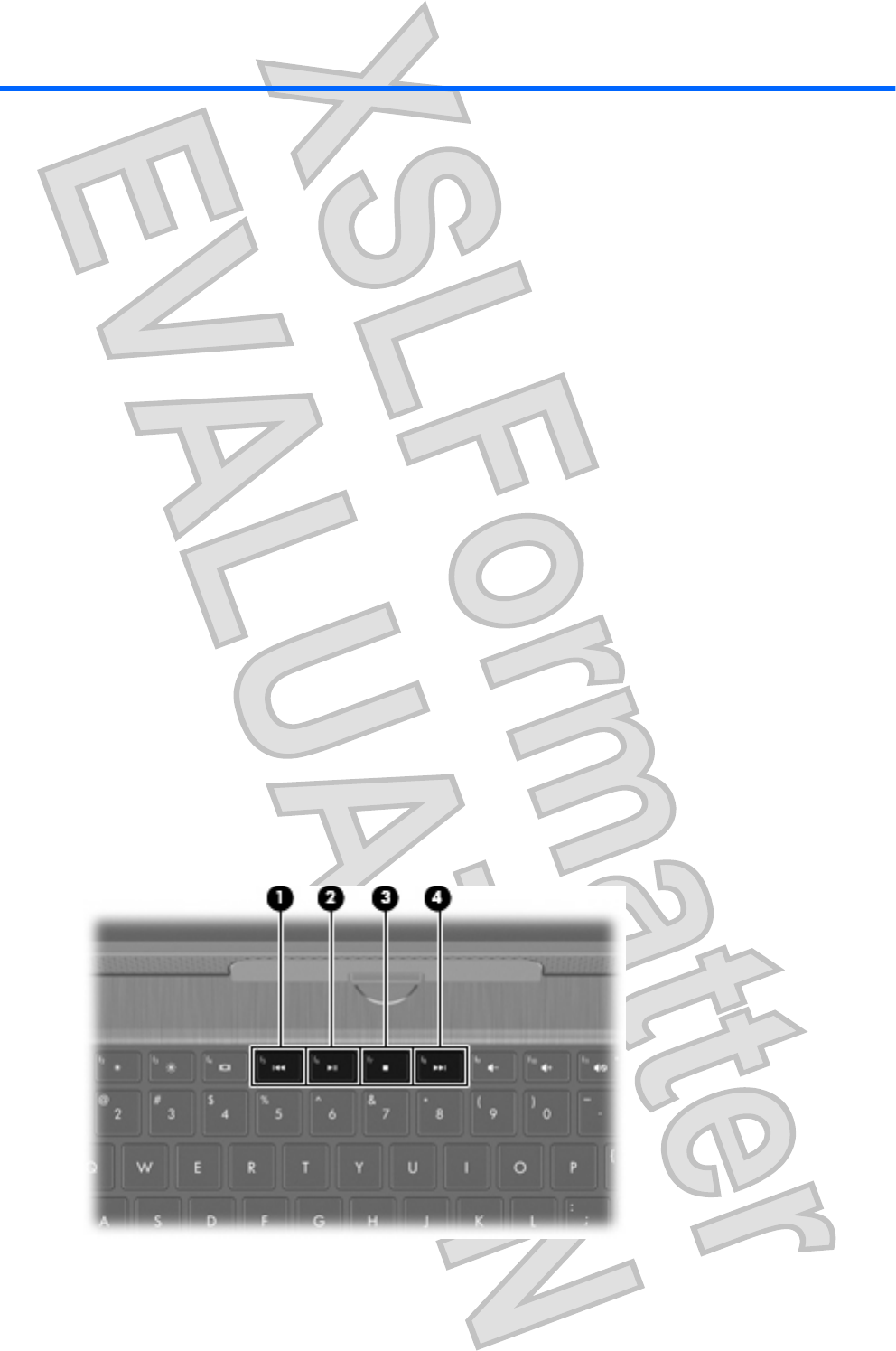
7Multimedia
Your computer includes multimedia features that allow you to listen to music, watch movies, and view
pictures. Your computer may include the following multimedia components:
łIntegrated speakers for listening to music
łIntegrated microphones for recording your own audio
łIntegrated webcam that allows you to capture and share video
łPreinstalled multimedia software that allows you to play and manage your music, movies, and
pictures
łMultimedia keys that provide fast access to multimedia tasks
The following sections explain how to use the multimedia components included with your computer.
Using the media activity keys
The media activity keys control the play of an audio CD or a DVD or BD that is inserted into an external
optical drive (purchased separately).
łWhen an audio CD or a DVD is not playing, press the play/pause key (2) to play the disc.
łWhen an audio CD or a DVD is playing, use the following keys:
ŃTo play the previous track of an audio CD or the previous chapter of a DVD, press the previous
track key (1).
ŃTo pause or resume playing the disc, press play/pause key (2).
ŃTo stop the disc, press the stop key (3).
ŃTo play the next track of an audio CD or the next chapter of a DVD, press the next track key
(4).
Using the media activity keys 35
Antenna House XSL Formatter (Evaluation) http://www.antennahouse.com/

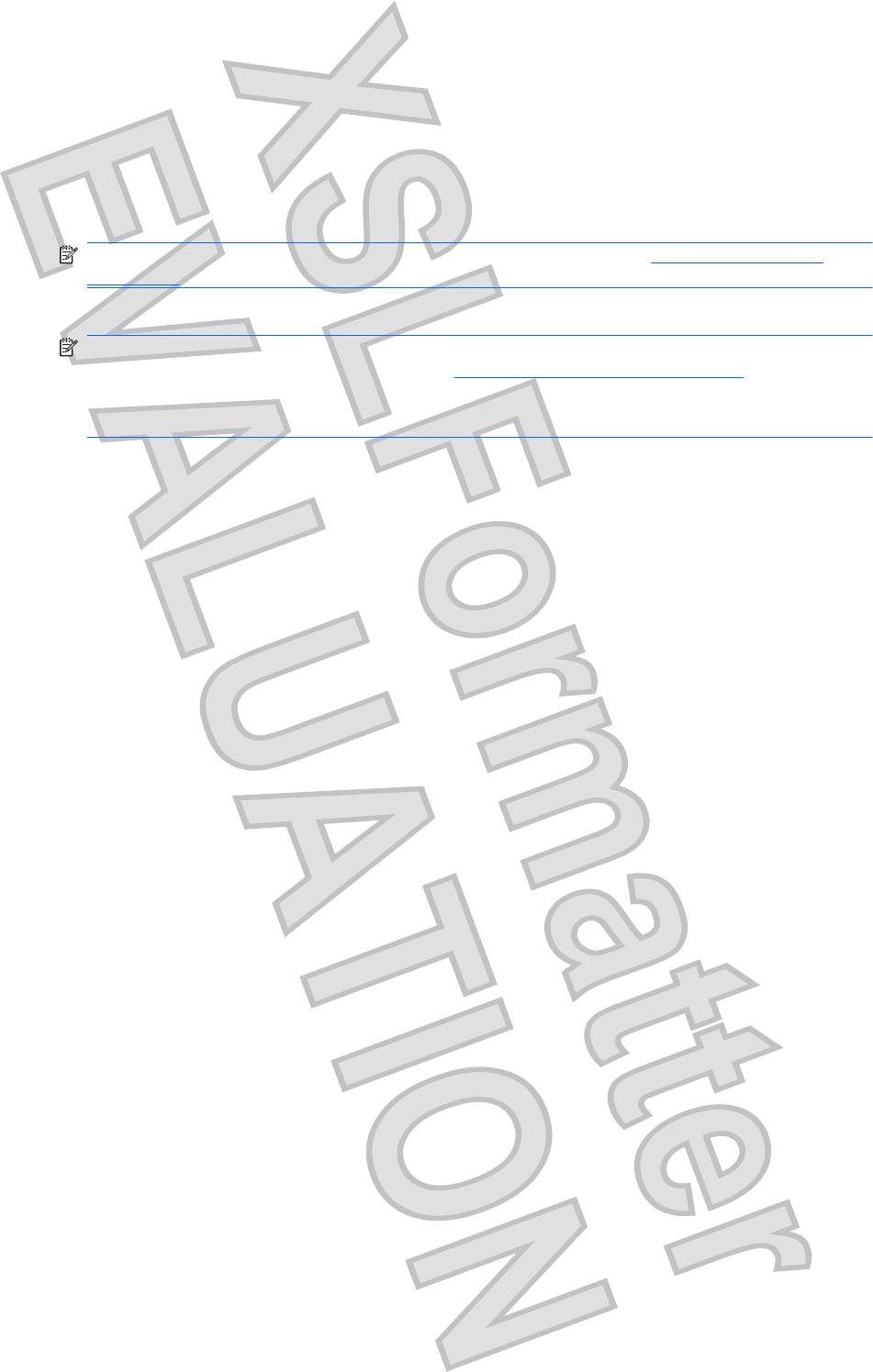
Installing multimedia software from a disc
Although your computer does not have an integrated optical drive, you can easily access software, install
applications, and access data in either of the following ways:
łConnect an external optical drive (select models only or purchased separately) to one of the USB
ports on your computer.
NOTE: For additional information on external optical drives, refer to Using external drives
on page 60.
łShare the optical drive that is connected to another computer on your network.
NOTE: You must have a network set up in order to share an optical drive. For additional
information on sharing optical drives, refer to Sharing an optical drive on page 61.
NOTE: Some discs, such as DVD movies and game discs, may be copy-protected and therefore
unusable through DVD or CD sharing.
Audio
Your computer enables you to use a variety of audio features:
łPlay music using your computer speakers and/or connected external speakers
łRecord sound using the internal microphone or connect an external microphone
łDownload music from the Internet
łCreate multimedia presentations using audio and images
łTransmit sound and images with instant messaging programs
łStream radio programs
łCreate (burn) audio CDs with an optional optical drive
Adjusting the volume
You can adjust the volume using the computer volume keys.
łTo decrease volume, press the volume down key (1).
łTo increase volume, press the volume up key (2).
łTo mute or restore volume, press the mute key (3).
Audio 37
Antenna House XSL Formatter (Evaluation) http://www.antennahouse.com/

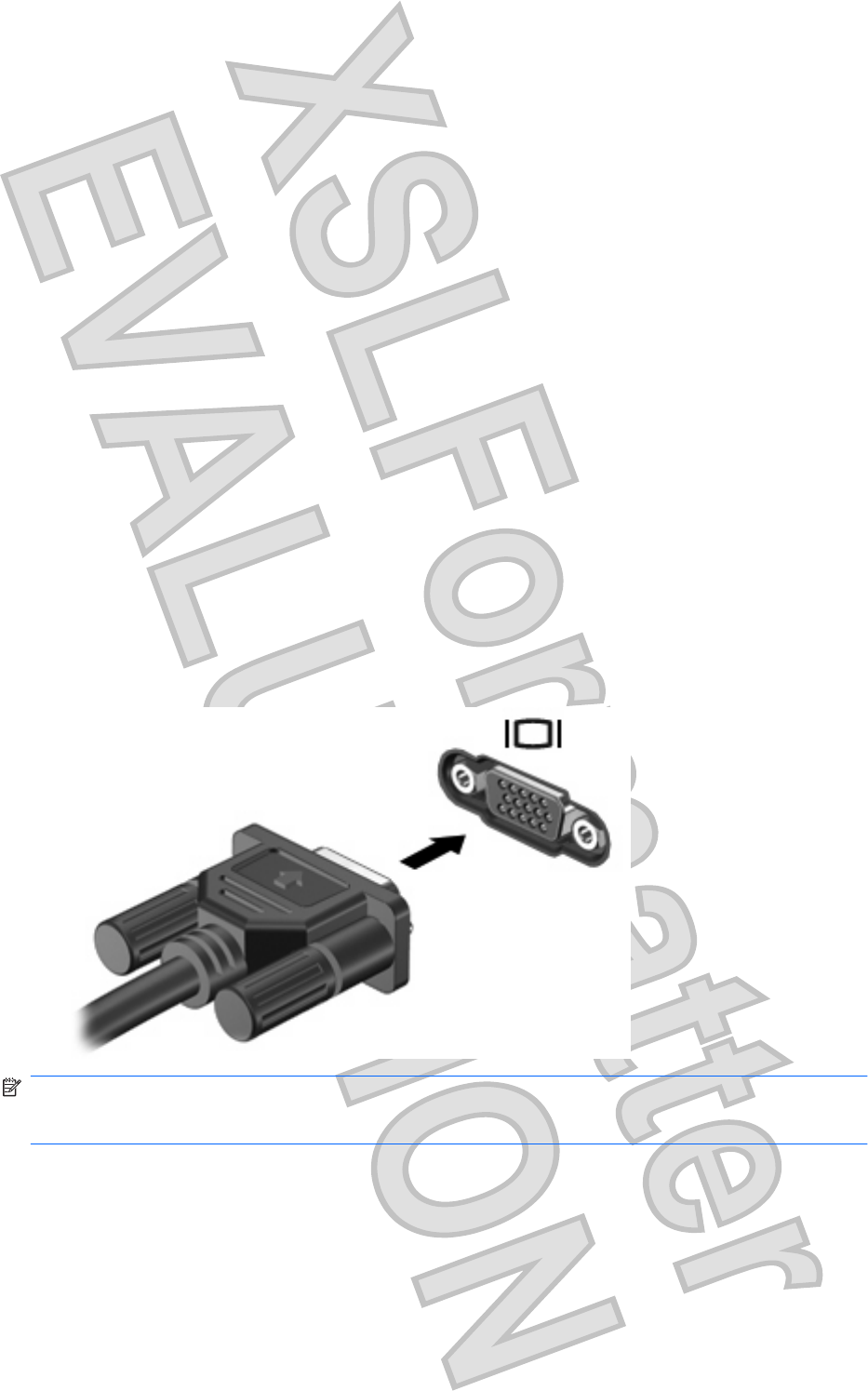
łGamma—Controls the contrast affecting the mid-level grays or midtones of an image. Adjusting
the gamma of an image allows you to change the brightness values of the middle range of gray
tones without dramatically altering the shadows and highlights. A lower gamma setting makes
grays look black, and makes dark colors even darker.
łBacklight Comp—Compensates in cases where a subject with a large amount of background light
would otherwise be obscured by blooming or silhouetting.
For more information about using the webcam, select Start > Help and Support.
Video
Your computer enables you to use a variety of video features:
łWatch movies
łPlay games over the Internet
łEdit pictures and video and create presentations
łConnect external video devices
łWatch TV over the Internet
Using the external monitor port
The external monitor port connects an external display device, such as an external monitor or a projector,
to the computer.
To connect a display device, connect the device cable to the external monitor port.
NOTE: If a properly connected external display device does not display an image, press the switch
screen image key to transfer the image to the device. Repeatedly pressing this key alternates the screen
image between the computer display and the device.
Connecting an HDMI device
The computer includes an HDMI (High Definition Multimedia Interface) port. The HDMI port connects
the computer to an optional video or audio device, such as a high-definition television, or any compatible
digital or audio component.
40 Chapter 7 Multimedia
Antenna House XSL Formatter (Evaluation) http://www.antennahouse.com/
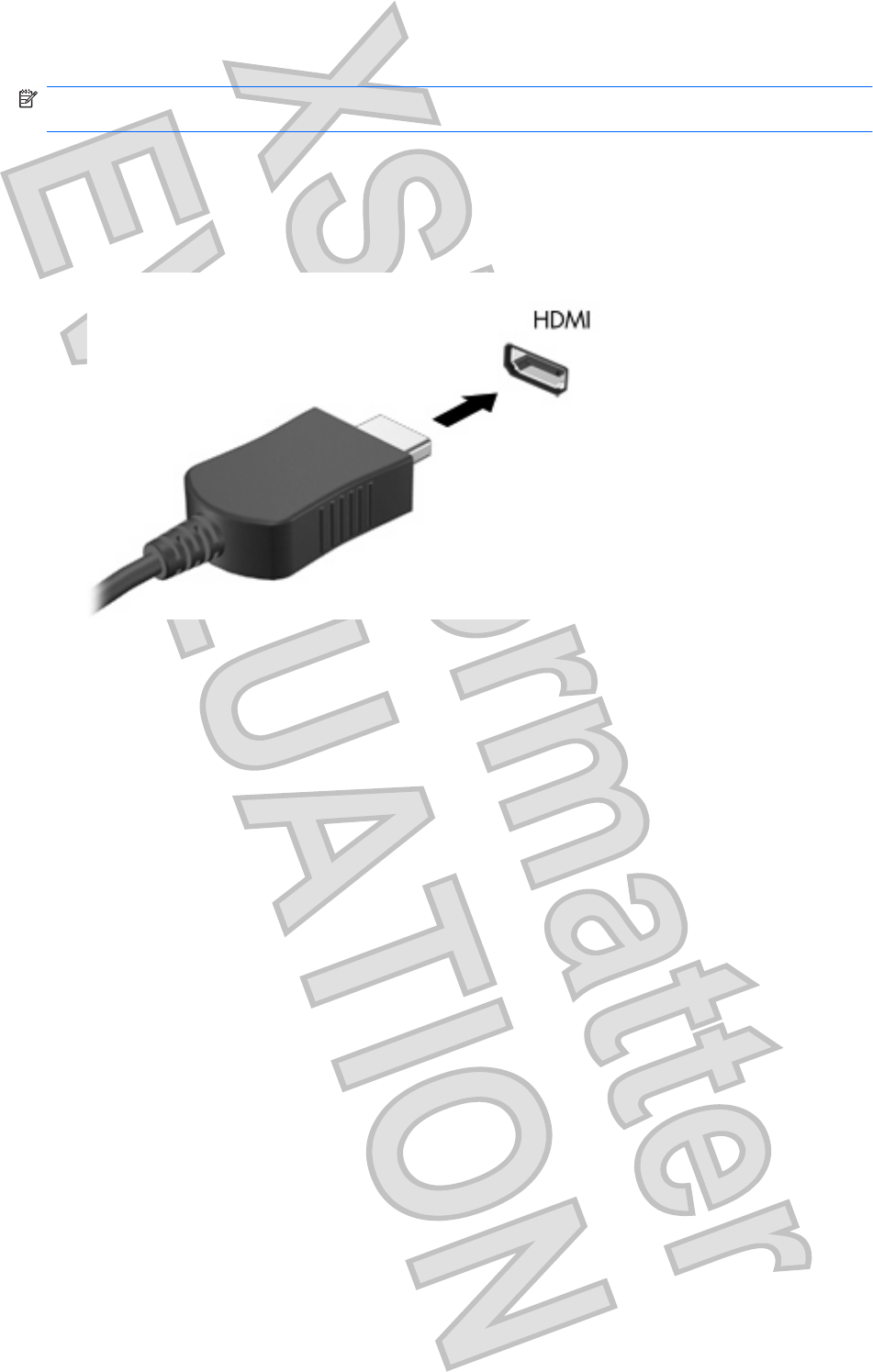
NOTE: To transmit video signals through the HDMI port, you need an HDMI cable (purchased
separately).
The computer can support one HDMI device connected to the HDMI port, while simultaneously
supporting an image on the computer display or any other supported external display.
To connect a video or audio device to the HDMI port:
1. Connect one end of the HDMI cable to the HDMI port on the computer.
2. Connect the other end of the cable to the video device, according to the device manufacturer’s
instructions.
3. Press the switch screen image key on the computer to switch the image between the display
devices connected to the computer.
Configuring audio for HDMI
To configure HDMI audio, first connect an audio or video device, such as a high-definition TV, to the
HDMI port on your computer. Then configure the default audio playback device as follows:
1. Right-click the Speakers icon in the notification area, at the far right of the taskbar, and then click
Playback devices.
2. On the Playback tab, click either Digital Output or Digital Output Device (HDMI).
3. Click Set Default, and then click OK.
To return audio to the computer speakers, follow these steps:
1. Right-click the Speakers icon in the notification area, at the far right of the taskbar, and then click
Playback devices.
2. On the Playback tab, click Speakers.
3. Click Set Default, and then click OK.
Video 41
Antenna House XSL Formatter (Evaluation) http://www.antennahouse.com/
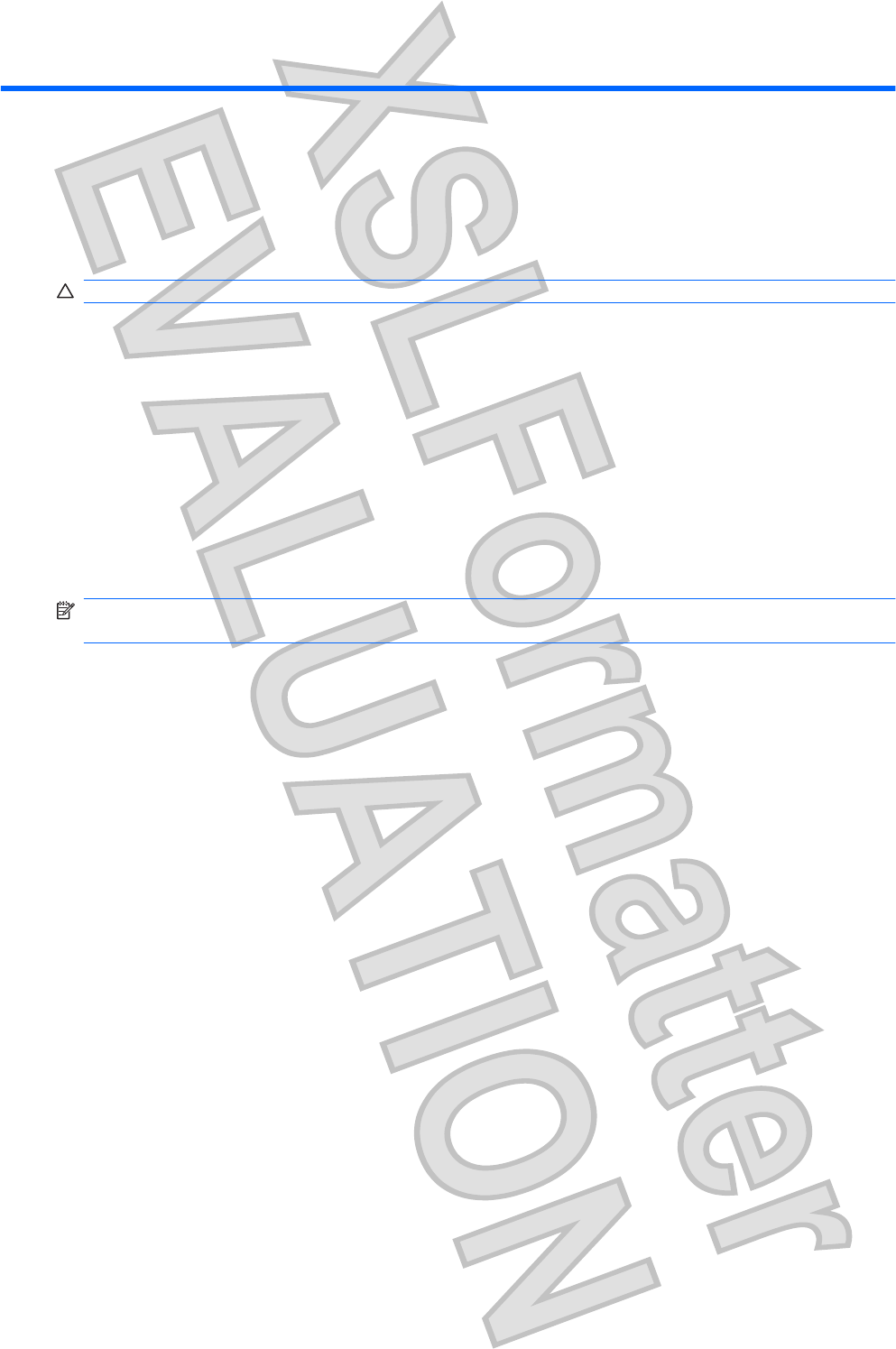
8 Power management
Shutting down the computer
CAUTION: Unsaved information will be lost when the computer is shut down.
The Shut down command closes all open programs, including the operating system, and then turns off
the display and computer.
Shut down the computer under any of the following conditions:
łWhen you need to replace the battery or access components inside the computer
łWhen you are connecting an external hardware device that does not connect to a USB port
łWhen the computer will be unused and disconnected from external power for an extended period
Although you can shut down the computer with the power switch, the recommended procedure is to use
the Windows Shut down command.
To shut down the computer:
NOTE: If the computer is in the Sleep state or in Hibernation, you must first exit Sleep or Hibernation
before shutdown is possible.
1. Save your work and close all open programs.
2. Click Start.
3. Click Shut down.
If the computer is unresponsive and you are unable to use the preceding shutdown procedures, try the
following emergency procedures in the sequence provided:
łPress ctrl+alt+delete, and then click the Power button.
łSlide and hold the power switch for at least 5 seconds.
łDisconnect the computer from external power and remove the battery.
Setting power devices
Using power-saving states
The computer has two power-saving states enabled at the factory: Sleep and Hibernation.
When Sleep is initiated, the power light blinks and the screen clears. Your work is saved to memory,
letting you exit Sleep faster than exiting Hibernation. If the computer is in the Sleep state for an extended
period or if the battery reaches a critical battery level while in the Sleep state, the computer initiates
Hibernation.
When Hibernation is initiated, your work is saved to a hibernation file on the hard drive and the computer
turns off.
42 Chapter 8 Power management
Antenna House XSL Formatter (Evaluation) http://www.antennahouse.com/

CAUTION: To prevent possible audio and video degradation, loss of audio or video playback
functionality, or loss of information, do not initiate Sleep or Hibernation while reading from or writing to
a disc or an external media card.
NOTE: You cannot initiate any type of networking connection or perform any computer functions while
the computer is in the Sleep state or in Hibernation.
Initiating and exiting Sleep
The system is set at the factory to initiate Sleep after 15 minutes of inactivity when running on battery
power and 30 minutes of inactivity when running on external power.
Power settings and timeouts can be changed using Power Options in Windows® Control Panel.
With the computer on, you can initiate Sleep in any of the following ways:
łBriefly slide the power switch.
łClose the display.
łClick Start, click the arrow next to the Shut down button, and then click Sleep.
You can exit Sleep in any of the following ways:
łBriefly slide the power switch.
łIf the display is closed, open the display.
łPress a key on the keyboard.
łActivate the TouchPad.
When the computer exits Sleep, the power light turns on and your work returns to the screen where you
stopped working.
NOTE: If you have set a password to be required on wakeup, you must enter your Windows password
before your work will return to the screen.
Initiating and exiting Hibernation
The system is set at the factory to initiate Hibernation after 1,080 minutes (18 hours) of inactivity when
running on battery power, 1,080 minutes (18 hours) of inactivity when running on external power, or
when the battery reaches a critical battery level.
Power settings and timeouts can be changed using Power Options in Windows Control Panel.
To initiate Hibernation:
Click Start, click the arrow next to the Shut down button, and then click Hibernate.
To exit Hibernation:
Briefly slide the power switch.
The power light turns on and your work returns to the screen where you stopped working.
NOTE: If you have set a password to be required on wakeup, you must enter your Windows password
before your work will return to the screen.
Setting power devices 43
Antenna House XSL Formatter (Evaluation) http://www.antennahouse.com/

Conserving power
łSelect the Power saver power plan through Power Options under System and Security in
Windows Control Panel.
łTurn off wireless and local area network (LAN) connections and exit modem applications when you
are not using them.
łDisconnect external devices that are not plugged into an external power source, when you are not
using them.
łStop, disable, or remove any external media cards that you are not using.
łUse the screen brightness keys to adjust screen brightness as needed.
łIf you leave your work, initiate Sleep or Hibernation, or shut down the computer.
Using the battery meter
The battery meter is located in the notification area, at the far right of the taskbar. The battery meter
allows you to quickly access power settings, view remaining battery charge, and select a different power
plan.
łTo display the percentage of remaining battery charge and the current power plan, move the pointer
over the battery meter icon.
łTo access Power Options, or to change the power plan, click the battery meter icon and select an
item from the list.
Different battery meter icons indicate whether the computer is running on battery or external power. The
icon also displays a message if the battery has reached a low battery level, critical battery level, or
reserve battery level.
To hide or display the battery meter icon:
1. Right-click the Show hidden icons icon (the arrow at the left side of the notification area).
2. Click Customize notification icons.
3. Under Behaviors, select Show icon and notifications for the Power icon.
4. Click OK.
Using power plans
A power plan is a collection of system settings that manages how the computer uses power. Power
plans can help you conserve power or maximize performance.
You can change power plan settings or create your own power plan.
Viewing the current power plan
Click the battery meter icon in the notification area, at the far right of the taskbar.
– or –
Select Start > Control Panel > System and Security > Power Options.
Selecting a different power plan
Click the battery meter icon in the notification area, and then select a power plan from the list.
44 Chapter 8 Power management
Antenna House XSL Formatter (Evaluation) http://www.antennahouse.com/
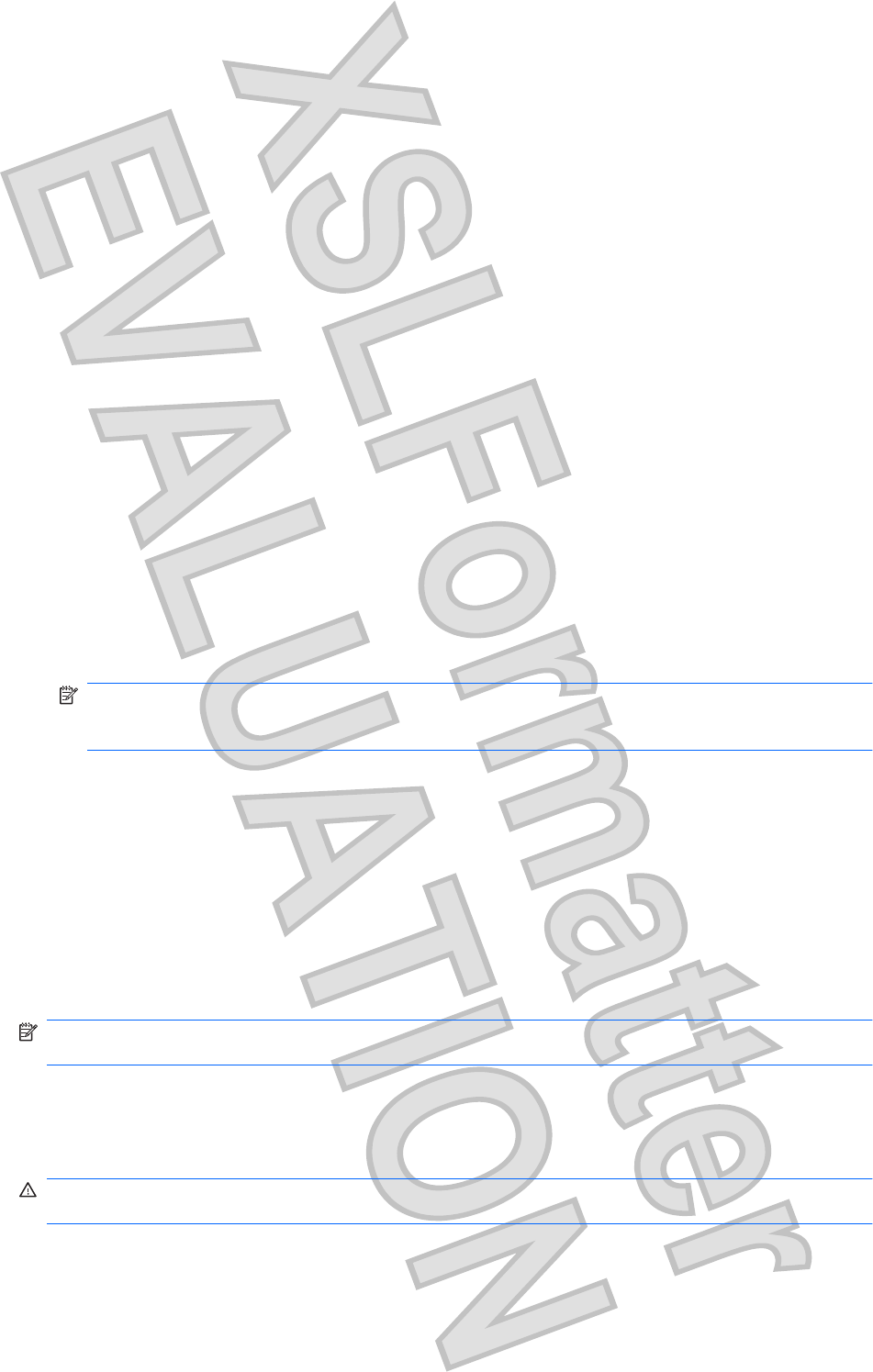
– or –
Select Start > Control Panel > System and Security > Power Options, and then select a power
plan from the list.
Customizing power plans
1. Click the battery meter icon in the notification area and then click More power options.
– or –
Select Start > Control Panel > System and Security > Power Options.
2. Select a power plan, and then click Change plan settings.
3. Change the settings as needed.
4. To change additional settings, click Change advanced power settings and make your changes.
Setting password protection on wakeup
To set the computer to prompt for a password when the computer exits Sleep or Hibernation, follow
these steps:
1. Select Start > Control Panel > System and Security > Power Options.
2. In the left pane, click Require a password on wakeup.
3. Click Change Settings that are currently unavailable.
4. Click Require a password (recommended).
NOTE: If you need to create a user account password or change your current user account
password, click Create or change your user account password, and then follow the on-screen
instructions. If you do not need to create or change a user account password, go to step 5.
5. Click Save changes.
Using battery power
When a charged battery is in the computer and the computer is not plugged into external power, the
computer runs on battery power. When the computer is plugged into external AC power, the computer
runs on AC power.
If the computer contains a charged battery and is running on external AC power supplied through the
AC adapter, the computer switches to battery power if the AC adapter is disconnected from the
computer.
NOTE: The display brightness is decreased to save battery life when you disconnect AC power. To
increase display brightness, press the increase screen brightness key or reconnect the AC adapter.
You can keep a battery in the computer or in storage, depending on how you work. Keeping the battery
in the computer whenever the computer is plugged into AC power charges the battery and also protects
your work in case of a power outage. However, a battery in the computer slowly discharges when the
computer is off and unplugged from external power.
WARNING! To reduce potential safety issues, use only the battery provided with the computer, a
replacement battery provided by HP, or a compatible battery purchased from HP.
Computer battery life varies, depending on power management settings, programs running on the
computer, display brightness, external devices connected to the computer, and other factors.
Using battery power 45
Antenna House XSL Formatter (Evaluation) http://www.antennahouse.com/
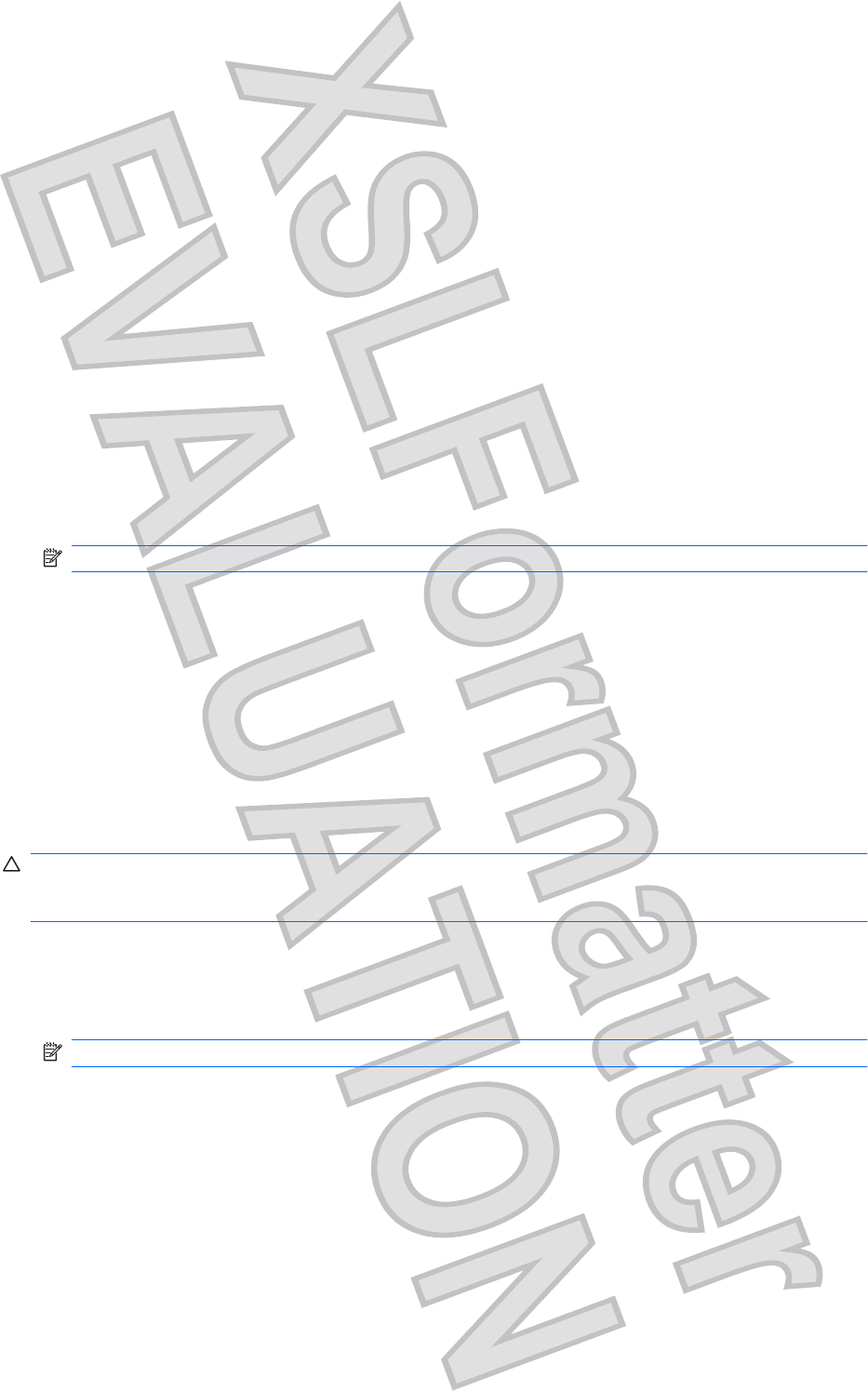
Finding battery information in Help and Support
Help and Support provides the following tools and information about the battery:
łBattery Check tool to test battery performance
łInformation on calibration, power management, and proper care and storage to maximize battery
life
łInformation on battery types, specifications, life cycles, and capacity
To access battery information:
Select Start > Help and Support > Learn > Power Plans: Frequently Asked Questions.
Using Battery Check
Battery Check in Help and Support provides information on the status of the battery installed in the
computer.
To run Battery Check:
1. Connect the AC adapter to the computer.
NOTE: The computer must be connected to external power for Battery Check to properly.
2. Select Start > Help and Support > Troubleshoot > Power, Thermal and Mechanical.
3. Click the Power tab, and then click Battery Check.
Battery Check examines the battery and its cells to see if they are functioning properly, and then reports
the results of the examination.
Displaying the remaining battery charge
Move the pointer over the battery meter icon in the notification area, at the far right of the taskbar.
Removing or inserting the battery
CAUTION: Removing a battery that is the sole power source can cause loss of information. To prevent
loss of information, initiate Hibernation or shut down the computer through Windows before removing
the battery.
To remove the battery:
1. Close the display and turn the computer upside down on a flat surface.
2. Slide the battery release latch (1) to release the battery.
NOTE: The battery release latch automatically returns to its original position.
46 Chapter 8 Power management
Antenna House XSL Formatter (Evaluation) http://www.antennahouse.com/
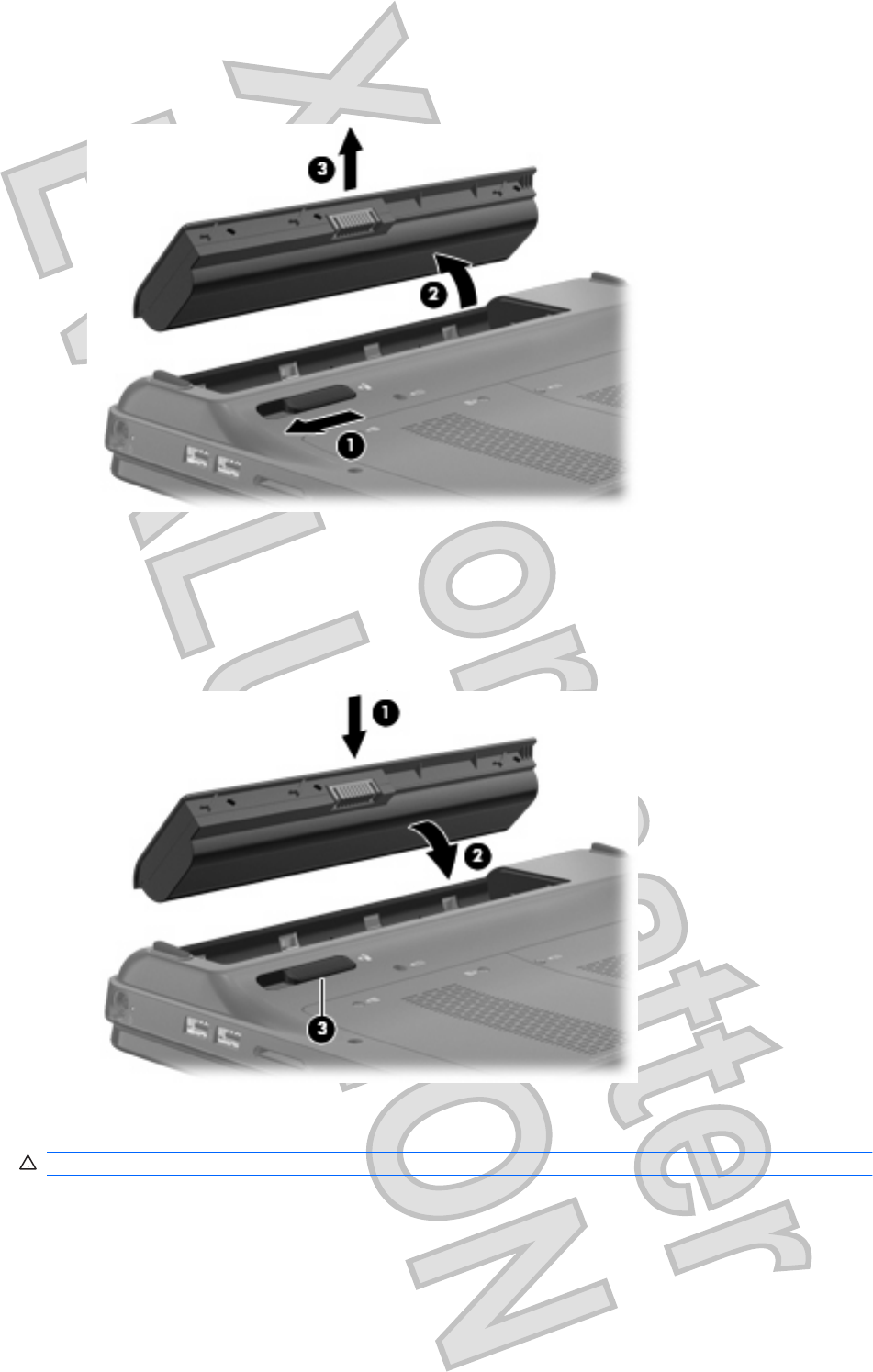
3. Pivot the battery (2) upward and remove it from the computer (3).
To insert the battery:
1. Close the display and turn the computer upside down on a flat surface.
2. Align the tabs on the battery with the notches on the outer edge of the battery bay (1) and rotate
the battery into the battery bay until it is seated (2).
3. The battery release latch (3) automatically locks the battery into place.
Charging a battery
WARNING! Do not charge the computer battery while you are onboard aircraft.
The battery charges whenever the computer is plugged into external power through an AC adapter or
an optional power adapter.
The battery charges whether the computer is off or in use, but it charges faster when the computer is
off.
Using battery power 47
Antenna House XSL Formatter (Evaluation) http://www.antennahouse.com/
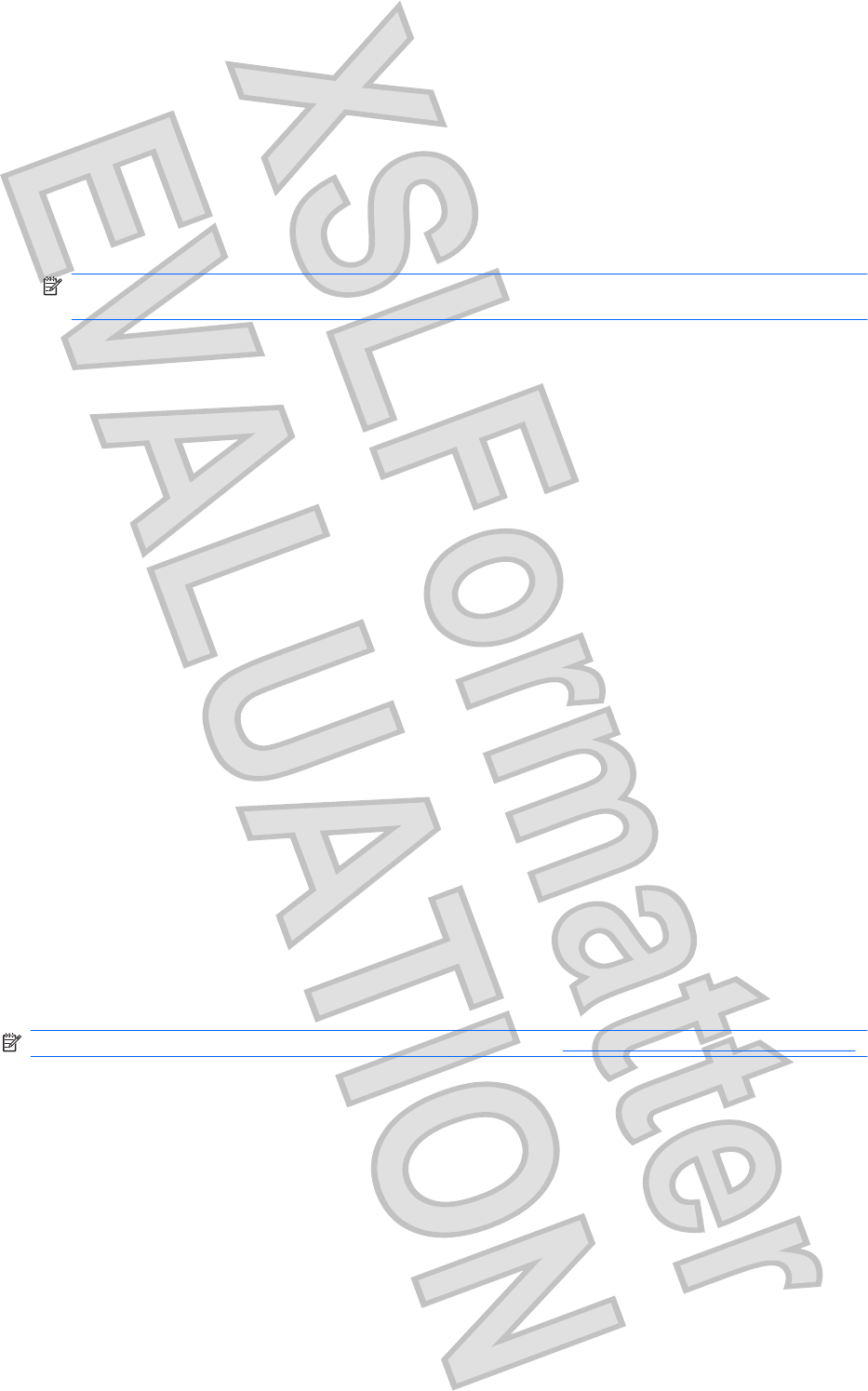
Charging may take longer if a battery is new, has been unused for 2 weeks or more, or is much warmer
or cooler than room temperature.
To prolong battery life and optimize the accuracy of battery charge displays, follow these
recommendations:
łIf you are charging a new battery, charge it fully before turning on the computer.
łCharge the battery until the battery light turns white.
NOTE: If the computer is on while the battery is charging, the battery meter in the notification
area may show 100 percent charge before the battery is fully charged.
łAllow the battery to discharge below 5 percent of a full charge through normal use before charging
it.
łIf the battery has been unused for one month or more, calibrate the battery instead of simply
charging it.
Maximizing battery discharge time
Battery discharge time varies depending on the features you use while on battery power. Maximum
discharge time gradually shortens, as the battery storage capacity naturally degrades.
Tips for maximizing battery discharge time:
łLower the brightness on the display.
łCheck the Power saver setting in Power Options.
łRemove the battery from the computer when it is not being used or charged.
łStore the battery in a cool, dry location.
Managing low battery levels
The information in this section describes the alerts and system responses set at the factory. Some low-
battery alerts and system responses can be changed using Power Options in Windows Control Panel.
Preferences set using Power Options do not affect lights.
Identifying low battery levels
When a battery that is the sole power source for the computer reaches a low or critical battery level, the
battery meter icon in the notification area shows a low or critical battery notification.
When the battery reaches a critical battery level, a notification appears above the battery meter icon
that shows how much battery charge remains.
NOTE: For additional information on the battery meter, refer to Using the battery meter on page 44.
The computer takes the following actions for a critical battery level:
łIf Hibernation is enabled and the computer is on or in the Sleep state, the computer initiates
Hibernation.
łIf Hibernation is disabled and the computer is on or in the Sleep state, the computer remains briefly
in the Sleep state, and then shuts down and loses any unsaved information.
48 Chapter 8 Power management
Antenna House XSL Formatter (Evaluation) http://www.antennahouse.com/
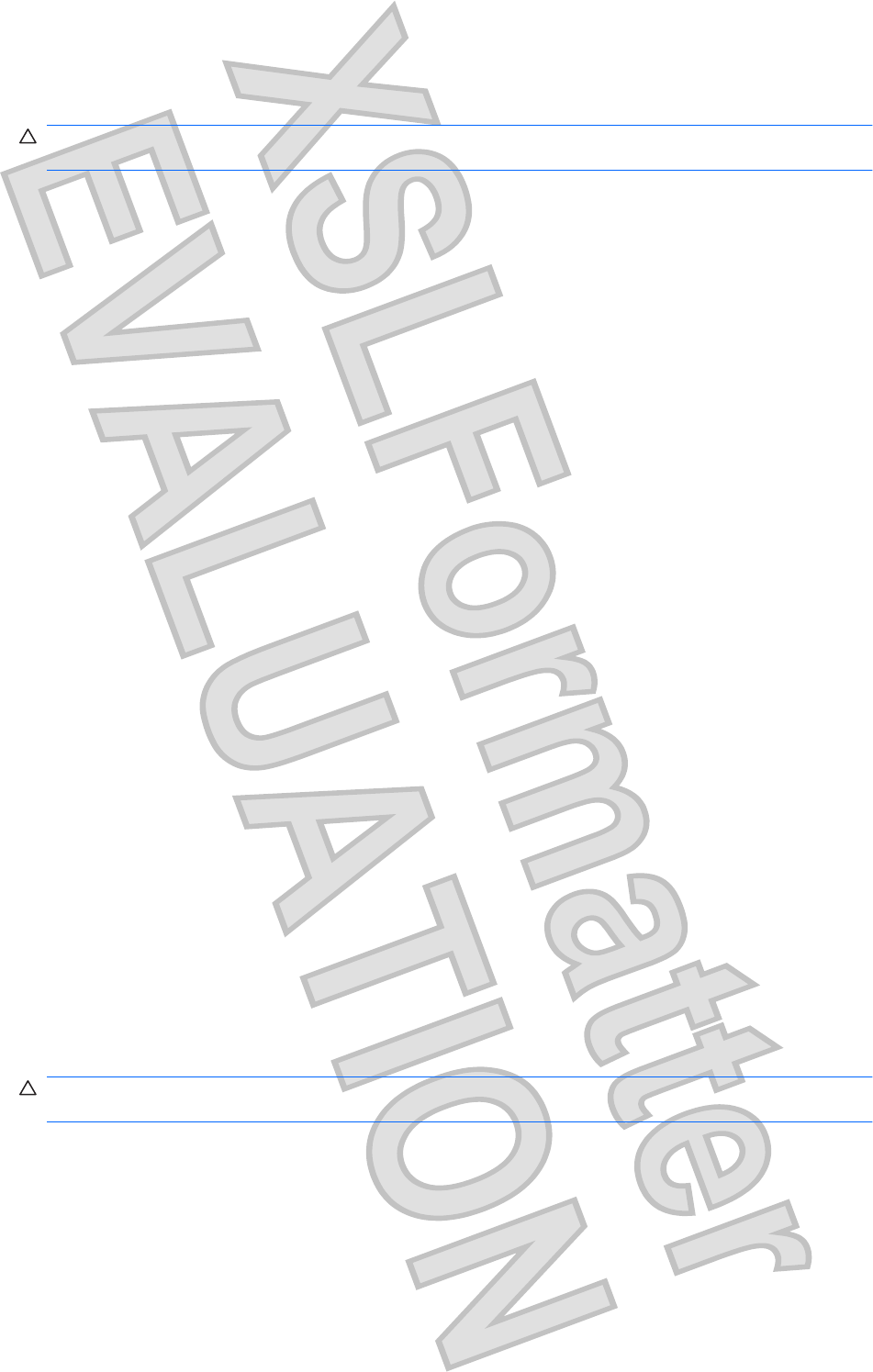
Resolving a low battery level
CAUTION: To reduce the risk of losing information when the computer reaches a critical battery level
and has initiated Hibernation, do not restore power until the power light turns off.
Resolving a low battery level when external power is available
Connect one of the following devices:
łAC adapter
łOptional power adapter purchased as an accessory from HP.
Resolving a low battery level when a charged battery is available
1. Turn off the computer or initiate Hibernation.
2. Remove the discharged battery, and then insert a charged battery.
3. Turn on the computer.
Resolving a low battery level when no power source is available
Initiate Hibernation.
– or –
Save your work and shut down the computer.
Resolving a low battery level when the computer cannot exit Hibernation
When the computer lacks sufficient power to exit Hibernation, follow these steps:
1. Insert a charged battery or plug the computer into external power.
2. Exit Hibernation by sliding the power switch.
Calibrating a battery
To maximize battery performance, you should calibrate a battery under the following conditions:
łWhen battery charge displays seem inaccurate
łWhen you observe a significant change in battery run time
Even if a battery is heavily used, it should not need to be calibrated more than once a month. It is also
not necessary to calibrate a new battery.
To calibrate a battery and for additional information, select Start > Help and Support.
Storing a battery
CAUTION: To prevent damage to a battery, do not expose it to high temperatures for extended periods
of time.
If a computer will be unused and unplugged from external power for more than 2 weeks, remove the
battery and store it separately.
To prolong the charge of a stored battery, place it in a cool, dry place.
Calibrate a battery before using it if it has been stored for one month or more.
Using battery power 49
Antenna House XSL Formatter (Evaluation) http://www.antennahouse.com/
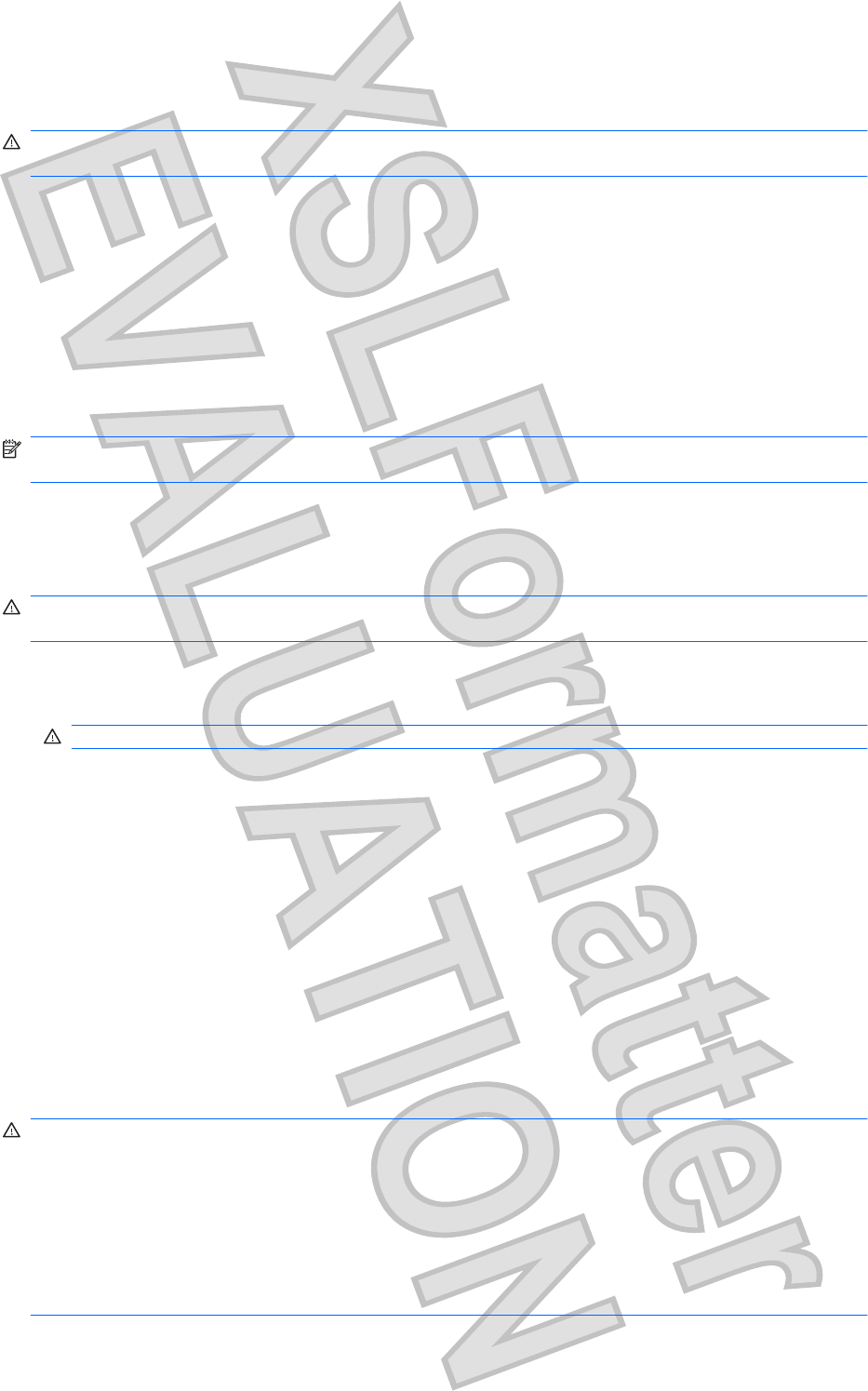
Disposing of a used battery
WARNING! To reduce the risk of fire or burns, do not disassemble, crush, or puncture; do not short
external contacts; do not dispose of in fire or water.
Refer to the Regulatory, Safety and Environmental Notices for proper battery disposal.
Replacing the battery
Computer battery life varies, depending on power management settings, programs running on the
computer, display brightness, external devices connected to the computer, and other factors.
Battery Check notifies you to replace the battery when an internal cell is not charging properly, or when
the battery storage capacity has reached a ”weak” condition. A message refers you to the HP Web site
for more information about ordering a replacement battery. If the battery is possibly covered by an HP
warranty, instructions include a warranty ID.
NOTE: To ensure that you always have battery power when you need it, HP recommends purchasing
a new battery when the storage capacity indicator turns green-yellow.
Using external AC power
External AC power is supplied through an approved AC adapter.
WARNING! To reduce potential safety issues, use only the AC adapter provided with the computer,
a replacement AC adapter provided by HP, or a compatible AC adapter purchased from HP.
Connect the computer to external AC power under any of the following conditions:
łWhen you are charging or calibrating a battery
WARNING! Do not charge the computer battery while you are onboard aircraft.
łWhen you are installing or modifying system software
łWhen you are writing information to an optional external CD or DVD
When you connect the computer to external AC power, the following events occur:
łThe battery begins to charge.
łIf the computer is turned on, the battery meter icon in the notification area changes appearance.
When you disconnect external AC power, the following events occur:
łThe computer switches to battery power.
łThe display brightness is automatically decreased to save battery life. To increase display
brightness, press the increase screen brightness key or reconnect the AC adapter.
Connecting AC power
WARNING! To reduce the risk of electric shock or damage to the equipment:
Plug the power cord into an AC outlet that is easily accessible at all times.
Disconnect power from the computer by unplugging the power cord from the AC outlet (not by
unplugging the power cord from the computer).
If provided with a 3-pin attachment plug on the power cord, plug the cord into a grounded (earthed) 3-
pin outlet. Do not disable the power cord grounding pin, for example, by attaching a 2-pin adapter. The
grounding pin is an important safety feature.
50 Chapter 8 Power management
Antenna House XSL Formatter (Evaluation) http://www.antennahouse.com/
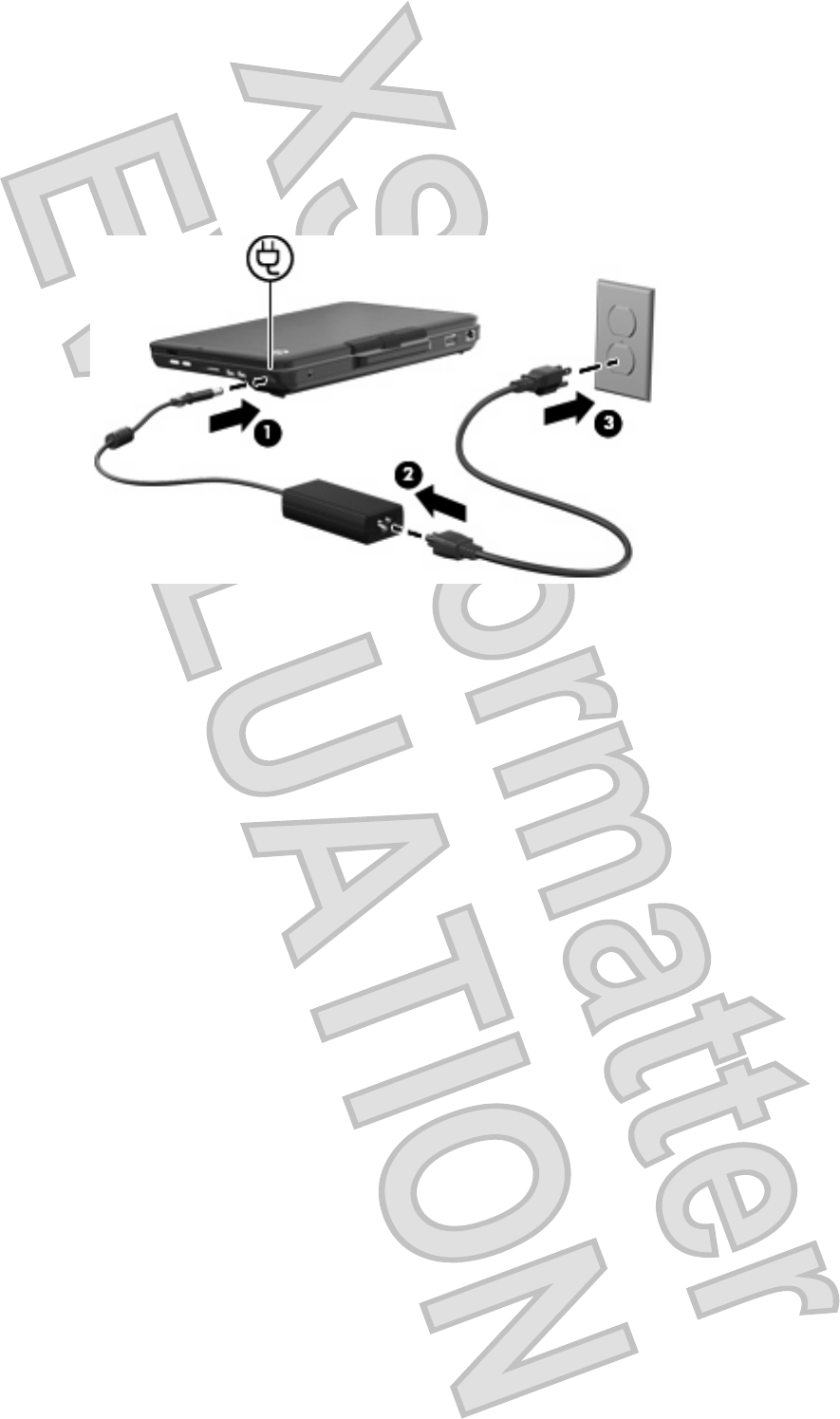
To connect the computer to external AC power:
1. Plug the adapter into the power connector (1) on the computer.
2. Plug the power cord into the adapter (2).
3. Plug the other end of the power cord into an AC outlet (3).
Testing an AC adapter
Test the AC adapter if the computer exhibits any of the following symptoms when it is connected to AC
power:
łThe computer will not turn on.
łThe display does not turn on.
łThe power light is off.
To test the AC adapter:
1. Remove the battery from the computer.
2. Connect the AC adapter to the computer, and then plug it into an AC outlet.
3. Turn on the computer.
łIf the power light turns on, the AC adapter is working properly.
łIf the power light remains off, the AC adapter is not functioning and should be replaced.
Contact technical support for information on obtaining a replacement AC power adapter.
Using external AC power 51
Antenna House XSL Formatter (Evaluation) http://www.antennahouse.com/
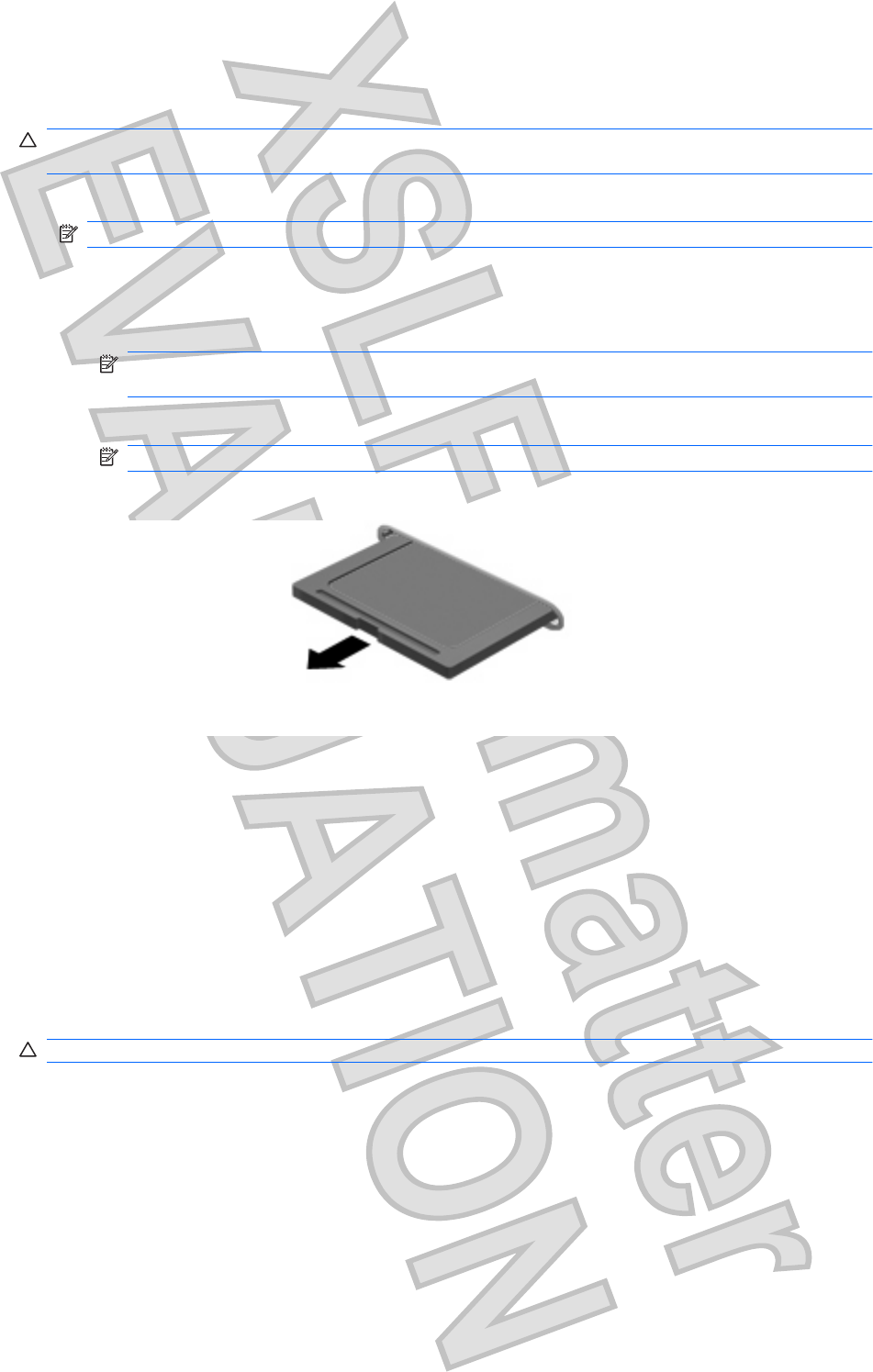
Removing a digital card
CAUTION: To prevent loss of data or an unresponsive system, use the following procedure to safely
remove the digital card.
1. Save your information and close all programs associated with the digital card.
NOTE: To stop a data transfer, click Cancel in the operating system Copying window.
2. To remove a digital card:
a. Click the Safely Remove Hardware and Eject Media icon in the notification area, at the far
right of the taskbar.
NOTE: To display the Safely Remove Hardware and Eject Media icon, click the Show
hidden icons icon (the arrow at the left of the notification area).
b. Click the name of the digital card in the list.
NOTE: You are prompted that it is safe to remove the hardware device.
3. Pull the digital card from the slot.
Using a USB device
A USB port connects an optional external device, such as a USB keyboard, mouse, drive, printer,
scanner, or hub, to the computer.
Some USB devices may require additional support software, which is usually included with the device.
For more information about device-specific software, refer to the manufacturer's instructions.
The computer has 3 USB ports, which support USB 1.0, USB 1.1, and USB 2.0 devices. To add more
USB ports, connect an optional hub.
Connecting a USB device
CAUTION: To prevent damage to a USB connector, use minimal force to connect a USB device.
Using a USB device 53
Antenna House XSL Formatter (Evaluation) http://www.antennahouse.com/
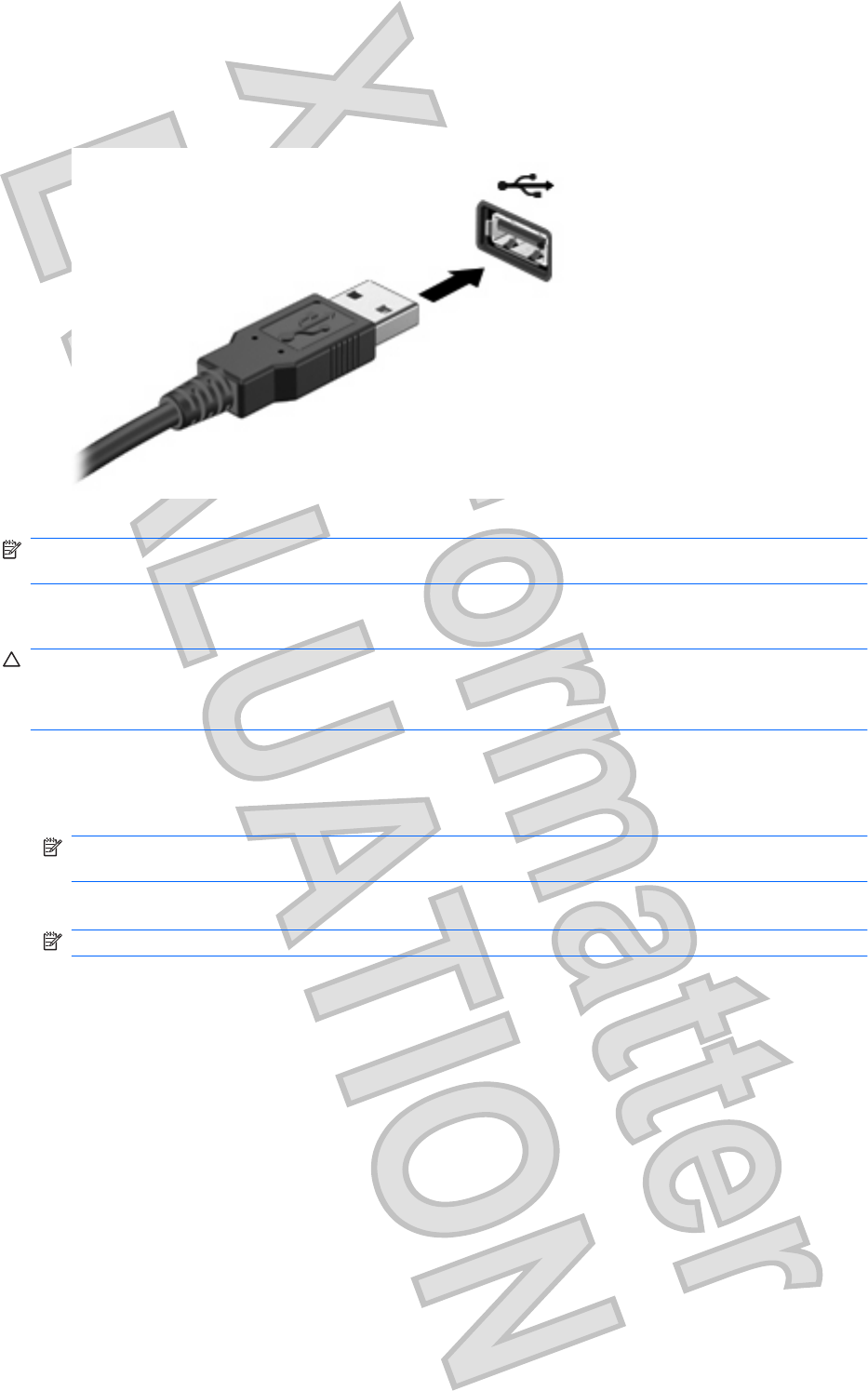
To connect a USB device to the computer, connect the USB cable for the device to the USB
port.
You will hear a sound when the device has been detected.
NOTE: The first time you connect a USB device, the "Installing device driver software" message is
displayed in the notification area, at the far right of the taskbar.
Removing a USB device
CAUTION: To prevent loss of information or an unresponsive system, use the following procedure to
safely remove the USB device.
CAUTION: To prevent damage to a USB connector, do not pull on the cable to remove the USB device.
To remove a USB device:
1. Click the Safely Remove Hardware and Eject Media icon in the notification area, at the far right
of the taskbar.
NOTE: To display the Safely Remove Hardware and Eject Media icon, click the Show hidden
icons icon (the arrow at the left of the notification area).
2. Click the name of the device in the list.
NOTE: You are prompted that it is safe to remove the hardware device.
3. Remove the device.
54 Chapter 9 External devices
Antenna House XSL Formatter (Evaluation) http://www.antennahouse.com/
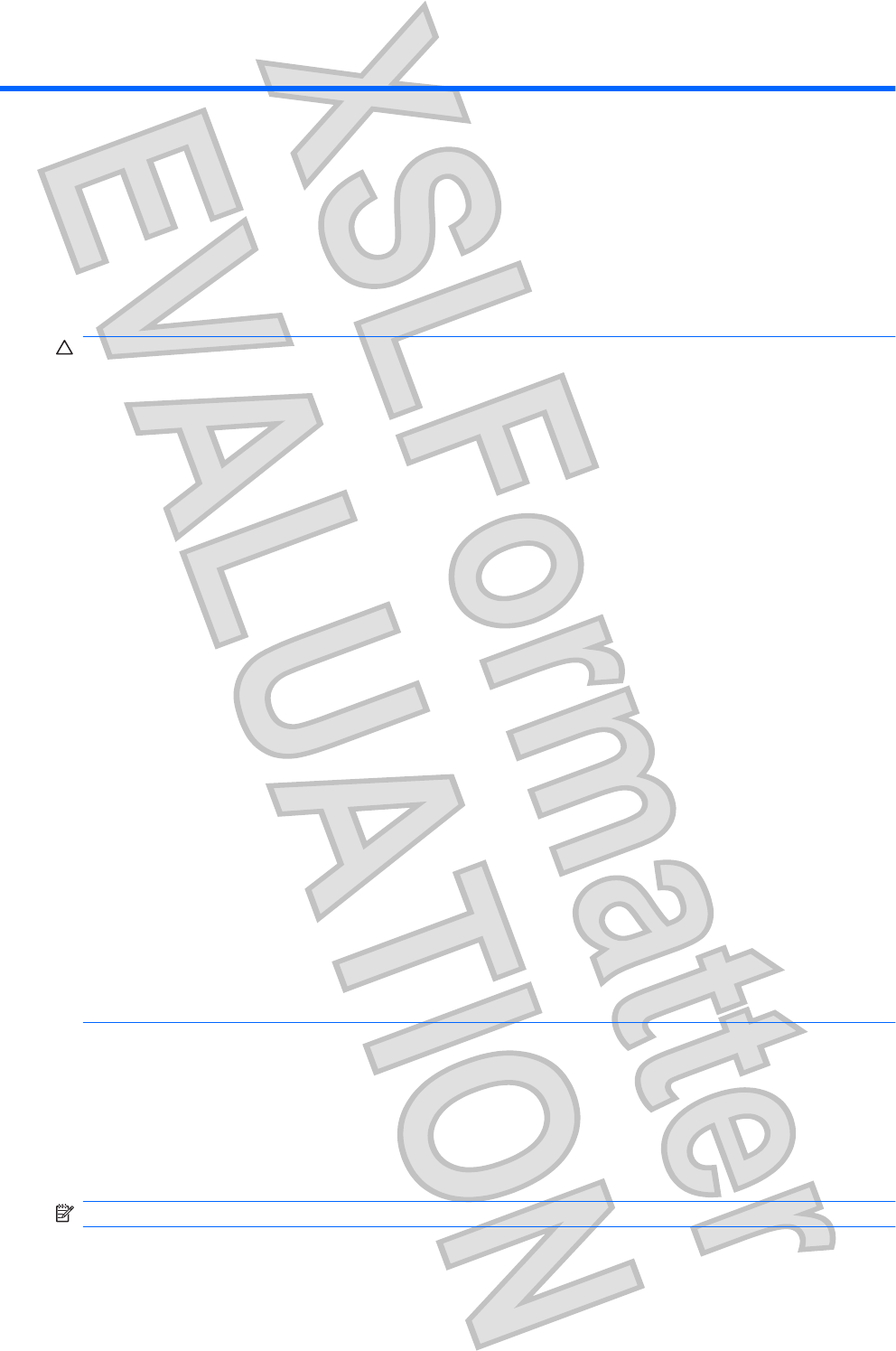
10 Drives
Handling drives
Drives are fragile computer components that must be handled with care. Refer to the following cautions
before handling drives. Additional cautions are included with the procedures to which they apply.
CAUTION: To reduce the risk of damage to the computer, damage to a drive, or loss of information,
observe these precautions:
Before you move a computer that is connected to an external hard drive, initiate Sleep and allow the
screen to clear, or properly disconnect the external hard drive.
Before handling a drive, discharge static electricity by touching the unpainted metal surface of the drive.
Do not touch the connector pins on a removable drive or on the computer.
Handle a drive carefully; do not drop a drive or place items on it.
Before removing or inserting a drive, shut down the computer. If you are unsure whether the computer
is off, in the Sleep state, or in Hibernation, turn the computer on, and then shut it down through the
operating system
Do not use excessive force when inserting a drive into a drive bay.
Do not type on the keyboard or move the computer while the optical drive is writing to a disc. The write
process is sensitive to vibration.
When the battery is the only source of power, be sure that the battery is sufficiently charged before
writing to media.
Avoid exposing a drive to temperature or humidity extremes.
Avoid exposing a drive to liquids. Do not spray the drive with cleaning products.
Remove media from a drive before removing the drive from the drive bay, or traveling with, shipping, or
storing a drive.
If a drive must be mailed, place the drive in a bubble-pack mailer or other suitable protective packaging
and label the package “FRAGILE.”
Avoid exposing a drive to magnetic fields. Security devices with magnetic fields include airport walk-
through devices and security wands. The airport security devices that check carry-on luggage, such as
conveyor belts, use x-rays instead of magnetism and will not damage a drive.
Improving hard drive performance
Using Disk Defragmenter
As you use the computer, files on the hard drive become fragmented. Disk Defragmenter consolidates
the fragmented files and folders on the hard drive so that the system can run more efficiently.
NOTE: It is not necessary to run Disk Defragmenter on solid-state drives.
Handling drives 55
Antenna House XSL Formatter (Evaluation) http://www.antennahouse.com/
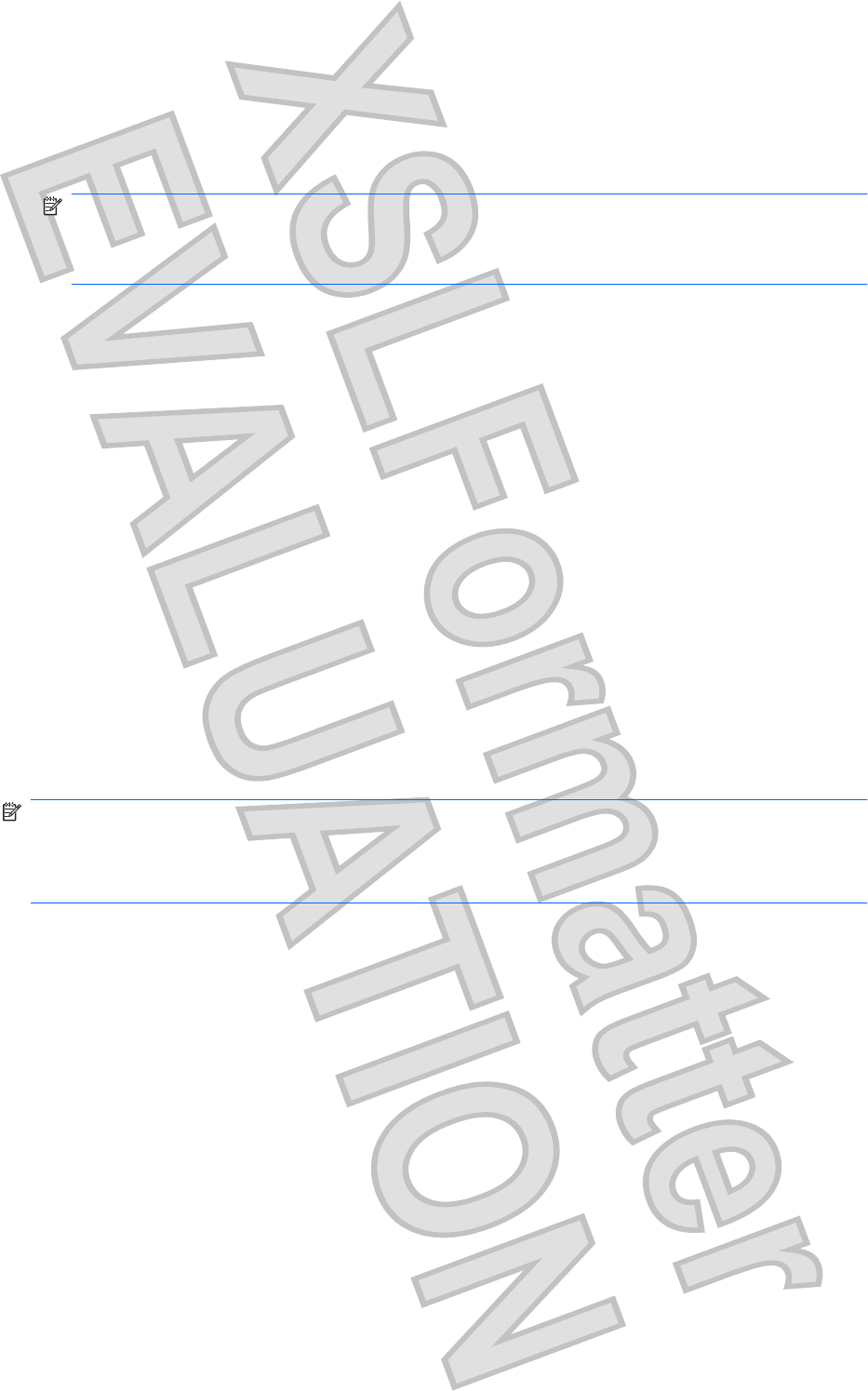
To run Disk Defragmenter:
1. Select Start > All Programs > Accessories > System Tools > Disk Defragmenter.
2. Click Defragment disk.
NOTE: Windows® includes the User Account Control feature to improve the security of your
computer. You may be prompted for your permission or password for tasks such as installing
applications, running utilities, or changing Windows settings. Refer to Help and Support for more
information.
For additional information, access the Disk Defragmenter software Help.
Using Disk Cleanup
Disk Cleanup searches the hard drive for unnecessary files that you can safely delete to free up disk
space and help the computer to run more efficiently.
To run Disk Cleanup:
1. Select Start > All Programs > Accessories > System Tools > Disk Cleanup.
2. Follow the on-screen instructions.
Using HP ProtectSmart Hard Drive Protection
HP ProtectSmart Hard Drive Protection protects a hard drive by parking the drive and halting data
requests under either of the following conditions:
łYou drop the computer.
łYou move the computer with the display closed while the computer is running on battery power.
A short time after the end of one of these events, HP ProtectSmart Hard Drive Protection returns the
hard drive to normal operation.
NOTE: Because solid-state drives (SSD) lack moving parts, HP ProtectSmart Hard Drive Protection
is unnecessary.
NOTE: Hard drives connected to USB ports are not covered by HP ProtectSmart Hard Drive
Protection.
For more information, refer to the HP ProtectSmart Hard Drive Protection software Help.
Identifying HP ProtectSmart Hard Drive Protection status
The drive light on the computer turns amber to show that the drive is parked. To determine whether
drives are currently protected or whether a drive is parked, select Start > Control Panel > Hardware
and Sound > Windows Mobility Center:
łIf the software is enabled, a green check mark is superimposed over the hard drive icon.
łIf the software is disabled, a red X is superimposed over the hard drive icon.
łIf the drives are parked, a yellow moon is superimposed over the hard drive icon.
The icon in the Mobility Center may not show the most up-to-date status for the drive. For immediate
updates after a change in status, you need to enable the notification area icon.
56 Chapter 10 Drives
Antenna House XSL Formatter (Evaluation) http://www.antennahouse.com/

To enable the notification area icon:
1. Select Start > Control Panel > Hardware and Sound > HP ProtectSmart Hard Drive
Protection.
NOTE: If prompted by User Account Control, click Yes.
2. On the Icon in System Tray row, click Show.
3. Click OK.
Managing power with a parked hard drive
If HP ProtectSmart Hard Drive Protection has parked the drive, the computer will behave in the following
ways:
łThe computer will not shut down.
łThe computer will not initiate Sleep or Hibernation, except as described in the following Note.
NOTE: If the computer is running on battery power and reaches a critical battery level, HP
ProtectSmart Hard Drive Protection allows the computer to initiate Hibernation.
Before you move the computer, HP recommends that you either shut it down or initiate Sleep or
Hibernation.
Using HP ProtectSmart Hard Drive Protection software
The HP ProtectSmart Hard Drive Protection software enables you to perform the following tasks:
łEnable and disable HP ProtectSmart Hard Drive Protection.
NOTE: Depending on your user privileges, you may not be able to enable or disable HP
ProtectSmart Hard Drive Protection. Additionally, members of an Administrator group can change
the privileges for non-Administrator users.
łDetermine whether a drive in the system is supported.
To open the software and change settings, follow these steps:
1. In Mobility Center, click the hard drive icon to open the HP ProtectSmart Hard Drive Protection
window.
– or –
Select Start > Control Panel > Hardware and Sound > HP ProtectSmart Hard Drive
Protection.
NOTE: If prompted by User Account Control, click Yes.
2. Click the appropriate button to change settings.
3. Click OK.
Using HP ProtectSmart Hard Drive Protection 57
Antenna House XSL Formatter (Evaluation) http://www.antennahouse.com/
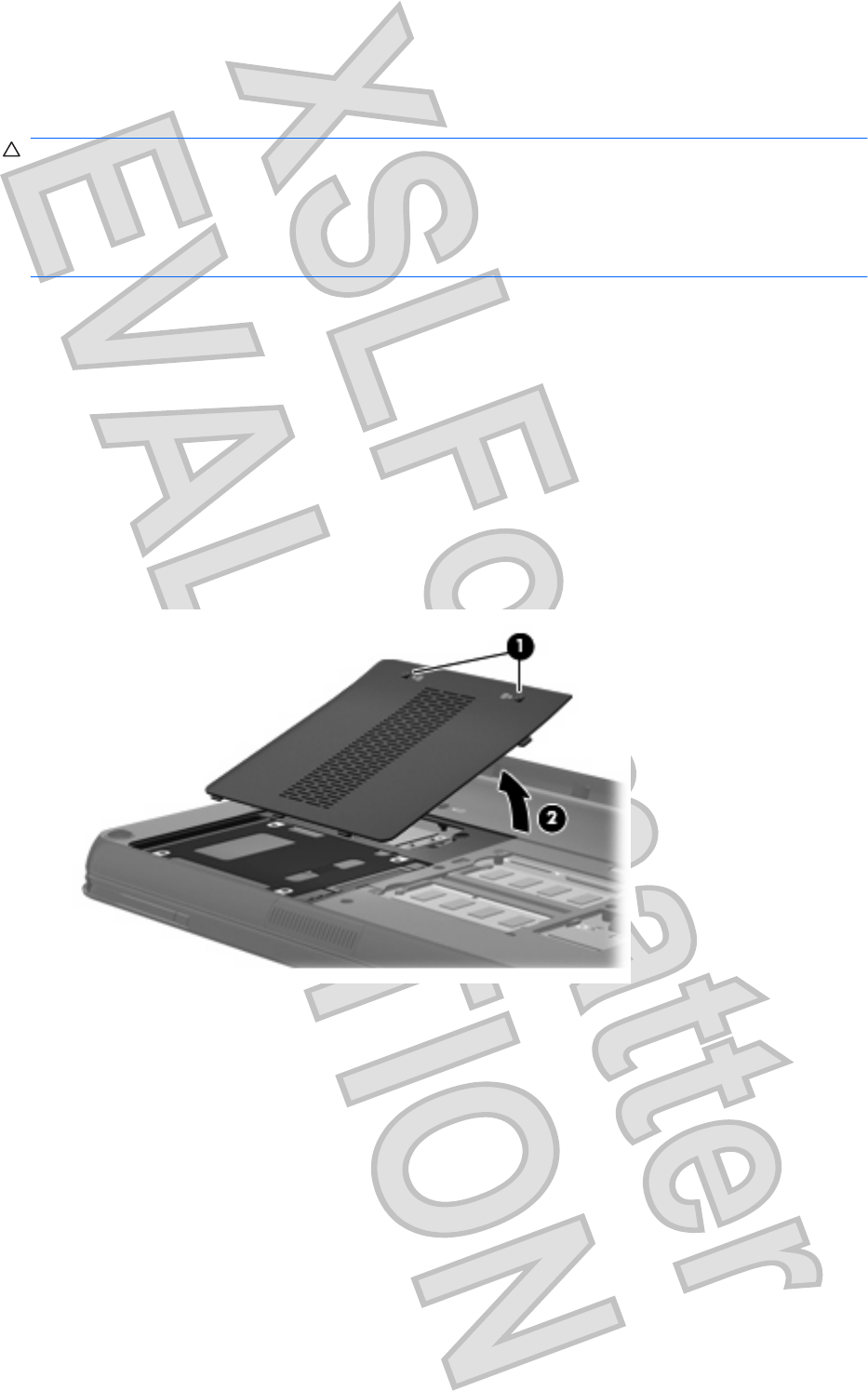
Inserting and removing a hard drive
CAUTION: To prevent information loss or an unresponsive system:
Shut down the computer before removing the hard drive from the hard drive bay. Do not remove the
hard drive while the computer is on, in the Sleep state, or in Hibernation.
If you are not sure whether the computer is off or in Hibernation, turn the computer on by sliding the
power switch. Then shut down the computer through the operating system.
To remove the hard drive:
1. Save your work.
2. Shut down the computer and close the display.
3. Disconnect all external devices connected to the computer.
4. Unplug the power cord from the AC outlet.
5. Turn the computer upside down on a flat surface.
6. Remove the battery from the computer.
7. With the hard drive bay toward you, loosen the 2 hard drive cover screws (1).
8. Remove the hard drive cover (2).
9. Pull the hard drive tab to the left (1) to disconnect the hard drive.
58 Chapter 10 Drives
Antenna House XSL Formatter (Evaluation) http://www.antennahouse.com/
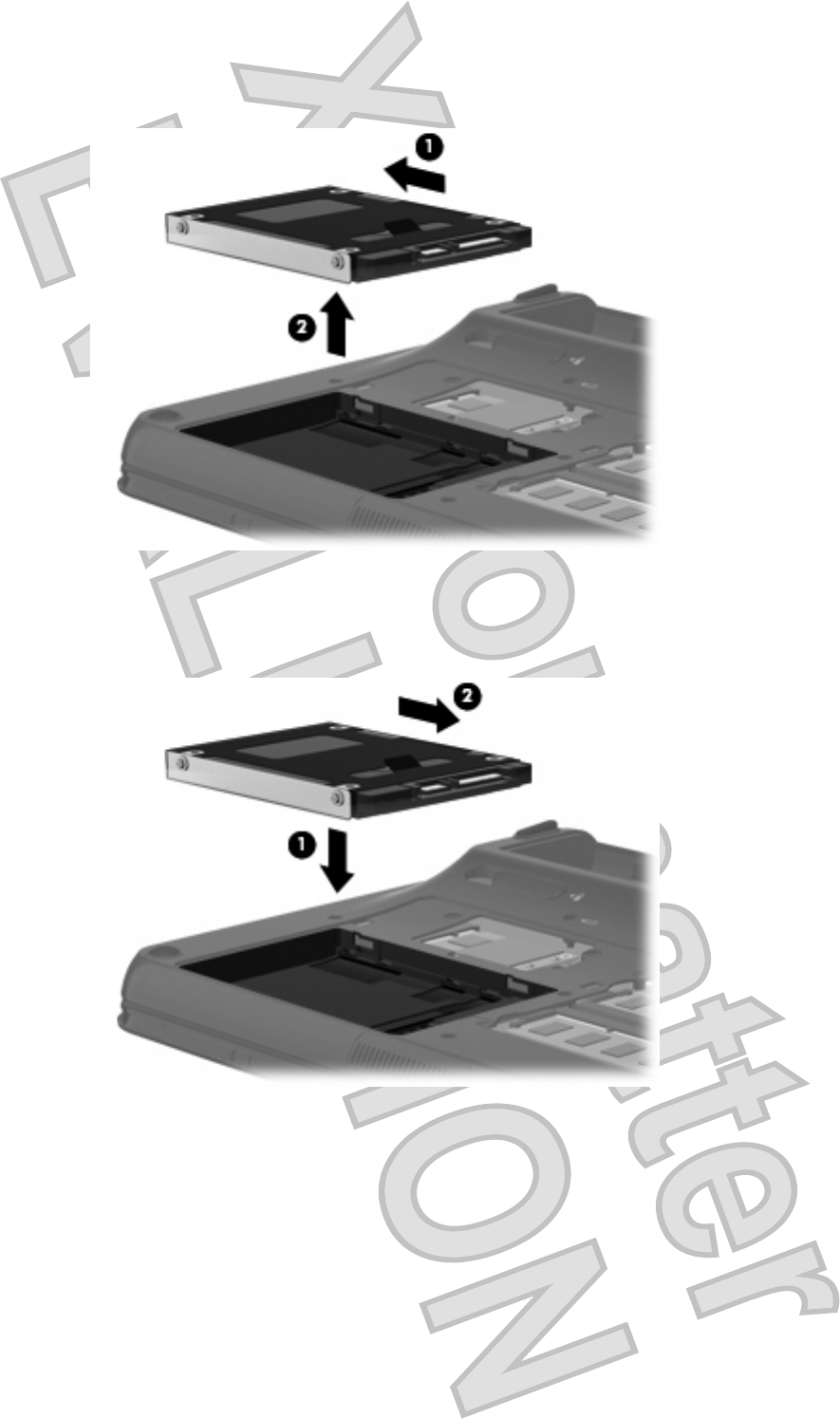
10. Lift the hard drive (2) out of the hard drive bay.
To install a hard drive:
1. Insert the hard drive into the hard drive bay (1).
2. Pull the hard drive tab (2) to the right until the hard drive snaps into place.
3. Align the tabs (1) on the hard drive cover with the notches on the computer.
4. Close the cover (2).
Inserting and removing a hard drive 59
Antenna House XSL Formatter (Evaluation) http://www.antennahouse.com/
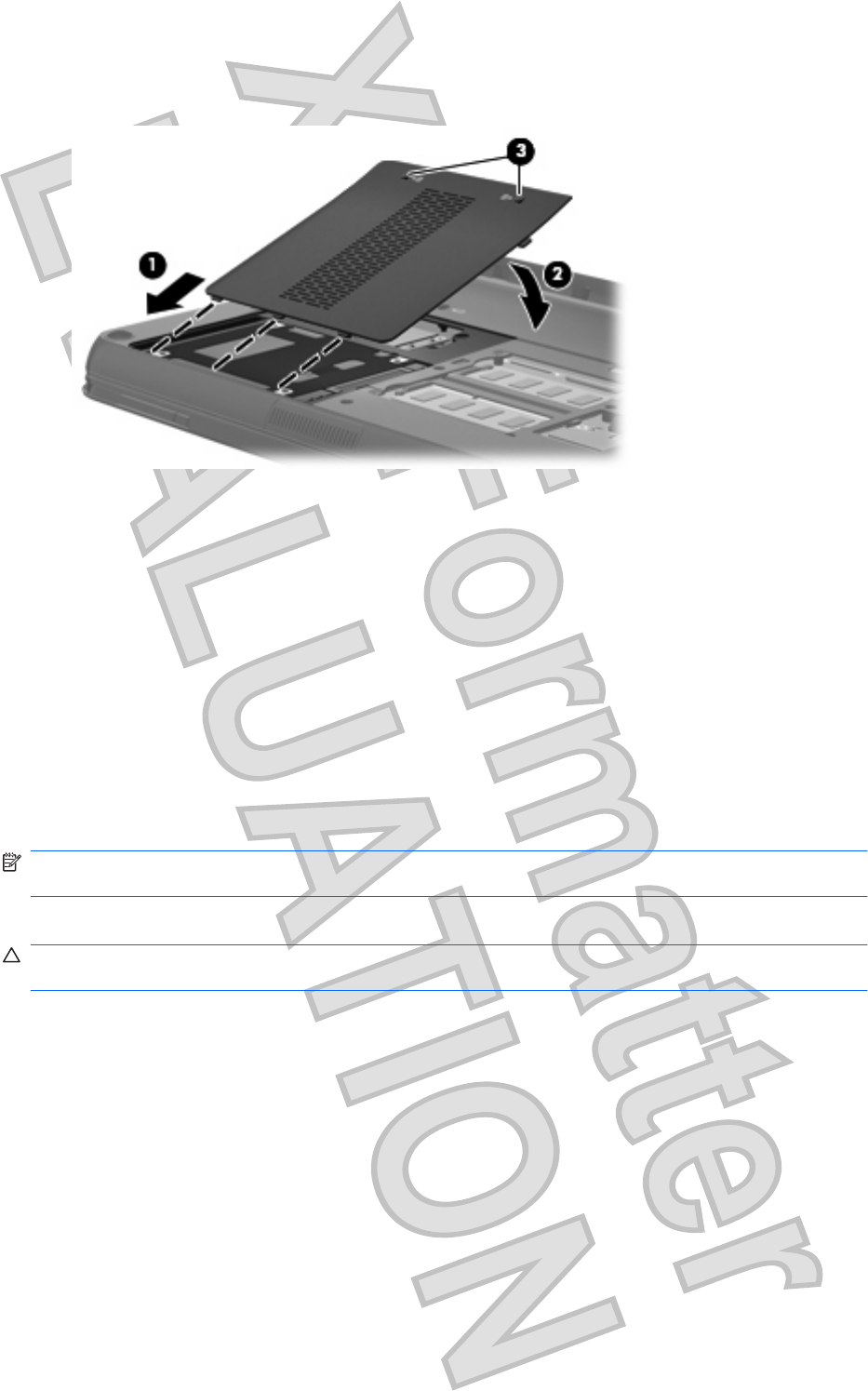
5. Tighten the hard drive cover screws (3).
Using external drives
Removable external drives expand your options for storing and accessing information.
USB drives include the following types:
ł1.44-megabyte diskette drive
łHard drive module (a hard drive with an adapter attached)
łDVD-ROM Drive
łDVD±RW SuperMulti Double-Layer (DL) Drive
łBlu-ray ROM DVD±R/RW SuperMulti Double-Layer (DL) Drive
Connecting optional external drives
NOTE: For more information about required software and drivers, or to learn which computer port to
use, refer to the manufacturer's instructions.
To connect an external drive to the computer:
CAUTION: To reduce the risk of damage to the equipment when connecting a powered drive, be sure
that the drive is turned off and the AC power cord is unplugged.
1. Connect the drive to the computer.
2. If you are connecting a powered drive, plug the device power cord into a grounded AC outlet.
3. Turn on the drive.
To disconnect an unpowered external drive, turn off the drive, and then disconnect it from the computer.
To disconnect a powered external drive, turn off the drive, disconnect it from the computer, and then
unplug the AC power cord.
Using an external optical drive
Select computer models ship with an external optical drive. An external optical drive connects to a USB
port on the computer and enables you to read data discs, play music, and watch movies. If your external
optical drive is a Blu-ray Disc (BD) drive, you can also watch high-definition video from discs.
60 Chapter 10 Drives
Antenna House XSL Formatter (Evaluation) http://www.antennahouse.com/
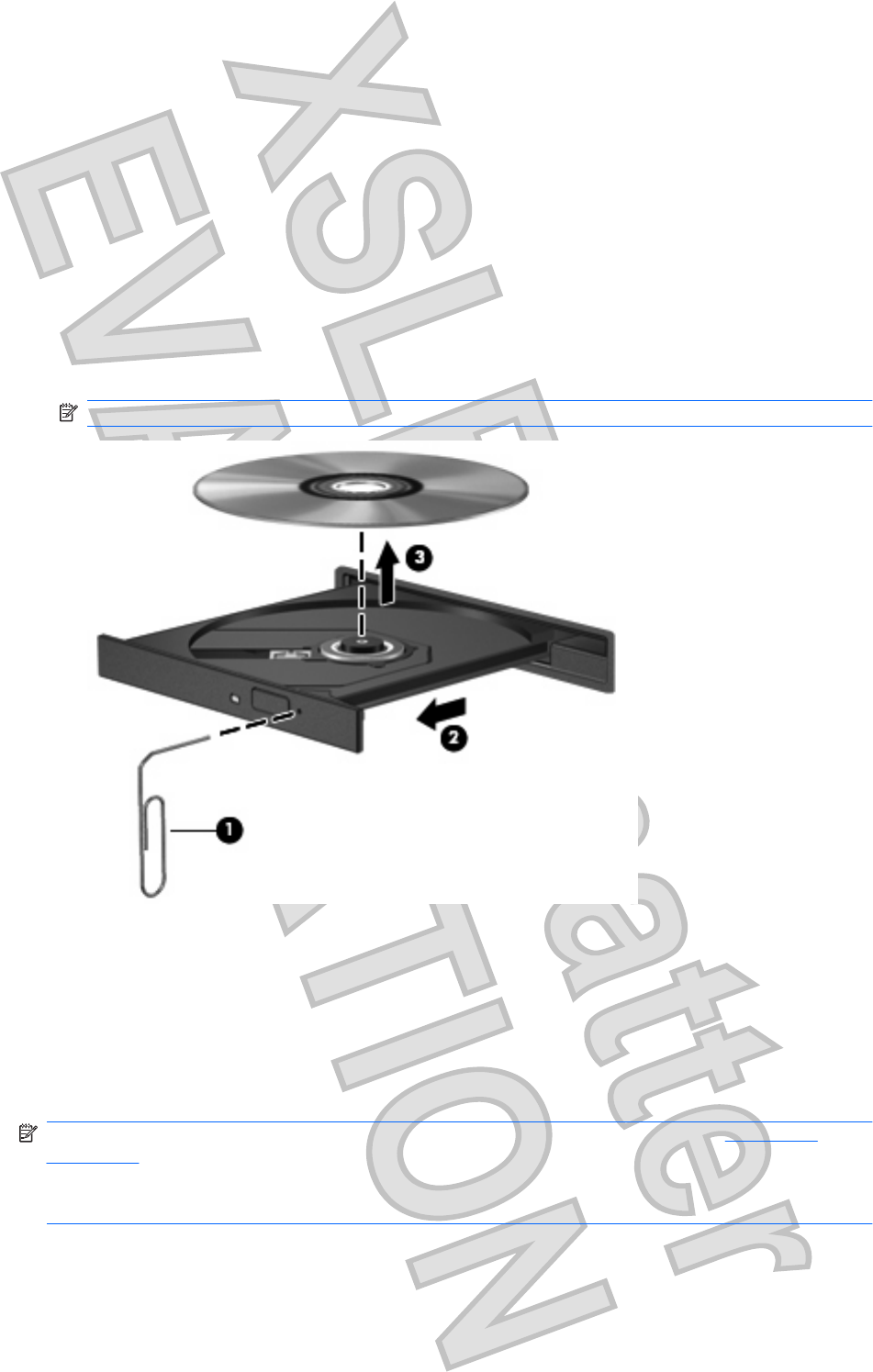
You may have one of the following types of drives:
łDVD±RW SuperMulti Double-Layer (DL) Drive
łBlu-ray ROM DVD±R/RW SuperMulti Double-Layer (DL) Drive
Removing an optical disc when the disc tray will not open
If your optical drive is a tray load drive and the disc tray does not open, follow these steps:
1. Insert the end of a paper clip (1) into the release access in the front bezel of the drive.
2. Press in gently on the paper clip until the tray is released, and then pull out the tray (2) until it stops.
3. Remove the disc (3) from the tray by gently pressing down on the spindle while lifting the outer
edges of the disc. Hold the disc by the edges and avoid touching the flat surfaces.
NOTE: If the tray is not fully accessible, tilt the disc carefully as you remove it.
4. Close the disc tray and place the disc in a protective case.
Sharing an optical drive
Although your computer does not have an integrated optical drive, you can easily access software, install
applications, and access data by sharing an optical drive connected to another computer in your network.
Sharing drives is a feature of the Windows operating system that allows a drive on one computer to be
accessible to other computers on the same network.
NOTE: You must have a network set up in order to share an optical drive; refer to Networking
on page 15 for additional information on setting up a network.
NOTE: Some discs, such as DVD movies and game discs, may be copy-protected and therefore
unusable through DVD or CD sharing.
Sharing an optical drive 61
Antenna House XSL Formatter (Evaluation) http://www.antennahouse.com/

To share an optical drive:
1. From the computer with the optical drive you are sharing, select Start > Computer.
2. Right-click the optical drive you want to share, and click Properties.
3. Select the Sharing tab > Advanced Sharing.
4. Select the Share this folder check box.
5. Type a name for the optical drive in the Share name text box.
6. Click Apply, and then click OK.
7. To view the shared optical drive on your computer, select Start > Control Panel > Network and
Internet > Network and Sharing Center.
62 Chapter 10 Drives
Antenna House XSL Formatter (Evaluation) http://www.antennahouse.com/
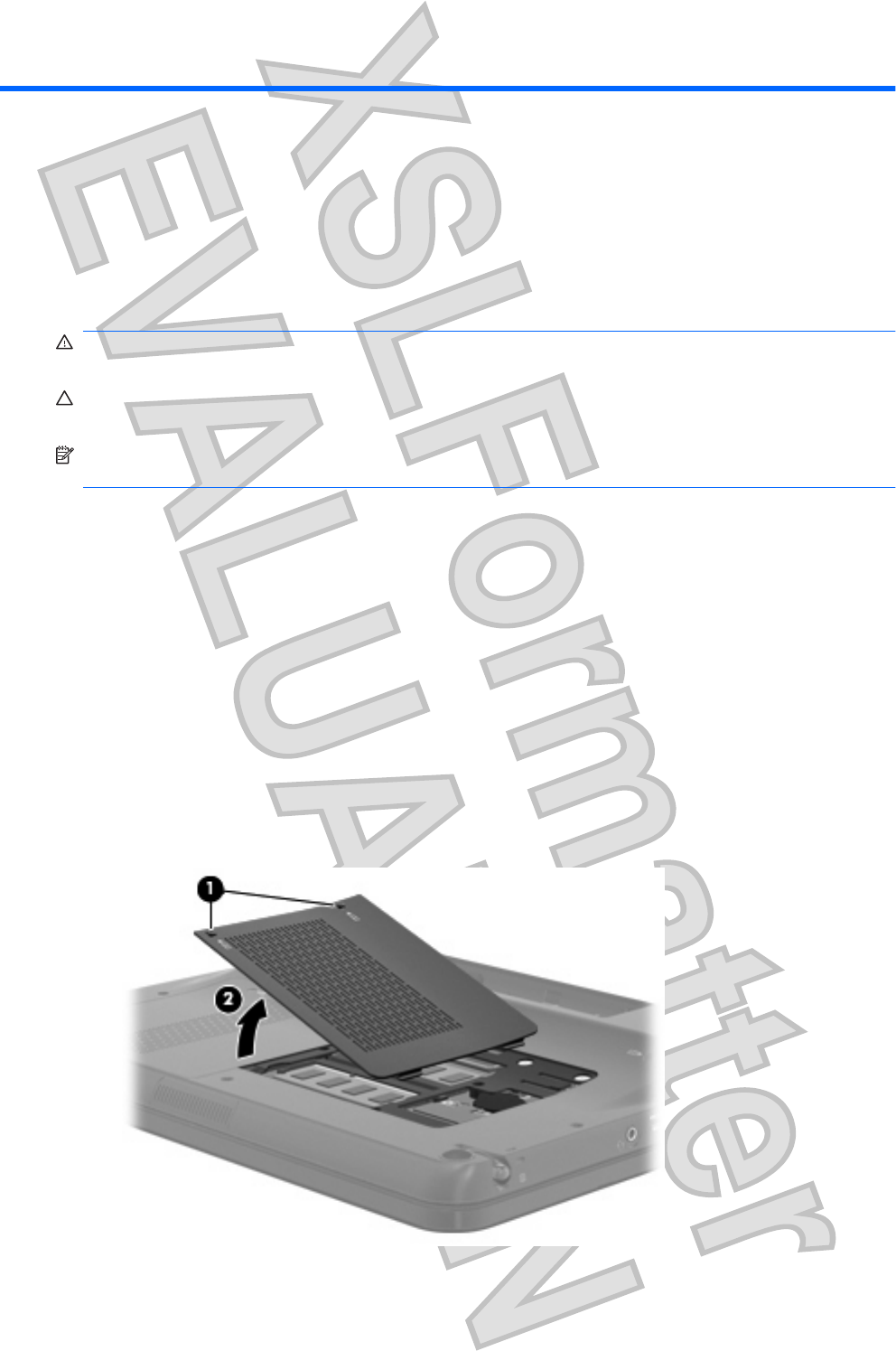
11 Memory modules
The computer has two memory module compartments, which are located on the bottom of the computer.
The memory capacity of the computer can be upgraded by adding a memory module to the vacant
expansion memory module slot or by upgrading the existing memory module in the primary memory
module slot.
WARNING! To reduce the risk of electric shock and damage to the equipment, unplug the power cord
and remove all batteries before installing a memory module.
CAUTION: Electrostatic discharge (ESD) can damage electronic components. Before beginning any
procedure, ensure that you are discharged of static electricity by touching a grounded metal object.
NOTE: To use a dual-channel configuration when adding a second memory module, be sure that both
memory modules are the same size.
To add or replace a memory module:
1. Save your work.
2. Shut down the computer and close the display.
If you are not sure whether the computer is off or in Hibernation, turn the computer on by sliding
the power switch. Then shut down the computer through the operating system.
3. Disconnect all external devices connected to the computer.
4. Unplug the power cord from the AC outlet.
5. Turn the computer upside down on a flat surface.
6. Remove the battery from the computer.
7. Loosen the 2 memory module compartment screws (1).
8. Lift the memory module compartment cover (2) away from the computer.
63
Antenna House XSL Formatter (Evaluation) http://www.antennahouse.com/
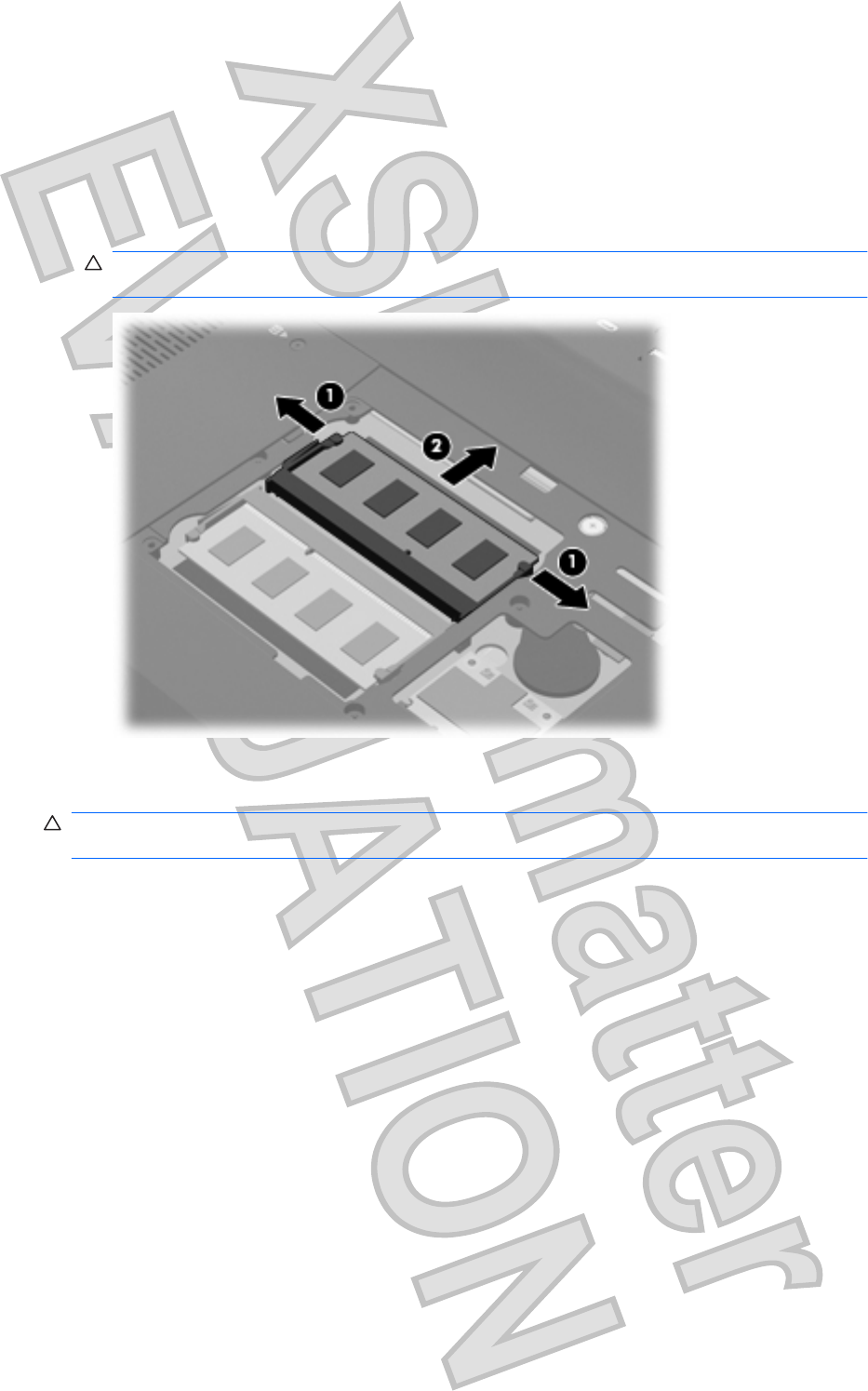
9. If you are replacing a memory module, remove the existing memory module:
a. Pull away the retention clips (1) on each side of the memory module.
The memory module tilts up.
b. Grasp the edge of the memory module (2), and gently pull the module out of the memory
module slot.
CAUTION: To prevent damage to the memory module, hold the memory module by the
edges only. Do not touch the components on the memory module.
To protect a memory module after removal, place it in an electrostatic-safe container.
10. Insert a new memory module:
CAUTION: To prevent damage to the memory module, hold the memory module by the edges
only. Do not touch the components on the memory module, and do not bend the memory module.
a. Align the notched edge (1) of the memory module with the tab in the memory module slot.
b. With the memory module at a 45-degree angle from the surface of the memory module
compartment, press the module (2) into the memory module slot until it is seated.
64 Chapter 11 Memory modules
Antenna House XSL Formatter (Evaluation) http://www.antennahouse.com/
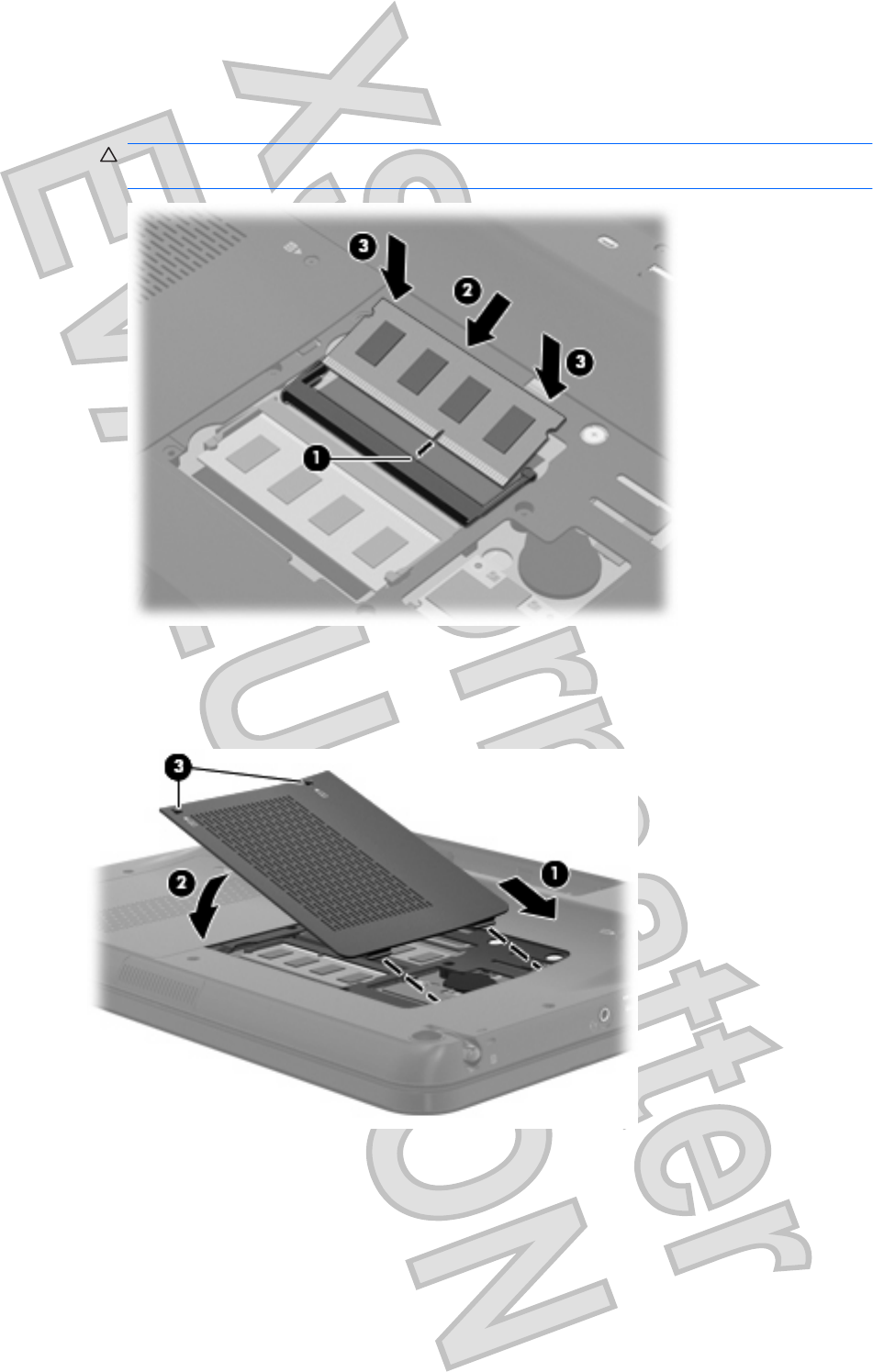
c. Gently press the memory module (3) down, applying pressure to both the left and right edges
of the memory module, until the retention clips snap into place.
CAUTION: To prevent damage to the memory module, be sure that you do not bend the
memory module.
11. Align the tabs (1) on the memory module compartment cover with the notches on the computer.
12. Close the cover (2).
13. Tighten the 2 memory module compartment screws (3).
14. Replace the battery.
15. Turn the computer right-side up, and then reconnect external power and external devices.
16. Turn on the computer.
65
Antenna House XSL Formatter (Evaluation) http://www.antennahouse.com/
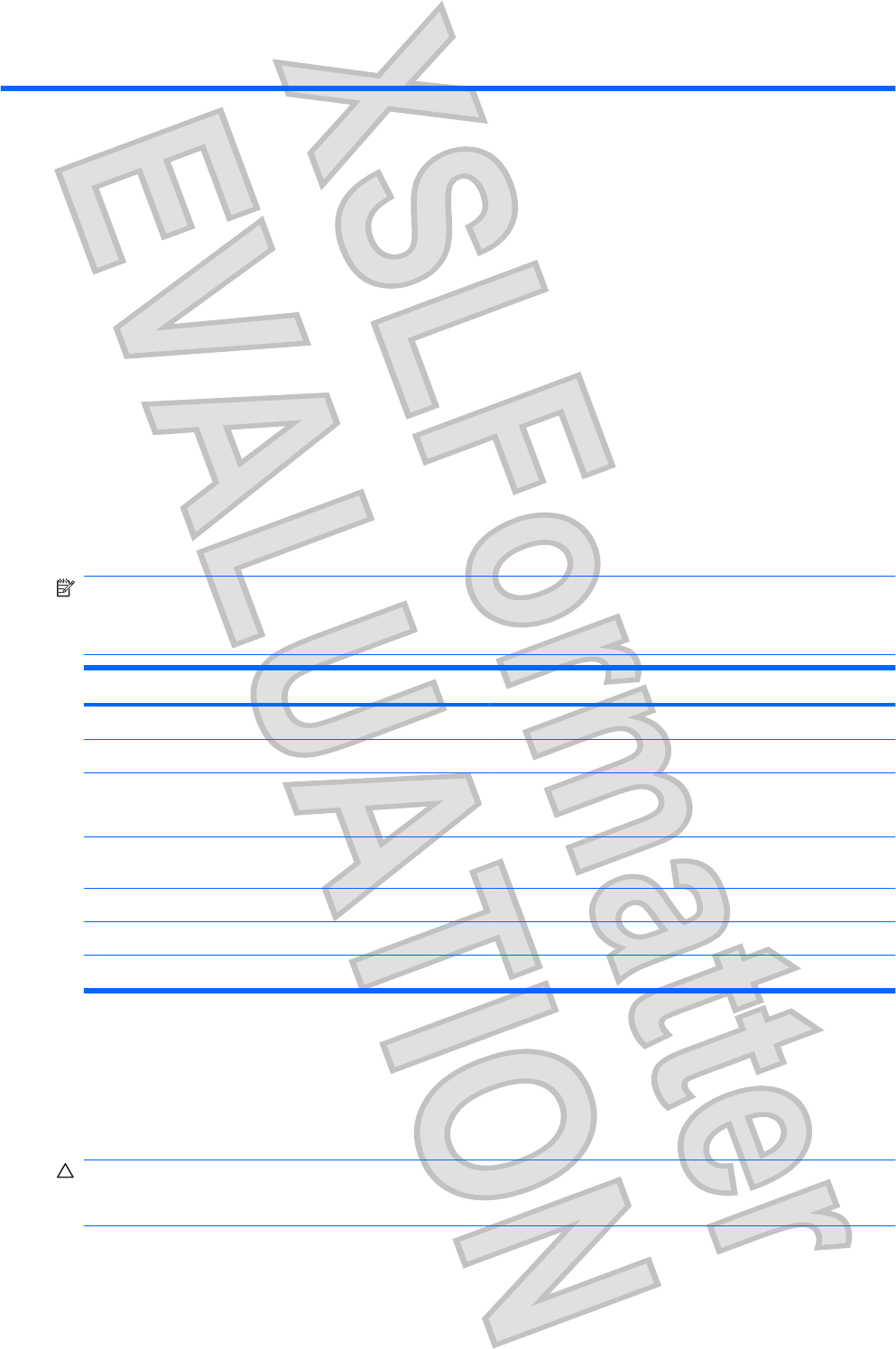
12 Security
Protecting the computer
Standard security features provided by the Windows® operating system and the non-Windows Setup
Utility can protect your personal settings and data from a variety of risks.
Follow the procedures in this guide to use the following features:
łPasswords
łAntivirus software
łFirewall software
łCritical security updates
łOptional security cable
łFingerprint reader
NOTE: Security solutions are designed to act as deterrents, but they may not deter software attacks
or prevent the computer from being mishandled or stolen.
NOTE: Before you send your computer for service, remove all password and fingerprint settings.
Computer risk Security feature
Unauthorized use of the computer Power-on password or fingerprint reader
Computer viruses Norton Internet Security software
Unauthorized access to data łFirewall software
łWindows updates
Unauthorized access to Setup Utility, BIOS settings, and other
system identification information
Administrator password
Ongoing or future threats to the computer Critical security updates from Microsoft
Unauthorized access to a Windows user account User password
Unauthorized removal of the computer Security cable slot (used with an optional security cable)
Using passwords
A password is a group of characters that you choose to secure your computer information. Several types
of passwords can be set, depending on how you want to control access to your information. Passwords
can be set in Windows or in the non-Windows Setup Utility preinstalled on the computer.
CAUTION: To prevent being locked out of the computer, record each password you set. Because
most passwords are not displayed as they are set, changed, or deleted, it is essential to record each
password immediately and store it in a secure place.
66 Chapter 12 Security
Antenna House XSL Formatter (Evaluation) http://www.antennahouse.com/

You can use the same password for a Setup Utility feature and for a Windows security feature. You can
also use the same password for more than one Setup Utility feature.
Use the following guidelines when setting a password in Setup Utility:
łA password can be any combination of up to 8 letters and numbers and is case sensitive.
łA password set in Setup Utility must be entered at a Setup Utility prompt. A password set
in Windows must be entered at a Windows prompt.
Use the following tips for creating and saving passwords:
łWhen creating passwords, follow requirements set by the program.
łWrite down your passwords and store them in a secure place away from the computer.
łDo not store passwords in a file on the computer.
łDo not use your name or other personal information that could be easily discovered by an outsider.
The following sections list Windows and Setup Utility passwords and describe their functions. For
additional information about Windows passwords, such as screen-saver passwords, select Start > Help
and Support.
Setting passwords in Windows
Password
Administrator password Protects administrator-level access to computer contents.
NOTE: This password cannot be used to access Setup Utility
contents.
User password Protects access to a Windows user account. It also protects
access to the computer contents and must be entered when
you exit Sleep or Hibernation.
Setting passwords in Setup Utility
Password
Administrator password* łProtects access to Setup Utility.
łAfter this password is set, it must be entered each time
you access Setup Utility.
CAUTION: If you forget your administrator password, you
cannot access Setup Utility.
Power-on password* łProtects access to the computer contents.
łAfter this password is set, it must be entered each time
you turn on or restart the computer, or exit Hibernation.
CAUTION: If you forget your power-on password, you
cannot turn on or restart the computer, or exit Hibernation.
NOTE: The administrator password can be used in place of
the power-on password.
*For details about each of these passwords, refer to the following topics.
Using passwords 67
Antenna House XSL Formatter (Evaluation) http://www.antennahouse.com/

Administrator password
Your administrator password protects the configuration settings and system identification information in
Setup Utility. After this password is set, you must enter it each time you access Setup Utility.
Your administrator password is not interchangeable with an administrator password set in Windows,
nor is it displayed as it is set, entered, changed, or deleted. Be sure that you record your password and
store it in a safe place.
If you enter the administrator password at the first password check before the “Press the ESC key for
Startup Menu” message is displayed, you do not have to enter it again to access Setup Utility.
If you enter the power-on password at the first password check before the “Press the ESC key for Startup
Menu” message is displayed, you must enter the administrator password to access Setup Utility.
Managing an administrator password
To set, change, or delete this password, follow these steps:
1. Open Setup Utility by turning on or restarting the computer. While the “Press the ESC key for
Startup Menu” message is displayed in the lower-left corner of the screen, press f10.
– or –
Open Setup Utility by turning on or restarting the computer. While the “Press the ESC key for
Startup Menu” message is displayed in the lower-left corner of the screen, press esc. When the
Startup Menu is displayed, press f10.
2. Use the arrow keys to select Security > Set Administrator Password, and then press enter.
łTo set an administrator password, type your password in the Enter New Password and
Confirm New Password fields, and then press enter.
łTo change an administrator password, type your current password in the Enter Current
Password field, type a new password in the Enter New Password and Confirm New
Password fields, and then press enter.
łTo delete an administrator password, type your current password in the Enter Password field,
and then press enter 4 times.
3. To save your changes and exit Setup Utility, use the arrow keys to select Exit > Exit Saving
Changes.
Your changes go into effect when the computer restarts.
Entering an administrator password
At the Enter Password prompt, type your administrator password, and then press enter. After 3
unsuccessful attempts to enter the administrator password, you must restart the computer and try again.
Power-on password
Your power-on password prevents unauthorized use of the computer. After this password is set, it must
be entered each time you turn on or restart the computer, or exit Hibernation. A power-on password is
not displayed as it is set, entered, changed, or deleted.
68 Chapter 12 Security
Antenna House XSL Formatter (Evaluation) http://www.antennahouse.com/

Managing a power-on password
To set, change, or delete this password, follow these steps:
1. Open Setup Utility by turning on or restarting the computer. While the “Press the ESC key for
Startup Menu” message is displayed in the lower-left corner of the screen, press f10.
– or –
Open Setup Utility by turning on or restarting the computer. While the “Press the ESC key for
Startup Menu” message is displayed in the lower-left corner of the screen, press esc. When the
Startup Menu is displayed, press f10.
2. Use the arrow keys to select Security > Set Power-On Password, and then press enter.
łTo set a power-on password, type your password in the Enter New Password and Confirm
New Password fields, and then press enter.
łTo change a power-on password, type your current password in the Enter Current
Password field, type a new password in the Enter New Password and Confirm New
Password fields, and then press enter.
łTo delete a power-on password, type your current password in the Enter Current
Password field, and then press enter 4 times.
3. To save your changes and exit Setup Utility, use the arrow keys to select Exit > Exit Saving
Changes.
Your changes go into effect when the computer restarts.
Entering a power-on password
At the Enter Password prompt, type your password, and then press enter. After 3 unsuccessful attempts
to enter the password, you must restart the computer and try again.
Using antivirus software
When you use the computer to access e-mail, a network, or the Internet, you expose it to computer
viruses. Computer viruses can disable the operating system, programs, or utilities, or cause them to
abnormally.
Antivirus software can detect most viruses, destroy them, and in most cases, repair any damage they
have caused. To provide ongoing protection against newly discovered viruses, antivirus software must
be kept up to date.
Norton Internet Security, an antivirus program, is preinstalled on the computer. The software includes
60 days of free updates. It is strongly recommended that you protect the computer against new viruses
beyond 60 days by purchasing extended update service. Instructions for using and updating Norton
Internet Security software and for purchasing extended update service are provided within the program.
To view and access Norton Internet Security, select Start > All Programs > Norton Internet
Security.
For more information about computer viruses, type viruses in the Search box in Help and Support.
Using firewall software
When you use the computer for e-mail, network, or Internet access, unauthorized persons may be able
to gain access to the computer, your personal files, and information about you. Use the firewall software
preinstalled on the computer to protect your privacy.
Using antivirus software 69
Antenna House XSL Formatter (Evaluation) http://www.antennahouse.com/
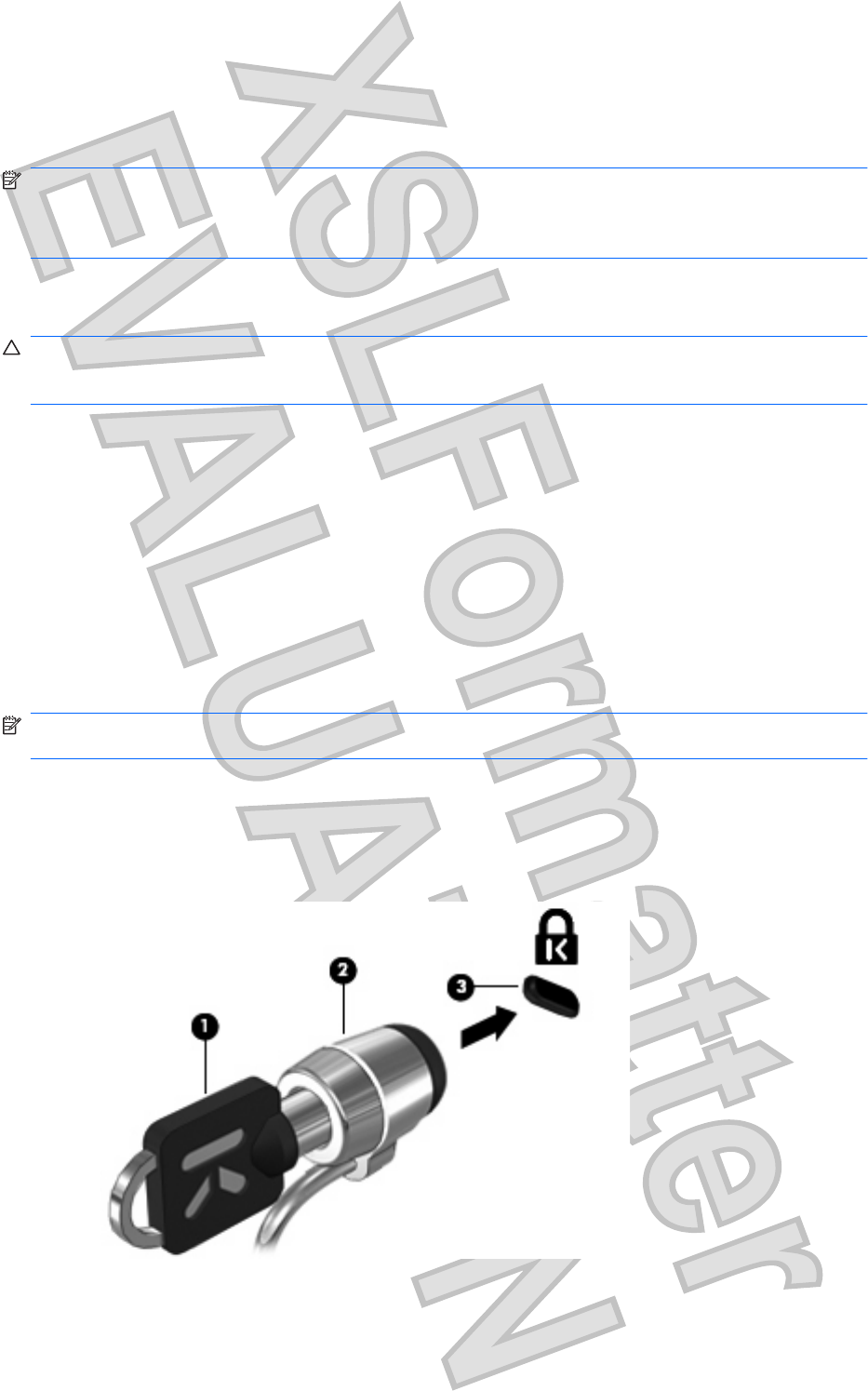
Firewall features include logging and reporting of network activity, and automatic monitoring of all
incoming and outgoing traffic. Refer to the firewall user guide or contact your firewall manufacturer for
more information.
NOTE: Under some circumstances a firewall can block access to Internet games, interfere with printer
or file sharing on a network, or block authorized e-mail attachments. To temporarily resolve the problem,
disable the firewall, perform the task that you want to perform, and then reenable the firewall. To
permanently resolve the problem, reconfigure the firewall.
Installing critical security updates
CAUTION: Microsoft sends alerts regarding critical updates. To protect the computer from security
breaches and computer viruses, install all critical updates from Microsoft as soon as you receive an
alert.
Updates to the operating system and other software may have become available after the computer
was shipped. To be sure that all available updates are installed on the computer, observe these
guidelines:
łRun Windows Update as soon as possible after you set up your computer. Use the update link at
Start > All Programs > Windows Update.
łRun Windows Update monthly thereafter.
łObtain updates to Windows and other Microsoft® programs, as they are released, from the
Microsoft Web site and through the updates link in Help and Support.
Installing an optional security cable
NOTE: A security cable is designed to act as a deterrent, but it may not prevent the computer from
being mishandled or stolen.
1. Loop the security cable around a secured object.
2. Insert the key (1) into the cable lock (2).
3. Insert the cable lock into the security cable slot on the computer (3), and then lock the cable lock
with the key.
4. Remove the key and keep it in a safe place.
70 Chapter 12 Security
Antenna House XSL Formatter (Evaluation) http://www.antennahouse.com/

Using your registered fingerprint to log on to Windows
To log on to Windows using your fingerprint, follow these steps:
1. Immediately after you have registered your fingerprints, restart Windows.
2. Swipe any of your registered fingers to log on to Windows.
72 Chapter 12 Security
Antenna House XSL Formatter (Evaluation) http://www.antennahouse.com/

13 Backup and recovery
Recovery after a system failure is as complete as your most current backup. HP recommends that you
create recovery discs immediately after software setup. As you add new software and data files, you
should continue to back up your system on a regular basis to maintain a reasonably current backup.
Tools provided by the operating system and HP Recovery Manager software are designed to help you
with the following tasks for safeguarding your information and restoring it in case of a system failure:
łCreating a set of recovery discs (Recovery Manager software feature). Recovery discs are used
to start up (boot) your computer and restore the operating system and software programs to factory
settings in case of system failure or instability.
łBacking up your information regularly to protect your important system files.
łCreating system restore points (operating system feature). System restore points allow you to
reverse undesirable changes to your computer by restoring the computer to an earlier state.
łRecovering a program or driver (Recovery Manager software feature). This feature helps you
reinstall a program or driver without performing a full system recovery.
łPerforming a full system recovery (Recovery Manager software feature). With Recovery Manager,
you can recover your full factory image if you experience system failure or instability. Recovery
Manager works from a dedicated recovery partition (select models only) on the hard drive or from
recovery discs you create.
NOTE: Computers with a solid-state drive (SSD) may not have a recovery partition. Recovery
discs have been included for computers that do not have a partition. Use these discs to recover
your operating system and software. To check for the presence of a recovery partition, select
Start, right-click Computer, click Manage, and then click Disk Management. If the partition is
present, an HP Recovery drive is listed in the window.
Creating recovery discs
HP recommends that you create recovery discs to be sure that you can restore your system to its original
factory state if you experience serious system failure or instability. Create these discs after setting up
the computer for the first time.
Handle these discs carefully and keep them in a safe place. The software allows the creation of only
one set of recovery discs.
NOTE: If your computer does not include an integrated optical drive, you can use an optional external
optical drive (purchased separately) to create recovery discs, or you can purchase recovery discs for
your computer from the HP Web site.
Note the following guidelines before creating recovery discs:
łYou will need high-quality DVD-R, DVD+R, BD-R (writable Blu-ray), or CD-R discs. All these discs
are purchased separately. DVDs and BDs have a much higher capacity than CDs. If you use CDs,
up to 20 discs may be required, whereas only a few DVDs or BDs are required.
NOTE: Read-write discs, such as CD-RW, DVD±RW, double-layer DVD±RW, and BD-RE
(rewritable Blu-ray) discs, are not compatible with the Recovery Manager software.
łThe computer must be connected to AC power during this process.
Creating recovery discs 73
Antenna House XSL Formatter (Evaluation) http://www.antennahouse.com/
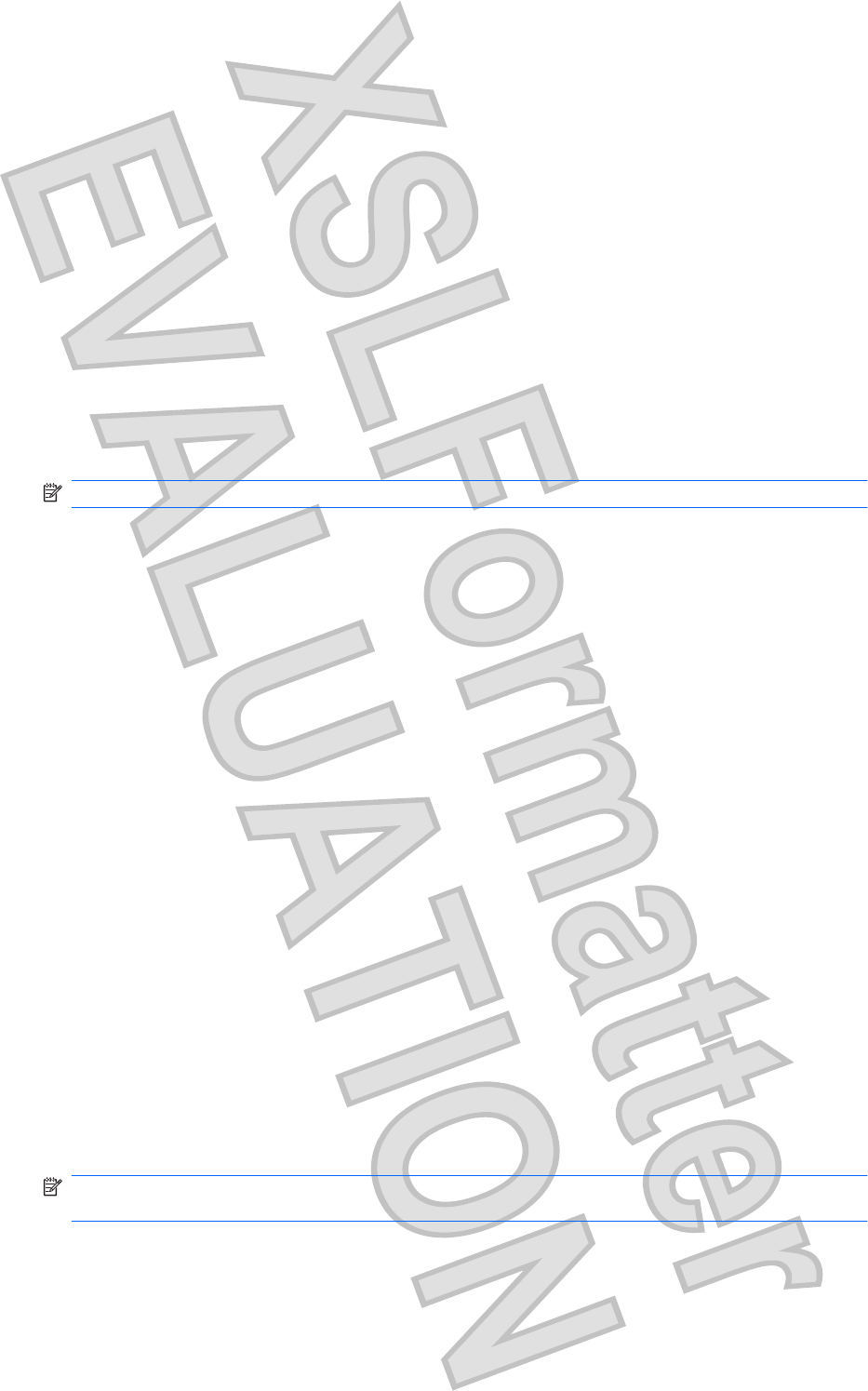
łOnly one set of recovery discs can be created per computer.
łNumber each disc before inserting it into the optical drive.
łIf necessary, you can exit the program before you have finished creating the recovery discs. The
next time you open Recovery Manager, you will be prompted to continue the disc creation process.
To create a set of recovery discs:
1. Select Start > All Programs > Recovery Manager > Recovery Disc Creation.
2. Follow the on-screen instructions.
Backing up your information
As you add new software and data files, you should back up your system on a regular basis to maintain
a reasonably current backup. Back up your system at the following times:
łAt regularly scheduled times
NOTE: Set reminders to back up your information periodically.
łBefore the computer is repaired or restored
łBefore you add or modify hardware or software
Note the following when backing up:
łCreate system restore points using the Windows® System Restore feature, and periodically copy
them to disc.
łStore personal files in the Documents library and back up this folder periodically.
łBack up templates stored in their associated programs.
łSave customized settings in a window, toolbar, or menu bar by taking a screen shot of your settings.
The screen shot can be a time-saver if you have to reset your preferences.
To copy the screen and paste it into a word-processing document, follow these steps:
1. Display the screen.
2. Copy the screen:
To copy only the active window, press alt+prt sc.
To copy the entire screen, press prt sc.
3. Open a word-processing document, and then select Edit > Paste.
4. Save the document.
łYou can back up your information to an optional external hard drive, a network drive, or discs.
łWhen backing up to discs, use any of the following types of discs (purchased separately): CD-R,
CD-RW, DVD+R, DVD-R, or DVD±RW. The discs you use will depend on the type of optical drive
installed in your computer.
NOTE: DVDs store more information than CDs, so using them for backup reduces the number
of recovery discs required.
łWhen backing up to discs, number each disc before inserting it into the optical drive of the computer.
74 Chapter 13 Backup and recovery
Antenna House XSL Formatter (Evaluation) http://www.antennahouse.com/
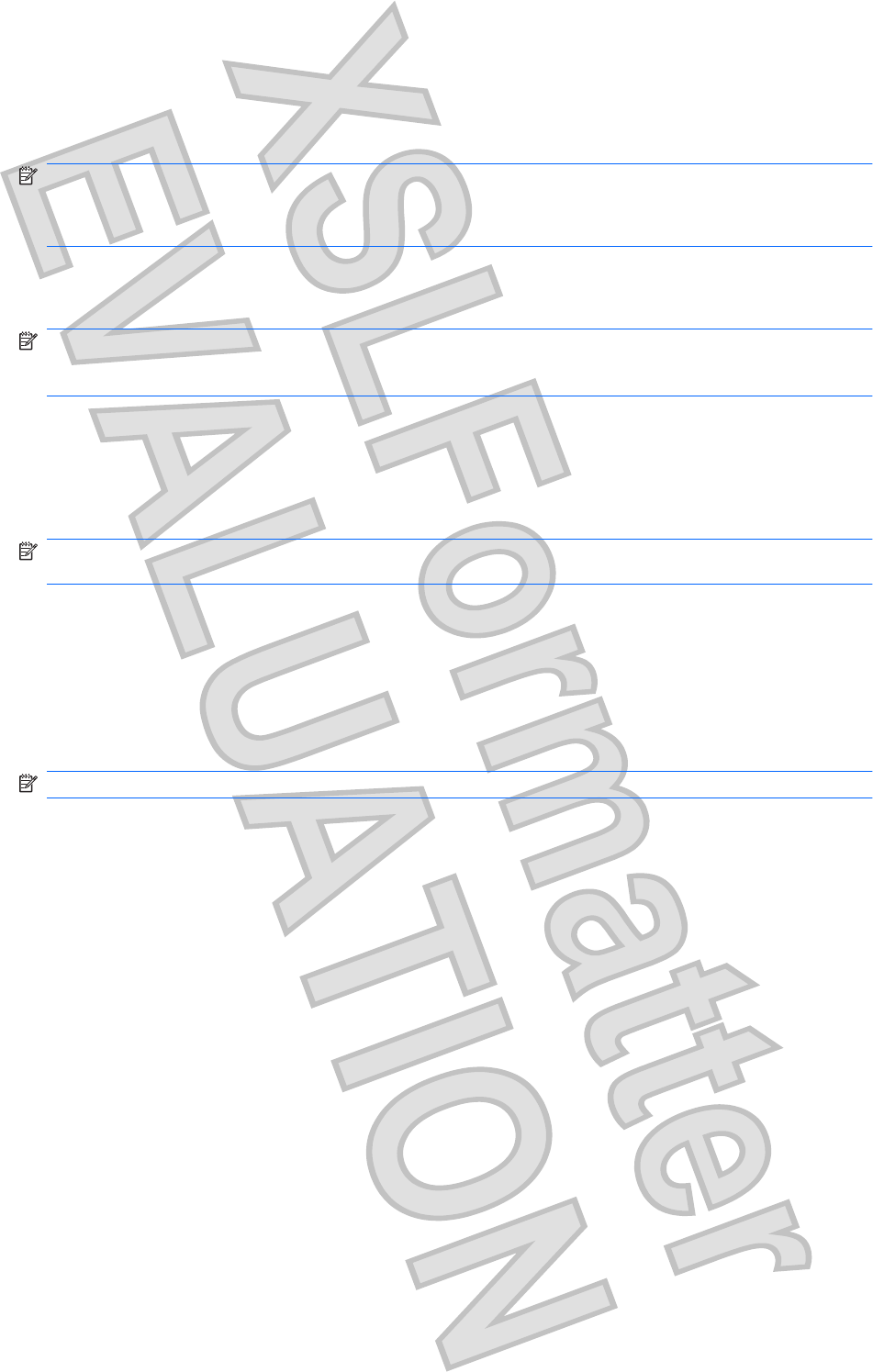
Using Windows Backup and Restore
To create a backup using Windows Backup and Restore, follow these steps:
NOTE: Be sure that the computer is connected to AC power before you start the backup process.
NOTE: The backup process may take over an hour, depending on file size and the speed of the
computer.
1. Select Start > All Programs > Maintenance > Backup and Restore.
2. Follow the on-screen instructions to set up and create a backup.
NOTE: Windows® includes the User Account Control feature to improve the security of your computer.
You may be prompted for your permission or password for tasks such as installing software, running
utilities, or changing Windows settings. Refer to Help and Support for more information.
Using system restore points
When you back up your system, you are creating a system restore point. A system restore point allows
you to save and name a snapshot of your hard drive at a specific point in time. You can then recover
back to that point if you want to reverse subsequent changes made to your system.
NOTE: Recovering to an earlier restore point does not affect data files saved or e-mails created since
the last restore point.
You also can create additional restore points to provide increased protection for your system files and
settings.
When to create restore points
łBefore you add or extensively modify software or hardware
łPeriodically, whenever the system is performing optimally
NOTE: If you revert to a restore point and then change your mind, you can reverse the restoration.
Create a system restore point
1. Select Start > Control Panel > System and Security > System.
2. In the left pane, click System Protection.
3. Click the System Protection tab.
4. Under Protection Settings, select the disk for which you want to create a restore point.
5. Click Create.
6. Follow the on-screen instructions.
Restore to a previous date and time
To revert to a restore point (created at a previous date and time), when the computer was functioning
optimally, follow these steps:
1. Select Start > Control Panel > System and Security > System.
2. In the left pane, click System protection.
3. Click the System Protection tab.
Backing up your information 75
Antenna House XSL Formatter (Evaluation) http://www.antennahouse.com/

4. Click System Restore.
5. Follow the on-screen instructions.
Performing a recovery
NOTE: You can recover only files that you have previously backed up. HP recommends that you use
HP Recovery Manager to create a set of recovery discs (entire drive backup) as soon as you set up
your computer.
Recovery Manager software allows you to repair or restore the system if you experience system failure
or instability. Recovery Manager works from recovery discs or from a dedicated recovery partition (select
models only) on the hard drive. However, if your computer includes a solid-state drive (SSD), you may
not have a recovery partition. If that is the case, recovery discs have been included with your computer.
Use these discs to recover your operating system and software.
NOTE: Windows has its own built-in repair features, such as System Restore. If you have not already
tried these features, try them before using Recovery Manager.
NOTE: Recovery Manager recovers only software that was preinstalled at the factory. Software not
provided with this computer must be downloaded from the manufacturer's Web site or reinstalled from
the disc provided by the manufacturer.
Recovering from the recovery discs
To restore the system from the recovery discs:
1. Back up all personal files.
2. Insert the first recovery disc into an optional external optical drive and restart the computer.
3. Follow the on-screen instructions.
Recovering from the dedicated recovery partition (select models only)
NOTE: Computers with an SSD may not have a recovery partition. If the computer does not have a
recovery partition, you will not be able to recover using this procedure. Recovery discs have been
included for computers that do not have a partition. Use these discs to recover your operating system
and software.
On some models, you can perform a recovery from the partition on the hard drive, accessed by pressing
either the Start button or f11. This restores the computer to its factory condition.
To restore the system from the partition, follow these steps:
1. Access Recovery Manager in either of the following ways:
łSelect Start > All Programs > Recovery Manager > Recovery Manager.
– or –
łTurn on or restart the computer, and then press esc while the “Press the ESC key for Startup
Menu” message is displayed at the bottom of the screen. Then, press f11 while the “Press
<F11> for recovery” message is displayed on the screen.
2. Click System Recovery in the Recovery Manager window.
3. Follow the on-screen instructions.
76 Chapter 13 Backup and recovery
Antenna House XSL Formatter (Evaluation) http://www.antennahouse.com/

14 Setup Utility (BIOS)
Starting Setup Utility
Setup Utility is a ROM-based information and customization utility that can be used even when your
Windows® operating system is not working.
The utility reports information about the computer and provides settings for startup, security, and other
preferences.
To start Setup Utility:
Open Setup Utility by turning on or restarting the computer. While the “Press the ESC key for
Startup Menu” message is displayed in the lower-left corner of the screen, press f10.
– or –
1. Open Setup Utility by turning on or restarting the computer. While the “Press the ESC key for
Startup Menu” message is displayed in the lower-left corner of the screen, press esc.
2. When the Startup Menu is displayed, press f10.
Using Setup Utility
Changing the language of Setup Utility
The following procedure explains how to change the language of Setup Utility. If Setup Utility is not
already running, begin at step 1. If Setup Utility is already running, begin at step 2.
1. Open Setup Utility by turning on or restarting the computer. While the “Press the ESC key for
Startup Menu” message is displayed in the lower-left corner of the screen, press f10.
– or –
Open Setup Utility by turning on or restarting the computer. While the “Press the ESC key for
Startup Menu” message is displayed in the lower-left corner of the screen, press esc. When the
Startup Menu is displayed, press f10.
2. Use the arrow keys to select System Configuration > Language, and then press enter.
3. Use the arrow keys to select a language, and then press enter.
4. When a confirmation prompt with your language selected is displayed, press enter.
5. To save your change and exit Setup Utility, use the arrow keys to select Exit > Exit Saving
Changes, and then press enter.
Your change goes into effect immediately.
Starting Setup Utility 77
Antenna House XSL Formatter (Evaluation) http://www.antennahouse.com/
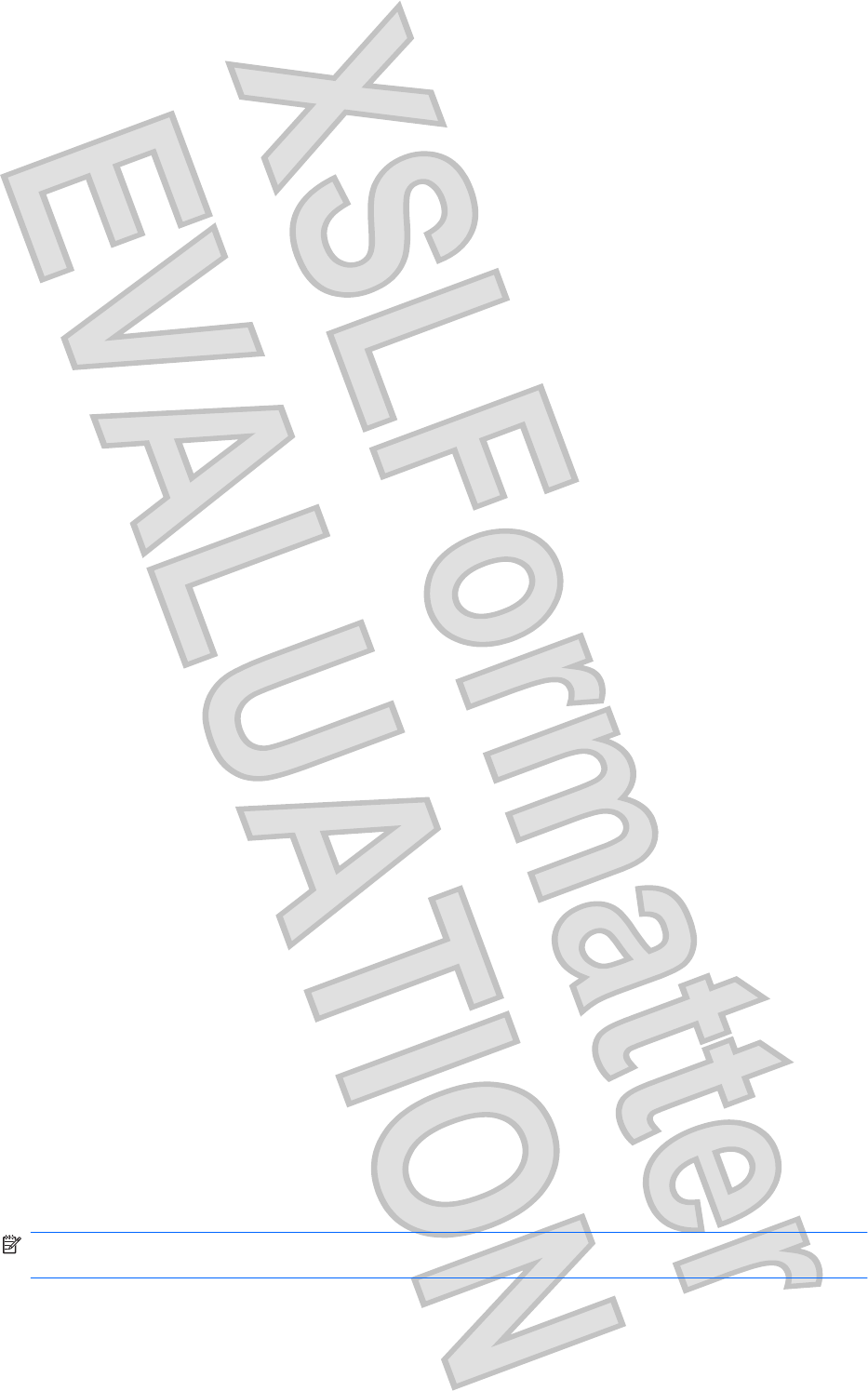
Navigating and selecting in Setup Utility
Because Setup Utility is not Windows based, it does not support the TouchPad. Navigation and selection
are by keystroke.
łTo choose a menu or a menu item, use the arrow keys.
łTo choose an item in a list or to toggle a field, for example an Enable/Disable field, use either the
arrow keys or f5 or f6.
łTo select an item, press enter.
łTo close a text box or return to the menu display, press esc.
łTo display additional navigation and selection information while Setup Utility is open, press f1.
Displaying system information
The following procedure explains how to display system information in Setup Utility. If Setup Utility is
not open, begin at step 1. If Setup Utility is open, begin at step 2.
1. Open Setup Utility by turning on or restarting the computer. While the “Press the ESC key for
Startup Menu” message is displayed in the lower-left corner of the screen, press f10.
– or –
Open Setup Utility by turning on or restarting the computer. While the “Press the ESC key for
Startup Menu” message is displayed in the lower-left corner of the screen, press esc. When the
Startup Menu is displayed, press f10.
2. Select the Main menu. System information such as the system time and date, and identification
information about the computer is displayed.
3. To exit Setup Utility without changing any settings, use the arrow keys to select Exit > Exit
Discarding Changes, and then press enter.
Restoring default settings in Setup Utility
The following procedure explains how to restore the Setup Utility default settings. If Setup Utility is not
already running, begin at step 1. If Setup Utility is already running, begin at step 2.
1. Open Setup Utility by turning on or restarting the computer. While the “Press the ESC key for
Startup Menu” message is displayed in the lower-left corner of the screen, press f10.
– or –
Open Setup Utility by turning on or restarting the computer. While the “Press the ESC key for
Startup Menu” message is displayed in the lower-left corner of the screen, press esc. When the
Startup Menu is displayed, press f10.
2. Use the arrow keys to select Exit > Load Setup Defaults, and then press enter.
3. When the Setup Confirmation is displayed, press enter.
4. To save your change and exit Setup Utility, use the arrow keys to select Exit > Exit Saving
Changes, and then press enter.
The Setup Utility default settings go into effect when the computer restarts.
NOTE: Your password, security, and language settings are not changed when you restore the factory
default settings.
78 Chapter 14 Setup Utility (BIOS)
Antenna House XSL Formatter (Evaluation) http://www.antennahouse.com/
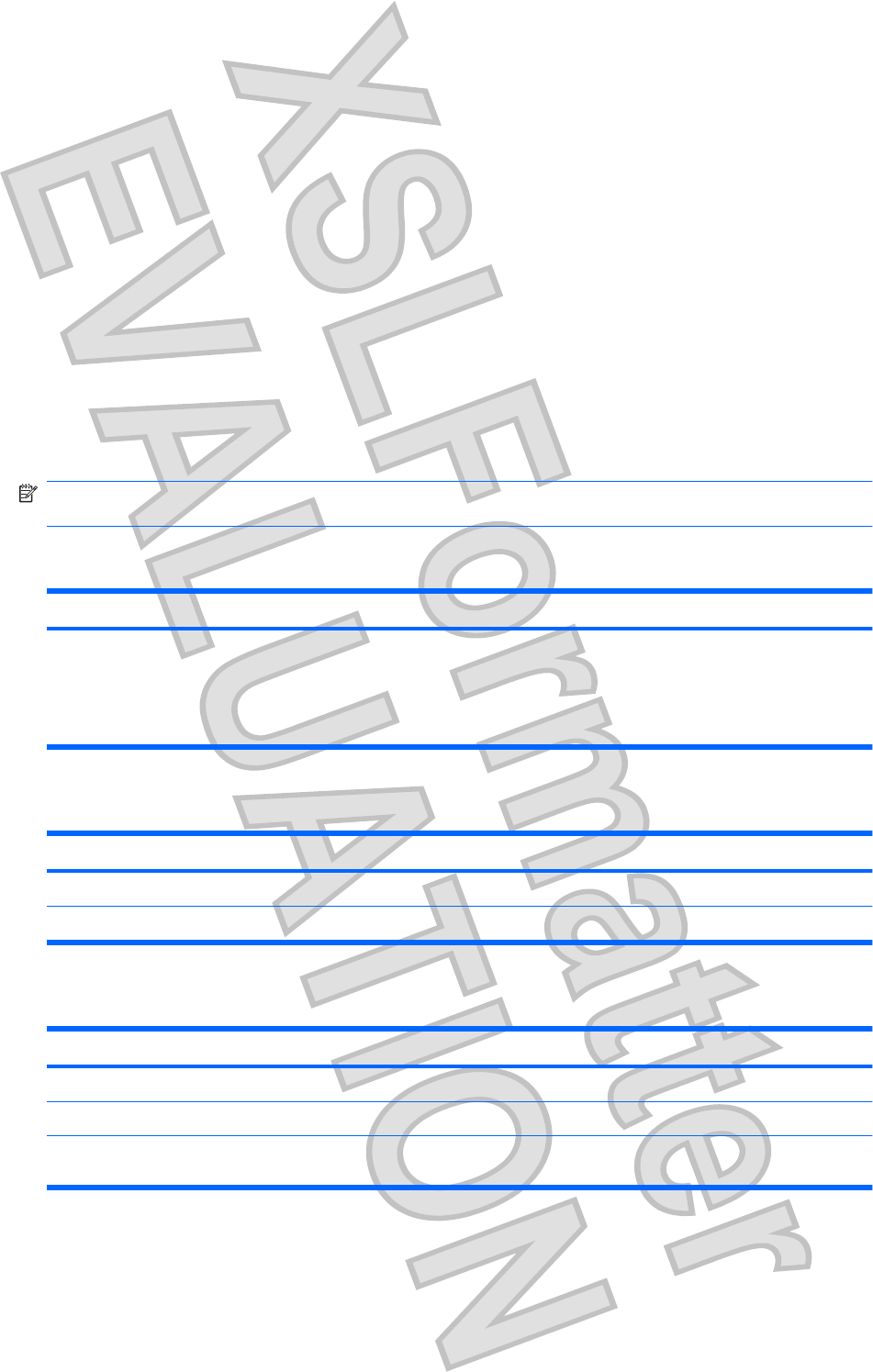
Exiting Setup Utility
You can exit Setup Utility with or without saving changes.
łTo exit Setup Utility and save your changes from the current session:
If the Setup Utility menus are not visible, press esc to return to the menu display. Then use the
arrow keys to select Exit > Exit Saving Changes, and then press enter.
łTo exit Setup Utility without saving your changes from the current session:
If the Setup Utility menus are not visible, press esc to return to the menu display. Then use the
arrow keys to select Exit > Exit Discarding Changes, and then press enter.
After either choice, the computer restarts in Windows.
Setup Utility Menus
The menu tables in this section provide an overview of Setup Utility options.
NOTE: Some of the Setup Utility menu items listed in this chapter may not be supported by your
computer.
Main menu
Select To do this
System information łView and change the system time and date.
łView identification information about the computer.
łView specification information, such as processor information,
memory size, and system BIOS.
Security menu
Select To do this
Administrator password Enter, change, or delete an administrator password.
Power-On Password Enter, change, or delete a power-on password.
System Configuration menu
Select To do this
Language Support Change the Setup Utility language.
Virtualization Technology (select models only) Enable/disable the processor Virtualization Technology.
Fan Always On Enabled/disable Fan Always On. When enabled, the computer fan will
always be on.
Setup Utility Menus 79
Antenna House XSL Formatter (Evaluation) http://www.antennahouse.com/
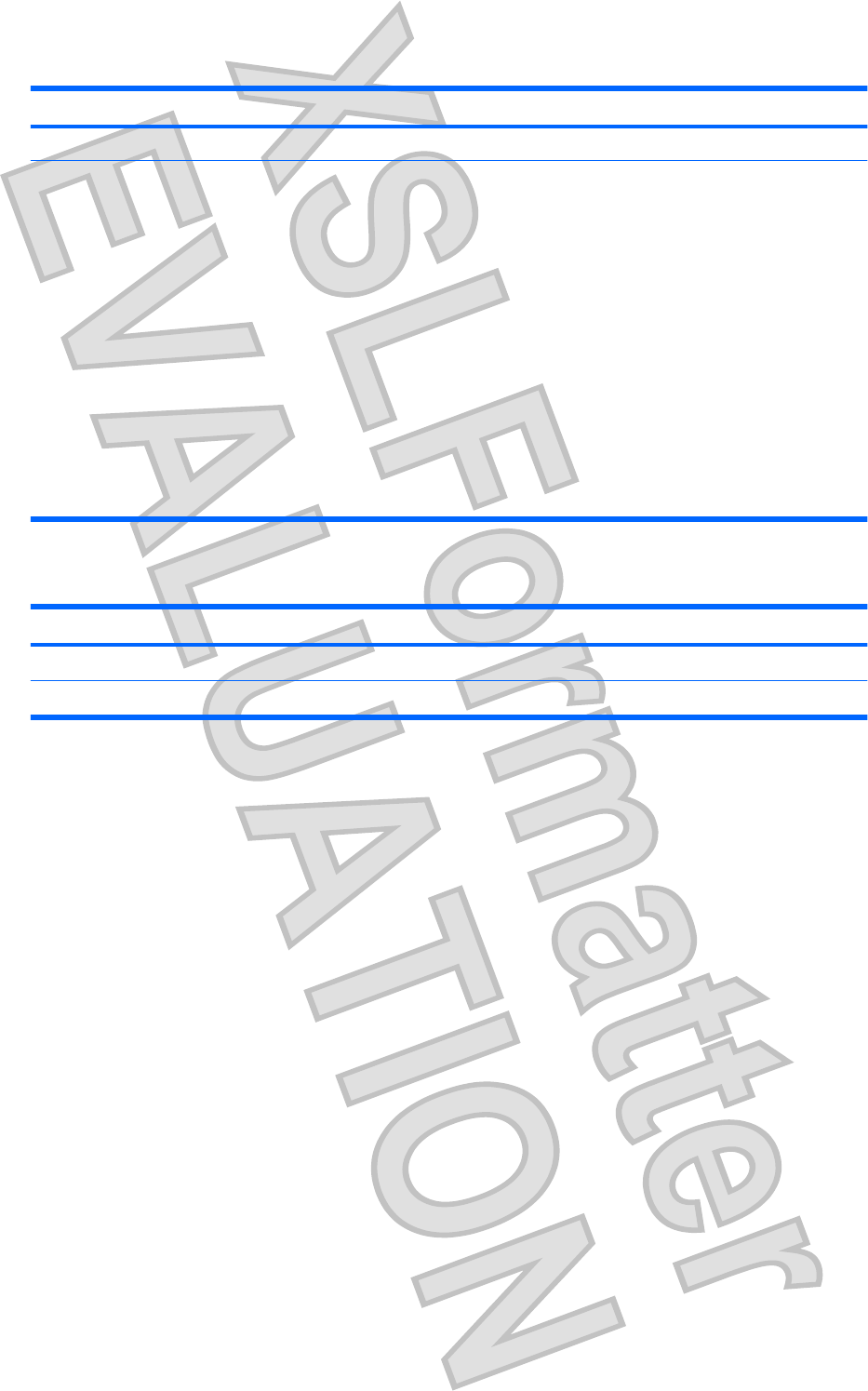
Select To do this
Action Keys Mode Enable/disable the Action Keys.
Boot Options Set the following boot options:
łPOST Hot Key Delay (sec.)ʊSet the delay for the user to press hot
keys in intervals of 5 seconds each (0, 5, 10, 15, 20).
łFloppy BootʊEnable/disable boot from diskette.
łNetwork Adapter BootʊEnable/disable boot from external Network
Adapter.
łBoot OrderʊSet the boot order for:
ŃNotebook Hard Drive
ŃUSB Diskette on Key/USB Hard Drive
ŃUSB CD/DVD ROM Drive
ŃUSB Floppy
ŃNetwork adapter
Diagnostics menu
Select To do this
Primary Hard Disk Self Test Run a comprehensive self-test on the hard drive.
Memory Test Run a diagnostic test on the system memory.
Updating the BIOS
Updated versions of the BIOS may be available on the HP Web site.
Most BIOS updates on the HP Web site are packaged in compressed files called SoftPaqs.
Some download packages contain a file named Readme.txt, which contains information regarding
installing and troubleshooting the file.
Updating the BIOS
Determining the BIOS version
To determine whether available BIOS updates contain later BIOS versions than those currently installed
on the computer, you need to know the version of the system BIOS currently installed.
BIOS version information (also known as ROM date and System BIOS) can be displayed by pressing
fn+esc (if you are already in Windows) or by opening Setup Utility.
80 Chapter 14 Setup Utility (BIOS)
Antenna House XSL Formatter (Evaluation) http://www.antennahouse.com/
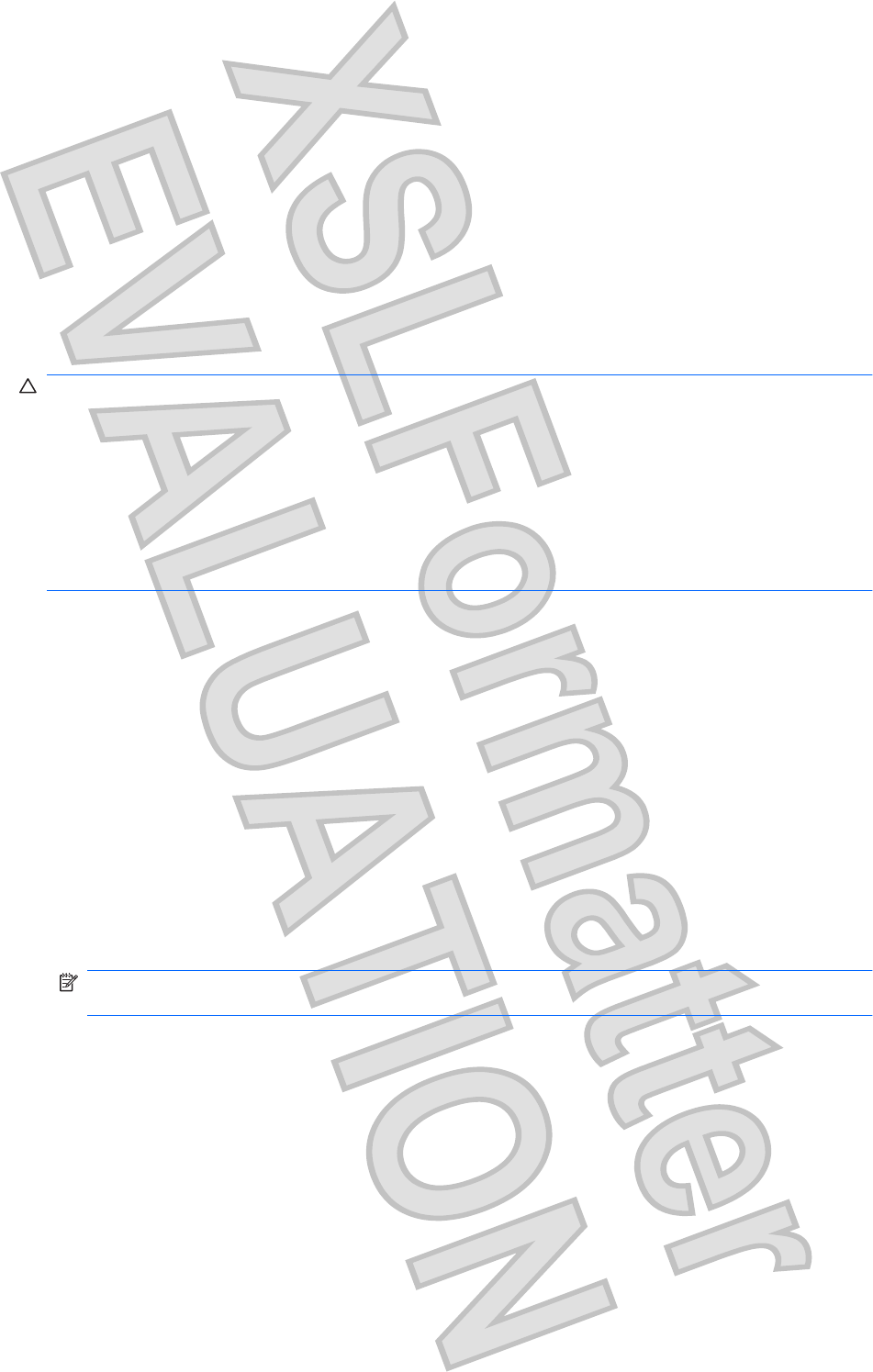
To use Setup Utility for displaying BIOS information:
1. Open Setup Utility by turning on or restarting the computer. While the “Press the ESC key for
Startup Menu” message is displayed in the lower-left corner of the screen, press f10.
2. If Setup Utility does not open with the system information displayed, use the arrow keys to select
the Main menu.
When the Main menu is selected, BIOS and other system information is displayed.
3. To exit Setup Utility, use the arrow keys to select Exit > Exit Discarding Changes, and then press
enter.
Downloading a BIOS update
CAUTION: To prevent damage to the computer or an unsuccessful installation, download and install
a BIOS update only when the computer is connected to reliable external power using the AC adapter.
Do not download or install a BIOS update while the computer is running on battery power, docked in an
optional docking device, or connected to an optional power source. During the download and installation,
follow these instructions:
Do not disconnect power from the computer by unplugging the power cord from the AC outlet.
Do not shut down the computer or initiate Sleep or Hibernation.
Do not insert, remove, connect, or disconnect any device, cable, or cord.
To download a BIOS update:
1. Access the page on the HP Web site that provides software for your computer:
Select Start > Help and Support > Maintain.
2. Follow the instructions on the screen to identify your computer and access the BIOS update you
want to download.
3. At the download area, follow these steps:
a. Identify the BIOS update that is later than the BIOS version currently installed on your
computer. Make a note of the date, name, or other identifier. You may need this information
to locate the update later, after it has been downloaded to your hard drive.
b. Follow the instructions on the screen to download your selection to the hard drive.
Make a note of the path to the location on your hard drive where the BIOS update will be
downloaded. You will need to access this path when you are ready to install the update.
NOTE: If you connect your computer to a network, consult the network administrator before
installing any software updates, especially system BIOS updates.
BIOS installation procedures vary. Follow any instructions that are displayed on the screen after the
download is complete. If no instructions are displayed, follow these steps:
1. Open Windows Explorer by selecting Start > Computer.
2. Double-click your hard drive designation. The hard drive designation is typically Local Disk (C:).
3. Using the hard drive path you recorded earlier, open the folder on your hard drive that contains the
update.
4. Double-click the file that has an .exe extension (for example, filename.exe).
Updating the BIOS 81
Antenna House XSL Formatter (Evaluation) http://www.antennahouse.com/
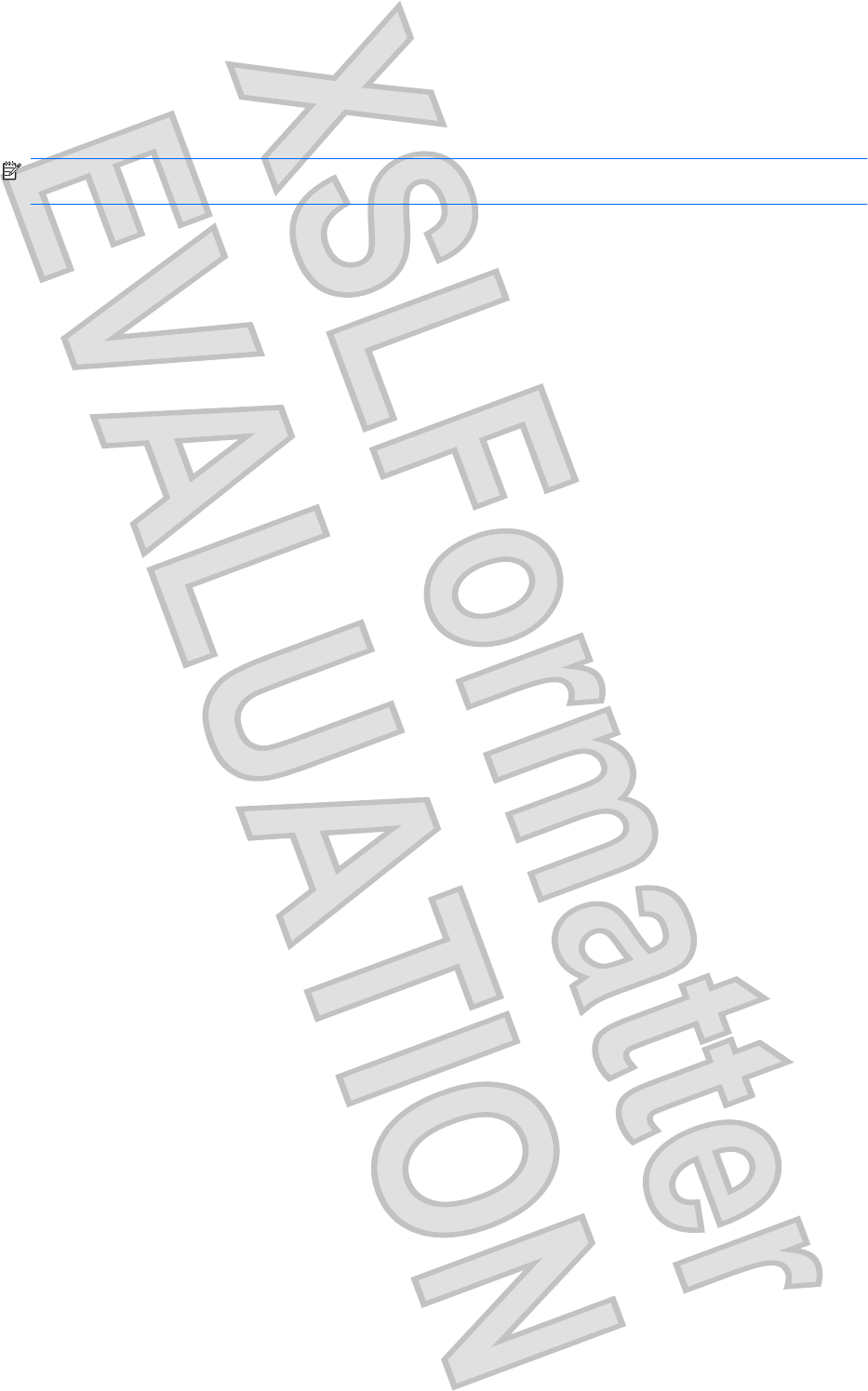
The BIOS installation begins.
5. Complete the installation by following the instructions on the screen.
NOTE: After a message on the screen reports a successful installation, you can delete the downloaded
file from your hard drive.
82 Chapter 14 Setup Utility (BIOS)
Antenna House XSL Formatter (Evaluation) http://www.antennahouse.com/

A Product information
Input power
The power information in this section may be helpful if you plan to travel internationally with the computer.
The computer operates on DC power, which can be supplied by an AC or a DC power source. Although
the computer can be powered from a standalone DC power source, it should be powered only with an
AC adapter or a DC power source supplied and approved by HP for use with this computer.
The computer can operate on DC power within the following specifications.
Input power Rating
Operating voltage 18.5 V dc @ 3.5 A - 65W
Operating current 3.5 A
NOTE: This product is designed for IT power systems in Norway with phase-to-phase voltage not
exceeding 240 V rms.
NOTE: The computer operating voltage and current can be found on the system regulatory label on
the bottom of the computer.
Operating environment
Factor Metric U.S.
Temperature
Operating (writing to optical disc) 5°C to 35°C 41°F to 95°F
Nonoperating -20°C to 60°C -4°F to 140°F
Relative humidity (noncondensing)
Operating 10% to 90% 10% to 90%
Nonoperating 5% to 95% 5% to 95%
Maximum altitude (unpressurized)
Operating -15 m to 3,048 m -50 ft to 10,000 ft
Nonoperating -15 m to 12,192 m -50 ft to 40,000 ft
Input power 83
Antenna House XSL Formatter (Evaluation) http://www.antennahouse.com/
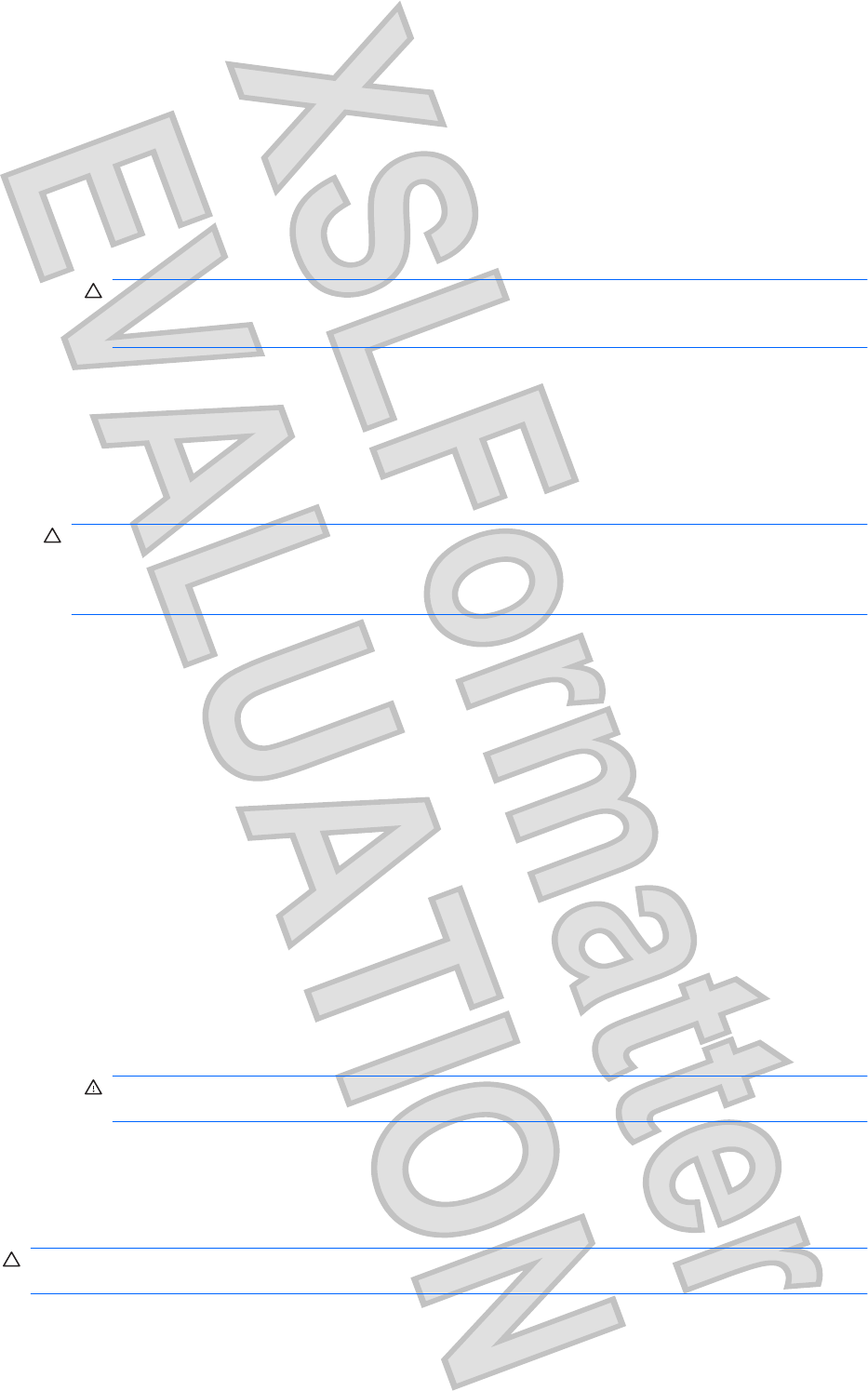
Traveling with the computer
For best results, follow these traveling and shipping tips:
łPrepare the computer for traveling or shipping:
ŃBack up your information.
ŃRemove all discs and all external media cards, such as digital cards.
CAUTION: To reduce the risk of damage to the computer, damage to a drive, or loss of
information, remove the media from a drive before removing the drive from a drive bay, and
before shipping, storing, or traveling with a drive.
ŃTurn off and then disconnect all external devices.
ŃShut down the computer.
łTake along a backup of your information. Keep the backup separate from the computer.
łWhen traveling by air, carry the computer as hand luggage, and do not check it in with the rest of
your bags.
CAUTION: Avoid exposing a drive to magnetic fields. Security devices with magnetic fields
include airport walk-through devices and security wands. The airport security devices that check
carry-on luggage, such as conveyor belts, use X-rays instead of magnetism and will not damage
a drive.
łIn-flight computer use is at the discretion of the airline. If you plan to use the computer during a
flight, check with the airline in advance.
łIf the computer will be unused and disconnected from external power for more than 2 weeks,
remove the battery and store it separately.
łIf you are shipping the computer or a drive, use suitable protective packaging and label the package
“FRAGILE.”
łIf the computer has a wireless device or a cell phone device installed, such as an 802.11b/g device,
a Global System for Mobile Communications (GSM) device, or a General Packet Radio Service
(GPRS) device, the use of these devices may be restricted in some environments. Such restrictions
may apply onboard aircraft, in hospitals, near explosives, and in hazardous locations. If you are
uncertain of the policy that applies to the use of a particular device, ask for authorization to use it
before you turn it on.
łIf you are traveling internationally, follow these suggestions:
ŃCheck the computer-related customs regulations for each country or region on your itinerary.
ŃCheck the power cord and adapter requirements for each location in which you plan to use
the computer. Voltage, frequency, and plug configurations vary.
WARNING! To reduce the risk of electric shock, fire, or damage to the equipment, do not
attempt to power the computer with a voltage converter kit sold for appliances.
Routine care
Cleaning the display
CAUTION: To prevent permanent damage to the computer, never spray water, cleaning fluids, or
chemicals on the display.
84 Appendix A Product information
Antenna House XSL Formatter (Evaluation) http://www.antennahouse.com/
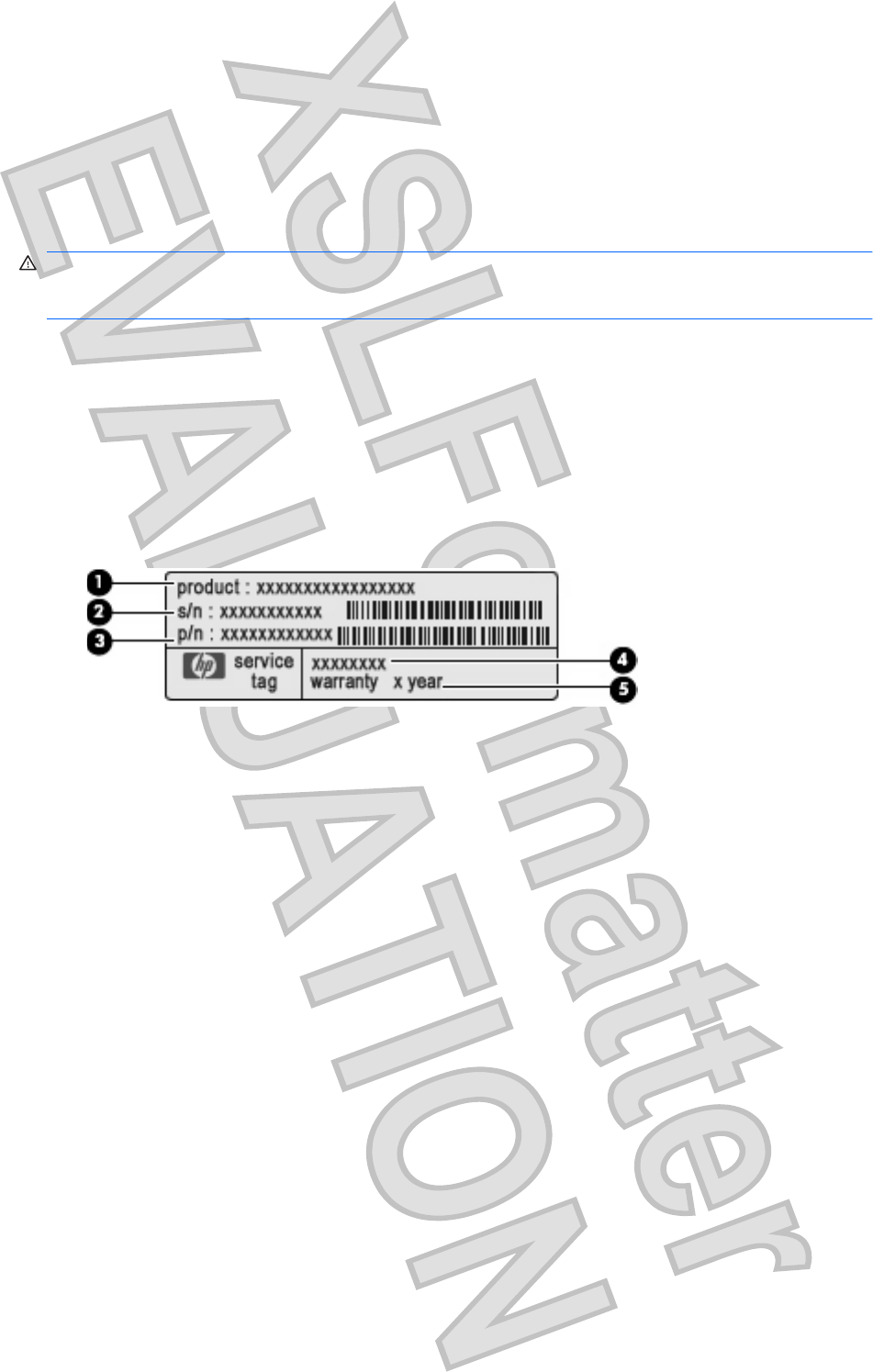
To remove smudges and lint, frequently clean the display with a soft, damp, lint-free cloth. If the screen
requires additional cleaning, use premoistened antistatic wipes or an antistatic screen cleaner.
Cleaning the TouchPad and keyboard
Dirt and grease on the TouchPad can cause the pointer to jump around on the screen. To avoid this,
clean the TouchPad with a damp cloth, and wash your hands frequently when using the computer.
WARNING! To reduce the risk of electric shock or damage to internal components, do not use a
vacuum cleaner attachment to clean the keyboard. A vacuum cleaner can deposit household debris on
the keyboard surface.
Clean the keyboard regularly to prevent keys from sticking and to remove dust, lint, and particles that
can become trapped beneath the keys. A can of compressed air with a straw extension can be used to
blow air around and under the keys to loosen and remove debris.
Labels
The labels affixed to the computer provide information you may need when you troubleshoot system
problems or travel internationally with the computer:
łService tag—Provides important information, including the following:
ŃProduct name (1). This is the product name affixed to the front of the computer.
ŃSerial number (s/n) (2). This is an alphanumeric identifier that is unique to each product.
ŃPart number/Product number (p/n) (3). This number provides specific information about the
product's hardware components. The part number helps a service technician to determine
what components and parts are needed.
ŃModel description (4). This is an alphanumeric identifier used to locate documents, drivers,
and support for the computer.
ŃWarranty period (5). This number describes the duration of the warranty period for the
computer.
Have this information available when you contact technical support. The service tag label is located
inside the battery bay.
łMicrosoft® Certificate of Authenticity—Contains the Windows Product Key. You may need the
Product Key to update or troubleshoot the operating system. The Microsoft Certificate of
Authenticity is located on the bottom of the computer.
łRegulatory label—Provides regulatory information about the computer. The regulatory label is
located on the bottom of the computer.
łWireless certification label(s)—Provide information about optional wireless devices and the
approval markings of some of the countries or regions in which the devices have been approved
for use. An optional device may be a wireless local area network (WLAN) device or an optional
Bluetooth® device. If your computer model includes one or more wireless devices, one or more
Labels 85
Antenna House XSL Formatter (Evaluation) http://www.antennahouse.com/

certification labels are included with your computer. You may need this information when traveling
internationally. Wireless certification labels are affixed to the bottom of the computer.
łSIM label (select models only)—Provides the ICCID (Integrated Circuit Card Identifier) of your SIM.
This label is located inside the battery bay.
łHP Mobile Broadband Module serial number label (select models only)—Provides the serial
number of your HP Mobile Broadband Module. This label is located inside the battery bay.
86 Appendix A Product information
Antenna House XSL Formatter (Evaluation) http://www.antennahouse.com/

B Troubleshooting
If you experience computer problems, perform these troubleshooting steps in the sequence provided
until the problem is resolved:
1. Refer to “Quick troubleshooting,” the next section in this appendix.
2. Access Web site links and additional information about the computer through Help and Support.
Click Start, and then click Help and Support.
3. Contact customer support. Refer to “Contacting customer support,” later in this appendix.
Quick troubleshooting
The computer is unable to start up
If the computer does not turn on when you slide the power switch, the following suggestions may help
you resolve the problem:
łIf the computer is plugged into an AC outlet, unplug the computer, and then plug another electrical
device into the outlet to be sure that the outlet is providing adequate power.
NOTE: Use only the AC adapter provided with the computer or one approved by HP for this
computer.
łIf the computer is running on battery power, or if it is plugged into an external power source other
than an AC outlet, plug the computer into an AC outlet using the AC adapter. Be sure that the power
cord and AC adapter connections are secure.
The TouchPad is behaving erratically
If the TouchPad is behaving erratically, follow these guidelines:
łBe sure that TouchPad is on. If the TouchPad light is amber, lightly press and hold the TouchPad
on/off button for 2 seconds to turn on the TouchPad. If the TouchPad light is off, the TouchPad is
on.
łFollow these guidelines when using the TouchPad:
ŃUse one finger to navigate, click, or turn on/turn off the TouchPad.
ŃUse 2 fingers to control TouchPad gestures, such as scrolling, pinching/zooming, and rotating.
NOTE: To turn the TouchPad gestures off or explore other TouchPad features, click the
Synaptics icon in the notification area at the far right of the taskbar, click the Device Settings tab,
and then click Settings.
The computer screen is blank
If the screen is blank, but the computer is on and the power light is on, the computer may not be set to
display the image on the computer screen. To transfer the image to the computer screen, press the
switch screen image key.
Quick troubleshooting 87
Antenna House XSL Formatter (Evaluation) http://www.antennahouse.com/
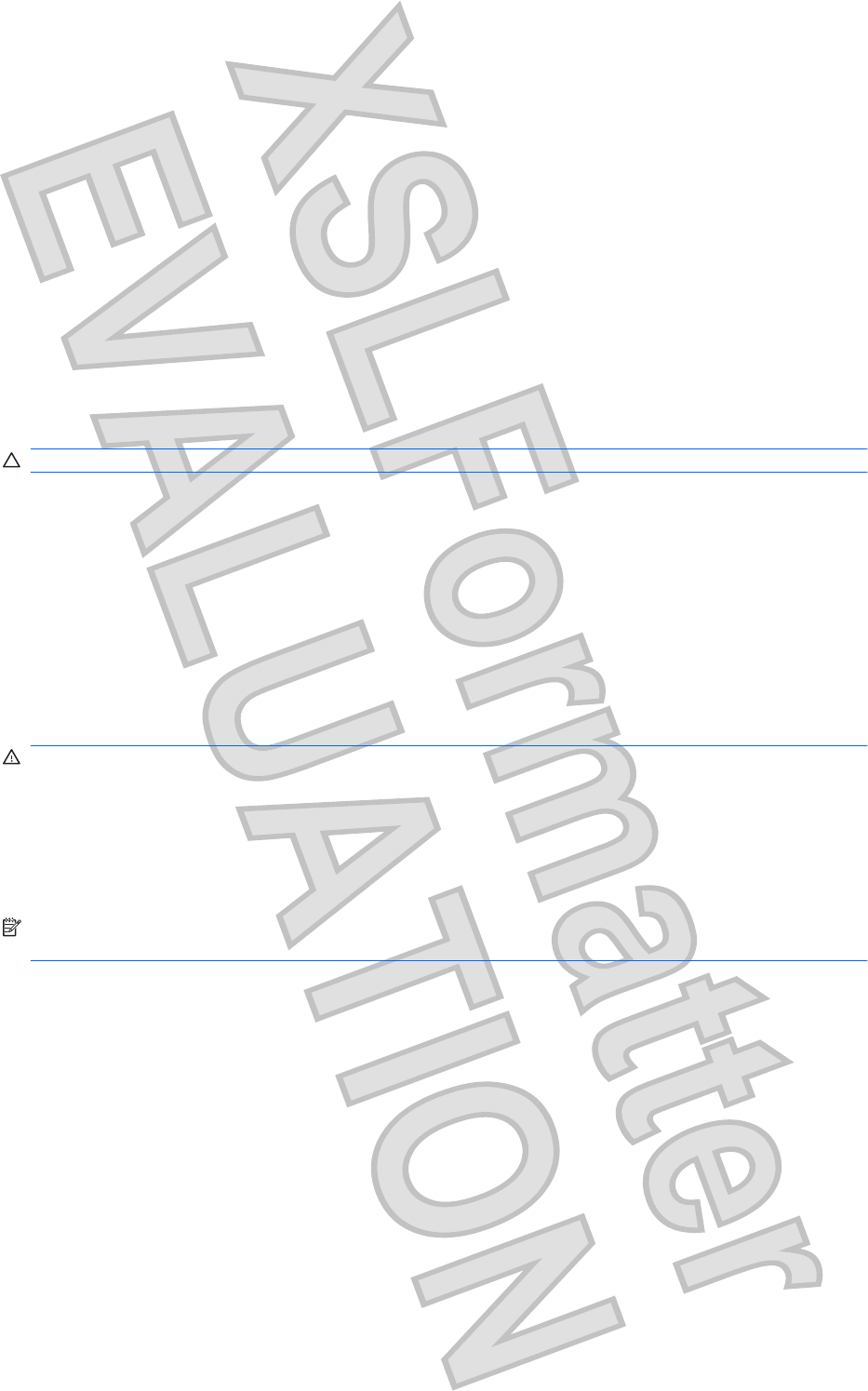
Software is functioning abnormally
If the software is unresponsive or responds abnormally, follow these suggestions:
łRestart the computer by clicking Start, clicking the arrow next to Shut down, and then clicking
Restart.
If you cannot restart the computer using this procedure, refer to the next section, “The computer
is on but is not responding.”
łRun a virus scan. For information about using the antivirus resources on the computer, refer to the
antivirus software Help for more details.
The computer is on but is not responding
If the computer is on but is not responding to software or keyboard commands, try the following
emergency shutdown procedures, in the sequence provided, until shutdown occurs:
CAUTION: Emergency shutdown procedures will result in the loss of unsaved information.
łSlide and hold the power switch on the computer for at least 5 seconds.
łDisconnect the computer from external power and remove the battery.
The computer is unusually warm
It is normal for the computer to feel warm to the touch while it is in use. But if the computer feels
unusually warm, it may be overheating because a vent is blocked.
If you suspect that the computer is overheating, turn off the computer to allow the computer to cool to
room temperature. Then be sure to keep all vents free from obstructions while you are using the
computer.
WARNING! To reduce the possibility of heat-related injuries or of overheating the computer, do not
place the computer directly on your lap or obstruct the computer air vents. Use the computer only on a
hard, flat surface. Do not allow another hard surface, such as an adjoining optional printer, or a soft
surface, such as pillows or rugs or clothing, to block airflow. Also, do not allow the AC adapter to contact
the skin or a soft surface, such as pillows or rugs or clothing, during operation. The computer and the
AC adapter comply with the user-accessible surface temperature limits defined by the International
Standard for Safety of Information Technology Equipment (IEC 60950).
NOTE: The fan in the computer starts up automatically to cool internal components and prevent
overheating. It is normal for the internal fan to cycle on and off during routine operation.
Checking your audio functions
To check the system sound on your computer, follow these steps:
1. Select Start > Control Panel.
2. Click Hardware and Sound.
3. Click Sound.
4. When the Sound window opens, click the Sounds tab. Under Program Events, select any sound
event, such as a beep or alarm, and click the Test button.
You should hear sound through the speakers or through connected headphones.
88 Appendix B Troubleshooting
Antenna House XSL Formatter (Evaluation) http://www.antennahouse.com/
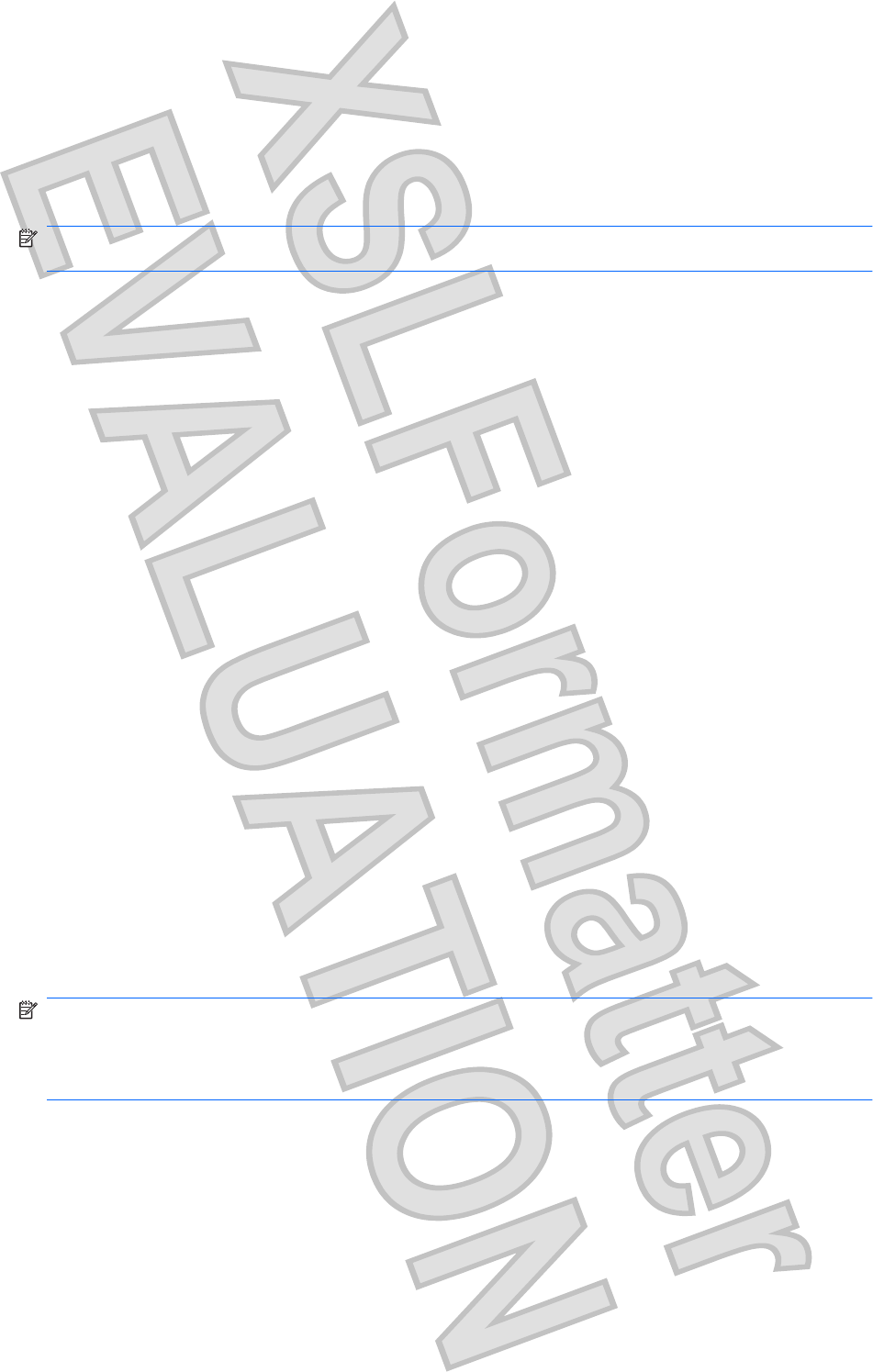
To check the record functions of the computer, follow these steps:
1. Select Start > All Programs > Accessories > Sound Recorder.
2. Click Start Recording and speak into the microphone. Save the file to your desktop.
3. Open Windows Media Player or MediaSmart and play back the sound.
NOTE: For best results when recording, speak directly into the microphone and record sound in a
setting free of background noise.
To confirm or change the audio settings on your computer, select Start > Control Panel > Hardware
and Sound > Sound.
An external device is not working
Follow these suggestions if an external device does not function as expected:
łTurn on the device according to the manufacturer’s instructions.
łBe sure that all device connections are secure.
łBe sure that the device is receiving electrical power.
łBe sure that the device, especially if it is older, is compatible with the operating system.
łBe sure that the correct drivers are installed and updated.
The wireless network connection is not working
If a wireless network connection is not working as expected, follow these suggestions:
łSelect Start > Control Panel > Network and Internet > Network and Sharing.
łBe sure that the wireless device is turned on (wireless light is off). If the light is amber, press the
wireless key to turn on the wireless device.
łBe sure that the computer wireless antennas are free from obstructions.
łBe sure that the cable or DSL modem and its power cord are properly connected and that the lights
are on.
łBe sure that the wireless router or access point is properly connected to its power adapter and the
cable or DSL modem, and that the lights are on.
łTurn the wireless device off and then on again to resynchronize the device.
łDisconnect and then reconnect all cables, and turn the power off and then back on.
NOTE: For more information on wireless technology, refer to the relevant help topics and Web site
links in Help and Support.
NOTE: For information on activating mobile broadband service, refer to the mobile network operator
information included with your computer.
Quick troubleshooting 89
Antenna House XSL Formatter (Evaluation) http://www.antennahouse.com/
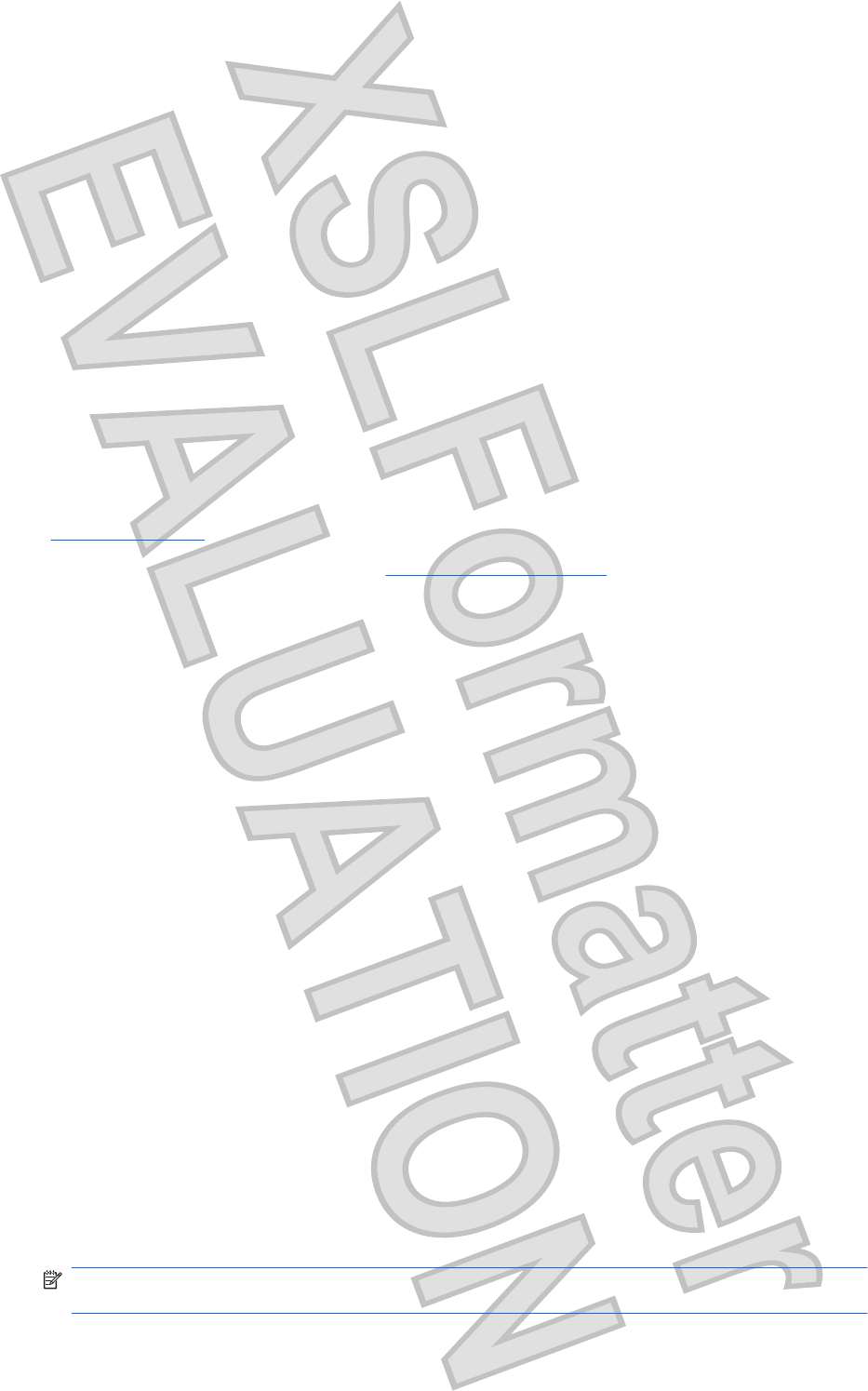
Cannot connect to a preferred network
Windows can automatically repair a corrupted WLAN connection:
łIf there is a network icon in the notification area, at the far right of the taskbar, right-click the icon,
and then click Diagnose and repair from the menu.
Windows resets your network device and attempts to reconnect to one of the preferred networks.
łIf there is no network icon in the notification area, follow these steps:
1. Select Start > Control Panel > Network and Internet > Network and Sharing Center.
2. Click Troubleshoot problems and select the network you wish to repair.
Network icon for WLAN is not displayed
If the network icon is not displayed in the notification area after you configure the WLAN, the software
driver is either missing or corrupted. A Windows “Device not Found” error message may also be
displayed. The driver must be reinstalled.
Get the latest version of the WLAN device software and drivers for your computer from the HP Web site
at http://www.hp.com:
1. Open your Internet browser and go to http://www.hp.com/support.
2. Select your country or region.
3. Click the option for software and driver downloads, and then type your computer model number in
the search box.
4. Press enter, and then follow the on-screen instructions.
Current WLAN network security codes are unavailable
If you are prompted for a network key or a name (SSID) when connecting to a WLAN, the network is
protected by security. You must have the current codes to make a connection on a secure network. The
SSID and network key are alphanumeric codes that you enter into your computer to identify your
computer to the network.
łFor a network connected to your personal wireless router, review the router user guide for
instructions on setting up the same codes on both the router and the WLAN device.
łFor a private network, such as a network in an office or at a public Internet chat room, contact the
network administrator to obtain the codes, and then enter the codes when prompted to do so.
Some networks change the SSID or network keys used in their routers or access points on a regular
basis to improve security. You must change the corresponding code in your computer accordingly.
If you are provided with new wireless network keys and SSID for a network, and if you have previously
connected to that network, follow the steps below to connect to the network:
1. Select Start > Control Panel > Network and Internet > Network and Sharing Center.
2. Click Manage wireless networks in the left panel.
A list showing the available WLANs is displayed. If you are in a hotspot where several WLANs are
active, several will be displayed.
3. Select the network in the list, right-click the network, and then click Properties.
NOTE: If the network you want is not listed, check with the network administrator to be sure that
the router or access point is operating.
90 Appendix B Troubleshooting
Antenna House XSL Formatter (Evaluation) http://www.antennahouse.com/

4. Click the Security tab and enter the correct wireless encryption data into the Network security
key box.
5. Click OK to save these settings.
WLAN connection is very weak
If the connection is very weak, or if your computer cannot make a connection to a WLAN, minimize
interference from other devices, as follows:
łMove your computer closer to the wireless router or access point.
łTemporarily disconnect devices such as a microwave, cordless phone, or cellular phone to be sure
that other wireless devices are not interfering.
If the connection does not improve, try forcing the device to reestablish all connection values:
1. Select Start > Control Panel > Network and Internet > Network and Sharing Center.
2. Click Manage wireless networks in the left pane.
A list showing the available WLANs is displayed. If you are in a hotspot where several WLANs are
active, several will be displayed.
3. Click a network, and then click Remove.
Cannot connect to the wireless router
If you are trying to connect to the wireless router and are unsuccessful, reset the wireless router by
removing power from the router for 10 to 15 seconds.
If the computer still cannot make a connection to a WLAN, restart the wireless router. For details, refer
to the router manufacturer's instructions.
Contacting customer support
If the information provided in this guide or Help and Support does not address your questions, you can
contact HP Customer Support at http://www.hp.com/go/contactHP.
Here you can:
łChat online with an HP technician.
NOTE: When technical support chat is not available in a particular language, it is available in
English.
łE-mail HP Customer Support.
łFind HP Customer Support worldwide telephone numbers.
łLocate an HP service center.
Contacting customer support 91
Antenna House XSL Formatter (Evaluation) http://www.antennahouse.com/
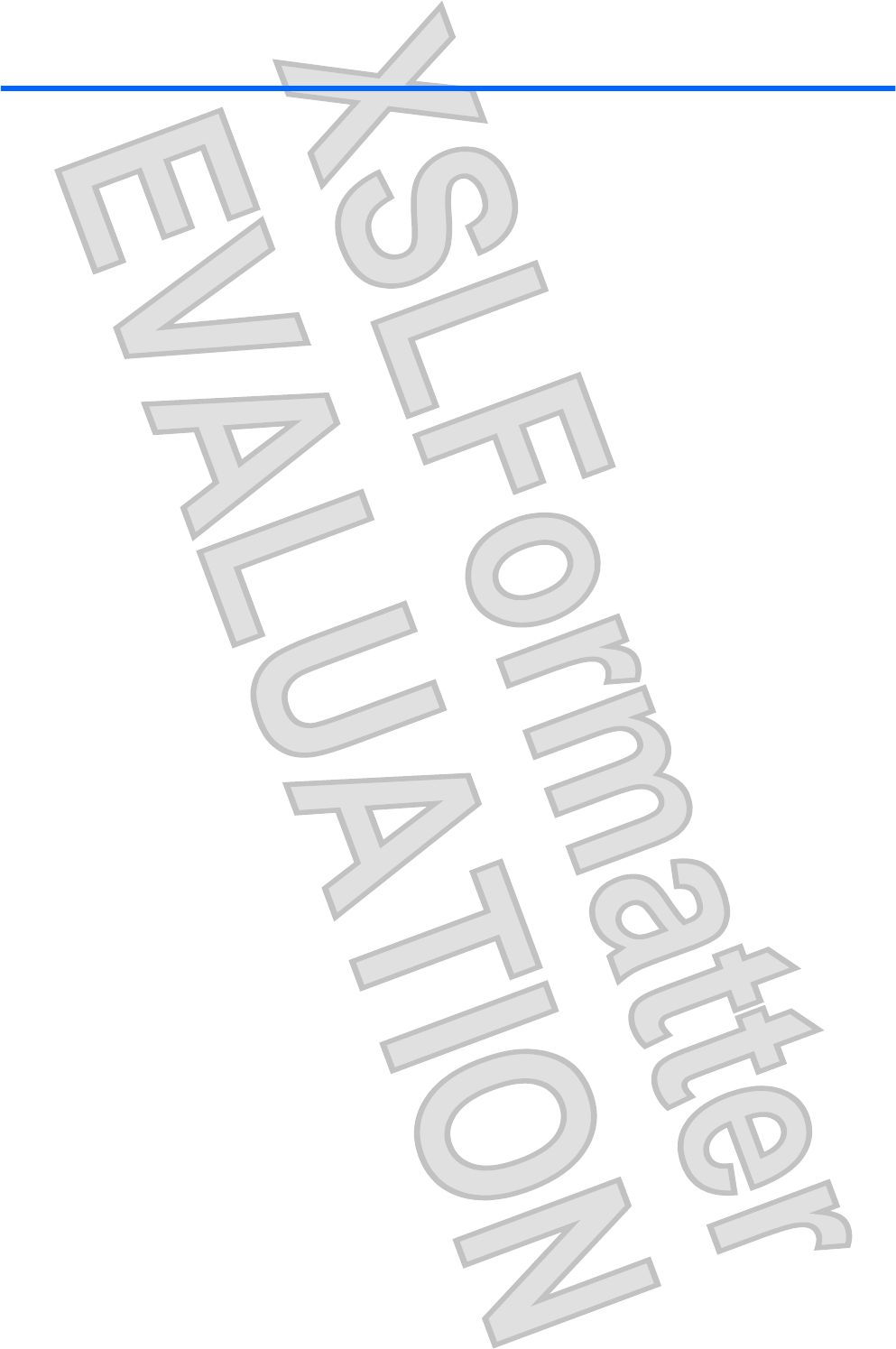
Index
A
AC adapter
testing 51
AC power, connecting 50
action key mode 80
action keys
adjusting volume 33
audio CD, DVD, or BD
controls 33
decrease screen
brightness 33
Help and Support 32
identifying 10
increase screen brightness 33
muting speaker sound 33
switching screen image 33
using 32
volume 37
wireless 17, 33
administrator password
creating 68
entering 68
managing 68
airport security devices 55
antivirus software, using 69
audio devices, connecting
external 38
audio functions, checking 88
audio-in (microphone) jack,
identifying 12
audio-out (headphone) jack,
identifying 12
B
backing up
customized window, toolbar,
and menu bar settings 74
personal files 74
templates 74
battery
calibrating 49
charging 47
conserving power 44
discharging 48
disposing 50
inserting 46
low battery levels 48
removing 46
replacing 50
storing 49
battery bay 85
battery bay, identifying 14
Battery Check 46
battery light 12, 47
battery power 45
battery release latch 14, 46
battery temperature 49
bays
battery 85
BD drive 60
BIOS, updating 80
Bluetooth device 16
Bluetooth label 86
Bluetooth wireless devices 24
boot options 80
boot order 80
buttons
left TouchPad 8
right TouchPad 8
rotate 11
TouchPad on/off 8
wireless 11
C
cables
USB 54
calibrating battery 49
caps lock light, identifying 9
CD drive 60
Certificate of Authenticity label 85
charging batteries 47
checking audio functions 88
cleaning, TouchPad and
keyboard 85
clicks
changing settings 32
testing 32
components
bottom 14
display 13
front 10
left-side 12
right-side 11
top 8
computer
traveling 84
configuring HDMI 41
Connect to the Internet
Wizard 15, 16
connection, external power 51
connector, power 12
conservation, power 44
convertible hinge, identifying 13
critical battery level 42, 48
critical security updates,
installing 70
customer support, contacting 91
D
default settings, restoring 78
Diagnostics menu 80
digital card
inserting 52
removing 53
supported formats 52
Digital Media Slot, identifying 12
Disk Cleanup software 56
Disk Defragmenter software 55
diskette drive 60
display
cleaning 84
display image, switching 33
drive light 56
drive light, identifying 9
drive media 43
drives
boot order 80
connecting external 60
diskette 60
external 60
handling 55
92 Index
Antenna House XSL Formatter (Evaluation) http://www.antennahouse.com/

hard 58, 59, 60
optical 60
DVD drive 60
E
encryption 21
End hotkey 34
entering a power-on
password 69
entering an administrator
password 68
esc key, identifying 10
external audio devices,
connecting 38
external drive 60
external monitor port 40
external optical drive 37
external WWAN antenna,
identifying 10
F
f11 76
fan always on 79
fingerprint reader
identifying 11
fingerprints, registering 71
firewall software 21, 69
flicks
changing assignments 32
creating assignments 32
fn key, identifying 10, 33
full system recovery 73
H
hard disk drive
external 60
installing 59
removing 58
hard drive
external 60
HP ProtectSmart Hard Drive
Protection 56
installing 59
removing 58
hard drive bay, identifying 14
HDMI
configuring 41
connecting 40
HDMI port, identifying 12, 40
headphone (audio-out) jack 12
Help and Support key 32
Hibernation
exiting 43
initiated during critical battery
level 48
initiating 43
high-definition devices,
connecting 40
hinge, identifying 13
Home hotkey 34
hotkeys
description 33
display system information 34
End 34
Home 34
page down 34
page up 34
using 34
HP Mobile Broadband Module 22
HP ProtectSmart Hard Drive
Protection 56
HP USB Ethernet Adapter
connecting 25
hubs 53
I
icons
network 16, 90
wireless 16
input power 83
Instant Web
disabling 7
enabling 7
starting 6
using 6
instant Web
starting Windows 6
integrated webcam light,
identifying 13
interference, minimizing 91
internal microphones,
identifying 13
Internet
choosing an ISP 15
Internet connection setup 19
Internet Service & Offers 15
Internet Service Provider
(ISP) 15
J
jacks
audio-in (microphone) 12
audio-out (headphone) 12
K
keyboard hotkeys, identifying 33
keyboard, cleaning 85
keys
action 10
esc 10
fn 10
mute 37
Windows application 10
Windows logo 10
L
labels
Bluetooth 86
Microsoft Certificate of
Authenticity 85
regulatory 85
service tag 85
wireless certification 86
WLAN 86
language support 79
latch, battery release 14
lights
battery 12
caps lock 9
drive 9, 56
mute 9
power 11
TouchPad 9
webcam 13
wireless 9, 11
local area network (LAN)
cable required 25
connecting cable 25
low battery level 48
M
Main menu 79
maintenance
Disk Cleanup 56
Disk Defragmenter 55
managing a power-on
password 69
managing an administrator
password 68
media activity keys 35
Index 93
Antenna House XSL Formatter (Evaluation) http://www.antennahouse.com/

media controls, keys 33
MediaSmart
using 36
MediaSmart software 36
memory module
inserting 64
removing 64
memory module compartment
cover
removing 63
replacing 65
memory module compartment,
identifying 14
memory test 80
microphone (audio-in) jack,
identifying 12
Microsoft Certificate of Authenticity
label 85
minimizing interference 91
monitor, connecting 40
mouse, external
setting preferences 26
multimedia software
installing 37
using 36
mute key
identifying 33
using 37
mute light, identifying 9
N
network cable, connecting 25
network icon 16, 90
network key 90
network security codes
network key 90
SSID 90
O
operating environment 83
operating system
Microsoft Certificate of
Authenticity label 85
Product Key 85
optical drive
external 37
sharing 37, 61
optical drive, external 60
P
page down hotkey 34
page up hotkey 34
passwords
administrator 68
power-on 68
set in Setup Utility 67
set in Windows 67
pen
identifying 28
storing 28
using 28
pen holder 28
pen holder, identifying 13
pen tether eyelet 28
pinching TouchPad gesture 27,
31
pointing devices
setting preferences 26
ports
external monitor 40
HDMI 12, 40
USB 12, 53
power
connecting 51
conserving 44
power connector, identifying 12
power light, identifying 11
power switch, identifying 11
power-on password
creating 69
entering 69
managing 69
primary hard disk self test 80
Product Key 85
product name and number,
computer 85
programs, using 36
projector, connecting 40
Q
quick troubleshooting 87
R
readable media 43
recovering a program or driver 73
recovering from the dedicated
recovery partition 76
recovering from the recovery
discs 76
recovery discs 73
recovery discs, creating 4
Recovery Manager 73, 76
recovery partition 73
recovery, system 76
regulatory information
regulatory label 85
wireless certification labels 86
restore points 75
rotate button, identifying 11
rotating TouchPad gesture 27,
30
routine care 84
S
screen brightness keys 33
screen image, switching 33
scrolling TouchPad gesture 26,
30
security cable slot, identifying 13
security cable, installing 70
Security menu 79
security, wireless 21
serial number, computer 85
service tag 85
setup of WLAN 19
Setup Utility
changing the language 77
displaying system
information 78
exiting 79
menus 79
navigating 78
passwords set in 67
restoring default settings 78
selecting 78
starting 77
shared drives 61
shutdown 42
SIM
inserting 22
removing 23
Sleep
exiting 43
initiating 43
slots
Digital Media 12
memory 63
security cable 13
software
Disk Cleanup 56
Disk Defragmenter 55
94 Index
Antenna House XSL Formatter (Evaluation) http://www.antennahouse.com/

MediaSmart 36
TouchSmart 36
using 36
Wireless Assistant 18
solid-state drive (SSD) 73, 76
speakers, identifying 13
storing battery 49
supported discs 73
switch
power 11
System Configuration menu 79
system failure or instability 73
system information hotkey 34
system information,
displaying 78, 79
system recovery 76
system restore points 73, 75
T
temperature 49
touch screen
performing screen actions 29
preferences 32
using 29
TouchPad
buttons 8
cleaning 85
gestures 26
identifying 8
using 26
TouchPad gestures
pinching 27, 31
rotating 27, 30
scrolling 26, 30
zooming 27, 31
TouchPad light, identifying 9
TouchPad on/off button 8
TouchSmart
starting 36
using 36
TouchSmart software 36
traveling with the computer 49,
84, 86
troubleshooting
computer is unable to start
up 87
computer screen is blank 87
TouchPad 87
turning off the computer 42
U
unresponsive system 42
USB cable, connecting 54
USB devices
connecting 53
description 53
removing 54
USB hubs 53
USB port, identifying 12
USB ports, identifying 12, 53
using system restore 75
V
vents, identifying 10, 12, 14
Virtualization Technology 79
volume
adjust 37
keys 37
mute 37
volume keys, identifying 33
W
webcam
adjusting properties 39
identifying 13
webcam light, identifying 13
Windows application key,
identifying 10
Windows Connect to the Internet
Wizard 16
Windows logo key, identifying 10
Windows, passwords set in 67
wireless
protecting 21
set up 19
wireless antennas, identifying 13
Wireless Assistant software 16,
18
wireless button, identifying 11
wireless certification label 86
wireless controls
key 16
operating system 16
Wireless Assistant
software 16
wireless icon 16
wireless key
identifying 33
using 16, 17
wireless light 9, 11, 16
wireless network (WLAN)
equipment needed 19
security 21
WLAN antennas, identifying 13
WLAN device 86
WLAN label 86
writable media 43
WWAN antennas, identifying 13
WWAN device 21
Z
zooming TouchPad gesture 27,
31
Index 95
Antenna House XSL Formatter (Evaluation) http://www.antennahouse.com/

Antenna House XSL Formatter (Evaluation) http://www.antennahouse.com/